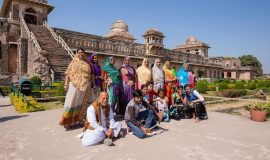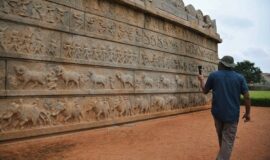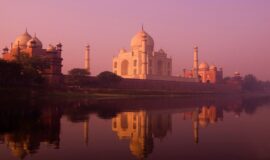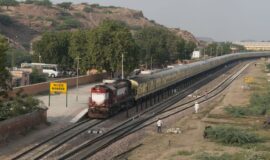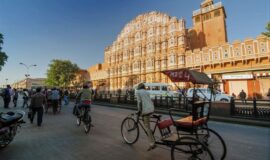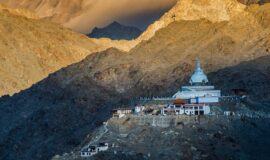Old and New Delhi Tour and Travel Guide 2023
Heritage of Delhi
Tughlaqabad Fort
Nizamuddin
Hauz Khas Village
Mehrauli Archeological Park
FOOD TO INDULGE IN DELHI
Interesting fact
Paharganj, a Different World
SHOPPING SPREE IN DELHI
How to get there
Some Images From Our Trip To Delhi
Symbolically this city should be compared to a seven-course meal rather than one single dish. It is a blend of flavors, a delightful spread of tastes. Do not seek for a single defining characteristic in the city. Its diversity of culture, lifestyles, and cuisine cannot be reduced to a single word. To try and find a single label to describe Delhi will do it an immense injustice. For 1000 years this city has burned down and was built up repeatedly. From the ashes, new buildings arose and within their walls, the residue and remnants of the past reside.
Therefore the visitor’s quest should be to find the city’s hidden nature, the Delhiite within its walls. People residing in Delhi proudly call themselves Delhiites. The name is associated with honor and satisfaction, and rightfully so. Those residents who adapt to the fast-changing culture are delightfully embraced as fellow Dilliwalas, a term residents normally use to refer to themselves. It comes from the phrase ‘Dillwalo ki Dilli’ which translates to ‘the place where people with big hearts live’.
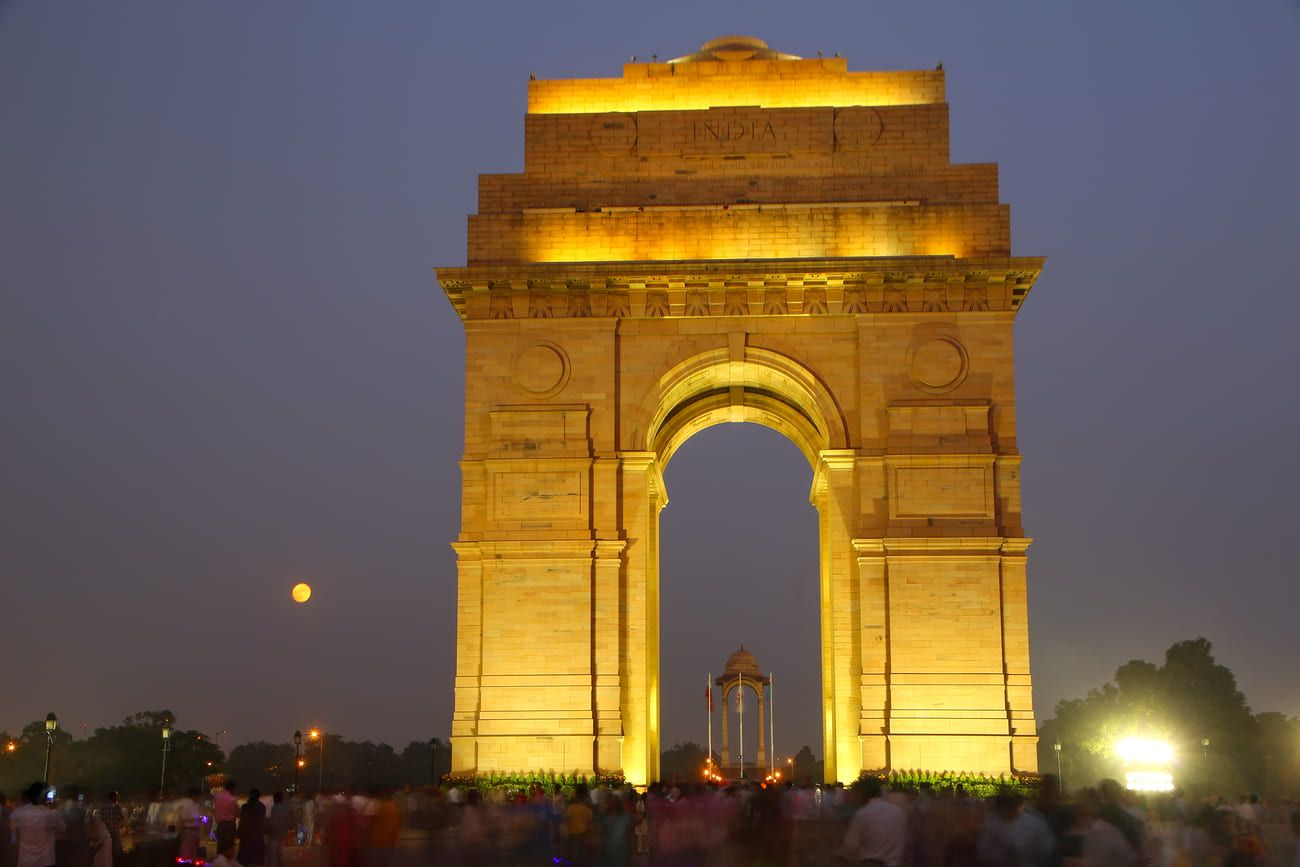
India Gate at early evening. The Gate is a memorial to the 82,000 soldiers of the united British Indian Army who died during 1914 – 1921 © Don Mammoser
People from out of town erroneously consider all residents of Delhi of the same species, but Indian literature clearly shows the varied types of Delhiites. You will find the sophisticated member of the elite class who resides in Lutyens, an aficionado of gymkhanas. Then there is the Sarkari, a middle-class man who stems from a village, who does not really adapt to life in the city but allows it to bend to his will. This man finds himself portrayed in many a Bollywood satire. New-age Delhiites are easily recognized by their oversized muscles, short tempers, and neat, well-groomed beards. The list goes on, so it is evident that Delhi’s charm lies in the ambiguous rather in the defined.
Delhi is also known to be the political hub of India, with all the political acts tying their history to this city. India, the largest democracy in the entire world, attributes its democratic prowess to Delhi, the capital city, which hosts embassies of more than 160 nations. Delhi is also recognized for its demographic composition and is listed among the most populous cities in the world, boasting a population of 24 million people. This high count has its downside, however, Delhi can be loosely referred to as a ‘Mecca of Liveliness’. It sits on a whopping 1483 sq. kilometers. The city has satellite towns like Gurgaon, Faridabad, Noida, and Greater Noida on its periphery, which are well connected by a world-class metro network. These towns make up the Delhi region known as the National Capital Region (NCR). This was necessitated by the need to create room for the rapid growth and development of Delhi.
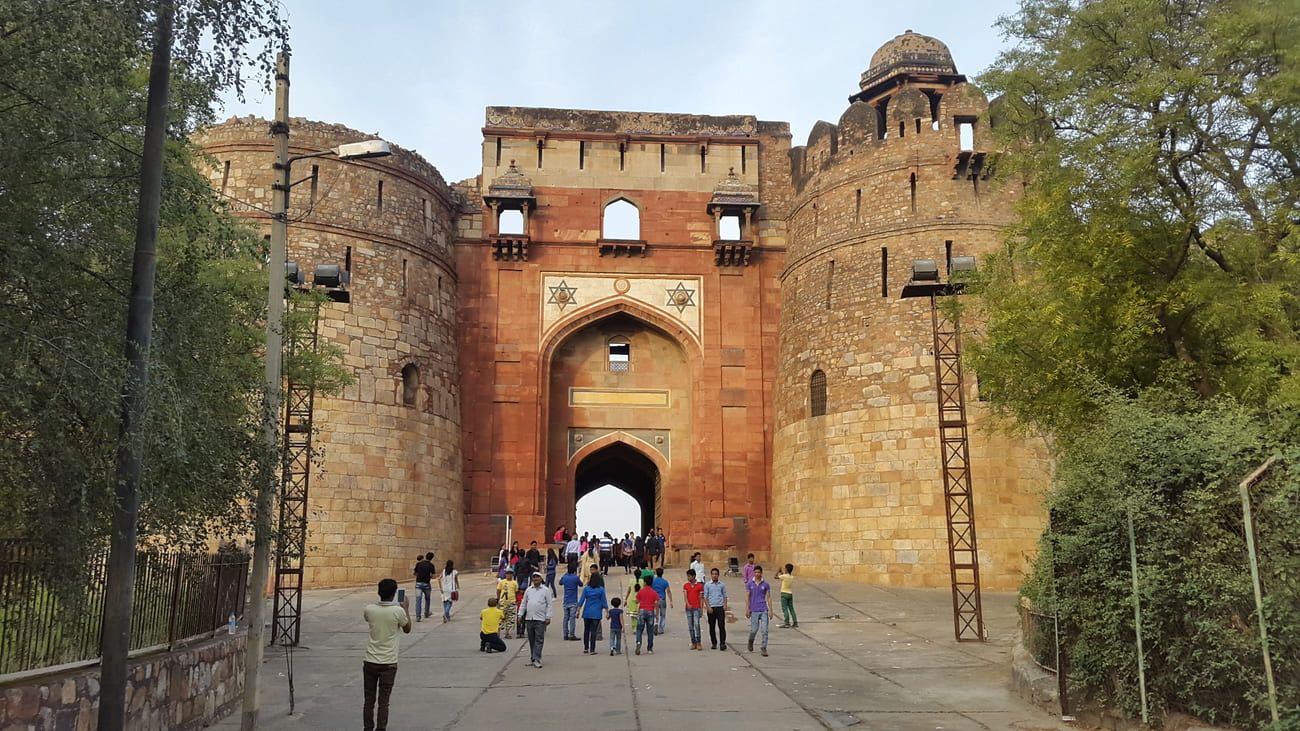
It is common to find old monuments strewn across public places and parks in Delhi. In the picture the grand entrance of Purana Quila in New Delhi can be seen © Picture
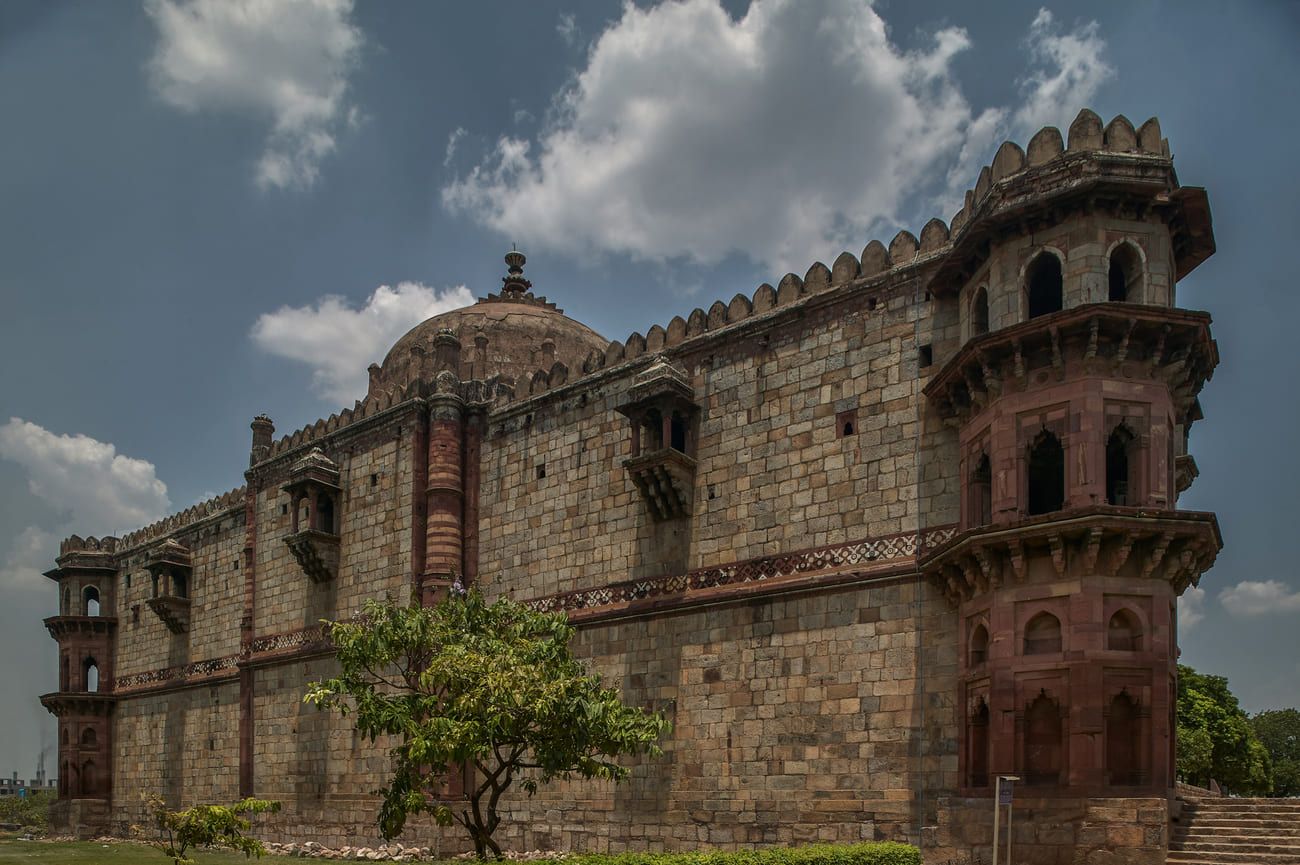
Rearview of the Qila Kuhna Masjid (Mosque) inside the Purana Qila (the Old Fort) in Delhi, India © Anil D
Delhi did not start off as the capital of India. According to legend it raised from the site Indraprastha of the epic Mahabharata. This claim is however refuted by evidence that settlements from which the city evolved, date back to five hundred years later than the epic’s timeline.
From an archaeological survey study, it was determined that Delhi acted as the capital of the seven empires from India’s past and has well over 60,000 famous monuments built over the millennia. Last in line was modern-day New Delhi, established by the British. Qutab Minar, a World Heritage Site in the Mehrauli area is the location for a series of monuments that represent erstwhile four capital sites, while Firozabad, the 5th, was located where Feroz Shah Kotla can be seen today. Sher Shah Suri, the emperor of the time, reconstructed the 6th at Purana Qila. Shah Jahan is best known for the Taj Mahal, his great architectural homage to love, but actually, his most important achievement was to move his Mughal capital Shahjahanabad to Delhi during the 1600s. From that time until it was seized from Bahadur Shah Zafar in 1857 by the Brits for taking the side of the mutineers, Delhi served as the heart of the Mughal Empire. Finally, in 1911, the seat of British power was moved from Kolkata to New Delhi and the famous Lutyen’s New Delhi emerged, which comprises of the President Palace, the Parliament and Connaught Place.
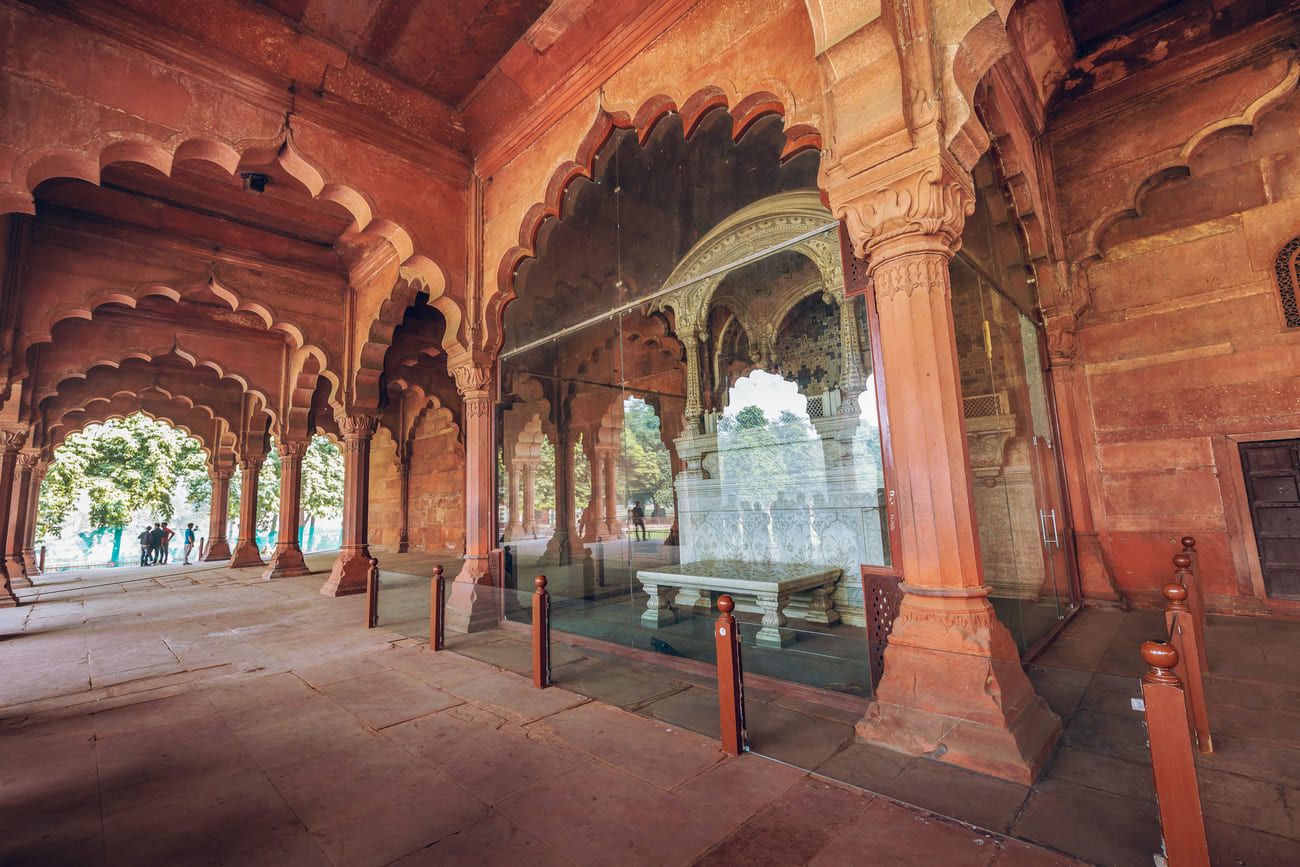
The medieval Mughal throne in a glass casing at the Red Fort (Diwan-i-Aam), also known as the Public Audience Hall, in Delhi, India © Roop_Dey
Heritage of Delhi
Delhi has witnessed dynasties rise, bloom, and set in its land. Delhi’s rich diversity of architectural styles stem from the many eras it lived through. Although diversity is characteristic of many cities that underwent sieges and served as centers for empires, Delhi can boast the best preserved and most prevalent examples. The reason for this is because successive rulers often referred to erect their own monuments and simply abandoned the existing ones.
Old and New Delhi are abundantly endowed with sight-seeing areas that will satisfy just about anyone with a hunger to explore. Historical monuments from a rich past, temples with cutting edge architecture such as razor sharped carved walls, and numerous interesting historical sites that show their architects’ creative souls, demonstrate Delhi’s historic relevance. The city hosts a number of monuments, forts, temples, cenotaphs and mausoleums, and gateways. Every single work of architecture speaks volumes about the rich and eminent past of the city. All this makes the city a favorite tourist destination.
The creation of the Mughal Emperor Shah Jahan’s famous walled city is Delhi’s center of attraction for both local people and foreigners. Creations of a similar architectural style can be seen in the Taj Mahal which is located 240km south of Delhi in Agra, and also the Red Fort that was constructed in 1639 as a home for the Mughal Dynasty emperors. Delhi also has temples and green spaces like the 100-acre Akshardham complex with a 42m-high mandir or Hindu Temple, Chattarpur Temple Complex, and the 90-acre Lodhi Gardens in the heart of the city. One of the best ways to explore Delhi’s rich culture, art, and history is to explore its many museums. The National Museum, National Crafts Museum, National Rail Museum, Gandhi Smriti, and National Gallery of Modern Art are some of the best-preserved museums in Delhi.
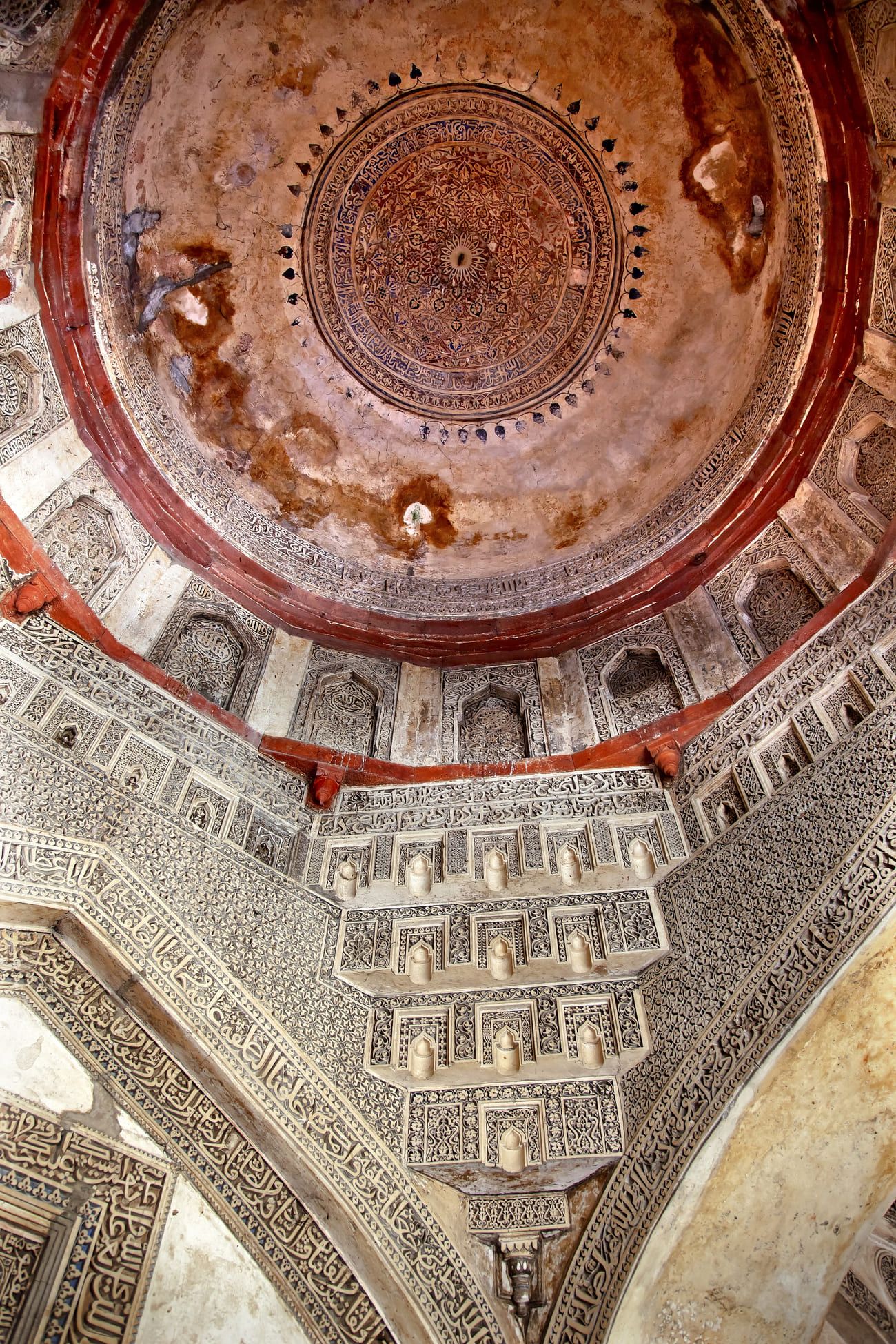
The richly decorated ancient dome inside the huge Sheesh Shish Gumbad Tomb at Lodi Gardens in New Delhi, India © William Perry
Tughlaqabad Fort
When Ghiyasuddin Tughlaq, the architect of the dynasty of Tughlaq expelled the Khiljis from their land, he dictated that all able-bodied workers should commence with the erection of a fort. This meant that all labor was diverted from Hazrat Nizamuddin’s stepwell (baoli). In his anger, the Sufi saint placed a curse on the fort, uttering the legendary words, “Ya rahe’ ujjar, ya basy Gujjar.” (You shall remain uninhabited, or you will be populated by Gujjars.) In an irrational move, Muhammad Bin, the king’s son, moved the capital to Daulatabad. It was futile and so was the emperor’s rule. It seems the curse did its trick and the fort was never inhabited, not even when the Tughlaq Dynasty came to an end. Only after the British seized Delhi did the fort come alive.
The complex stretches over a vast area, perfect for the visitor who loves exploring and prefers open spaces. Free from any guides, bothersome hawkers, or photographers, this is a peaceful site from where visitors can enjoy beautiful views of the city spread out around it, their only companions a few lovers pitching their tents along the fort walls, or an early morning jogger making is way along the ramparts.
How to get there
The hike from the metro station at Tughlaqabad is long and to find transport in this area might be difficult, so hire your own day-taxi.
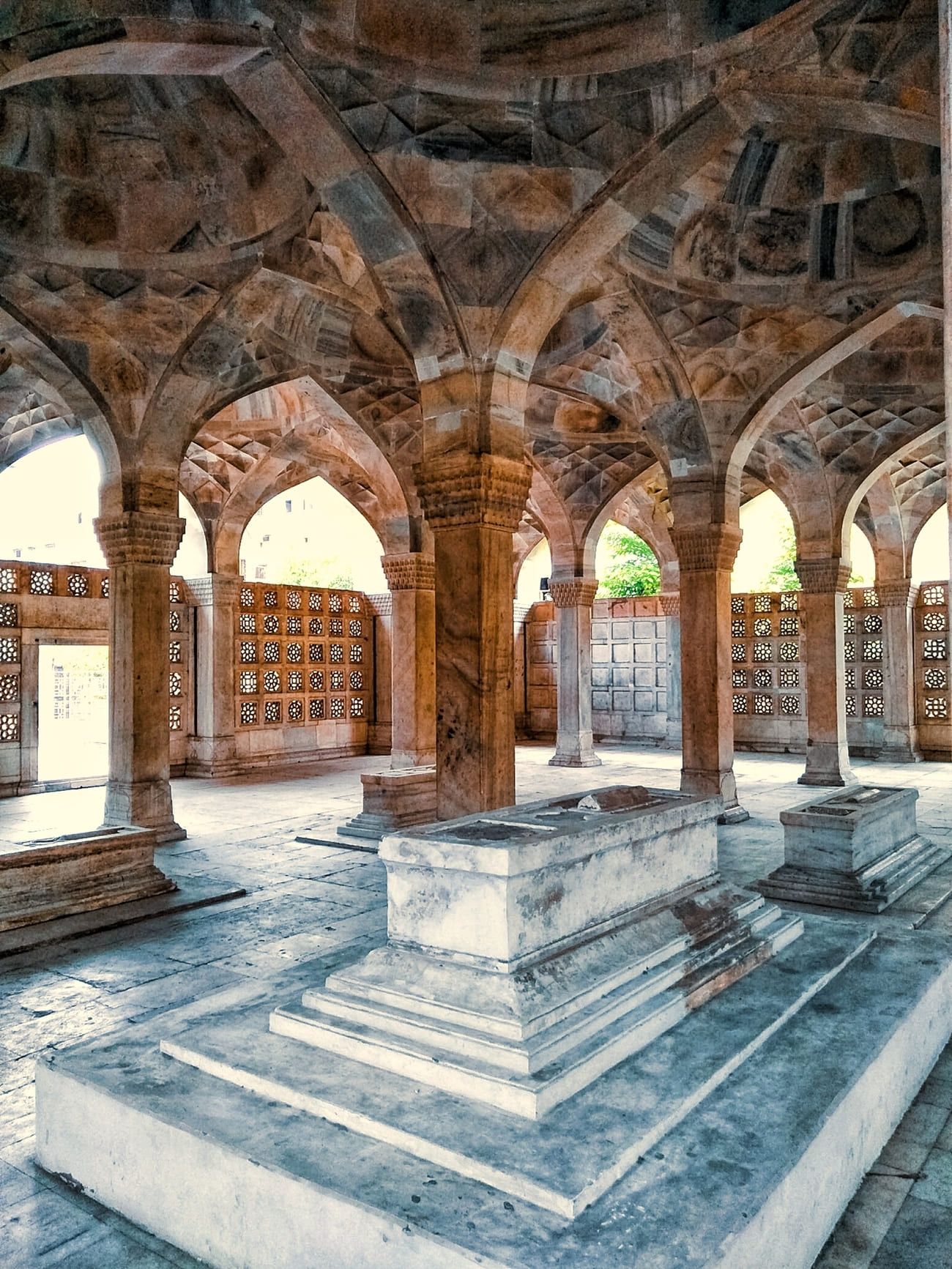
The Chausath Khamba, a mausoleum built by Mirza Aziz Koka for himself, New Delhi © Sukhmani Sangha
Nizamuddin
Chandni Chowk is the representation of ancient culture in Delhi, Nizamuddin is its Sufi nerve center. The area where the complex is situated forms the nerve center of India’s Sufi culture and is named after its legendary Saint Hazrat Nizamuddin Auliya. The dargah, his shrine, draws hundreds of pilgrims daily and can become extremely crowded, so take a wide berth if you are not one for large crowds. Devotional Sufi music sessions, or qawwali, are held here right after maghrib prayers on Thursdays. There are many other attractions like Humayun, the second emperor of the Mughal Empire’s tomb, the Sunder Nursery, the tomb of the Urdu and Persian poet Mirza Ghalib, Chausath Khamba with its impressive 64 pillars, and octagonal Sabz Burj in Mathura Road.
How to get there
Jangpura is the closest metro station and it can be reached by tuk-tuk or bus. Uber or Ola is also available.
Do not miss the Thursday qawwali recitals, is an enlightening musical experience.
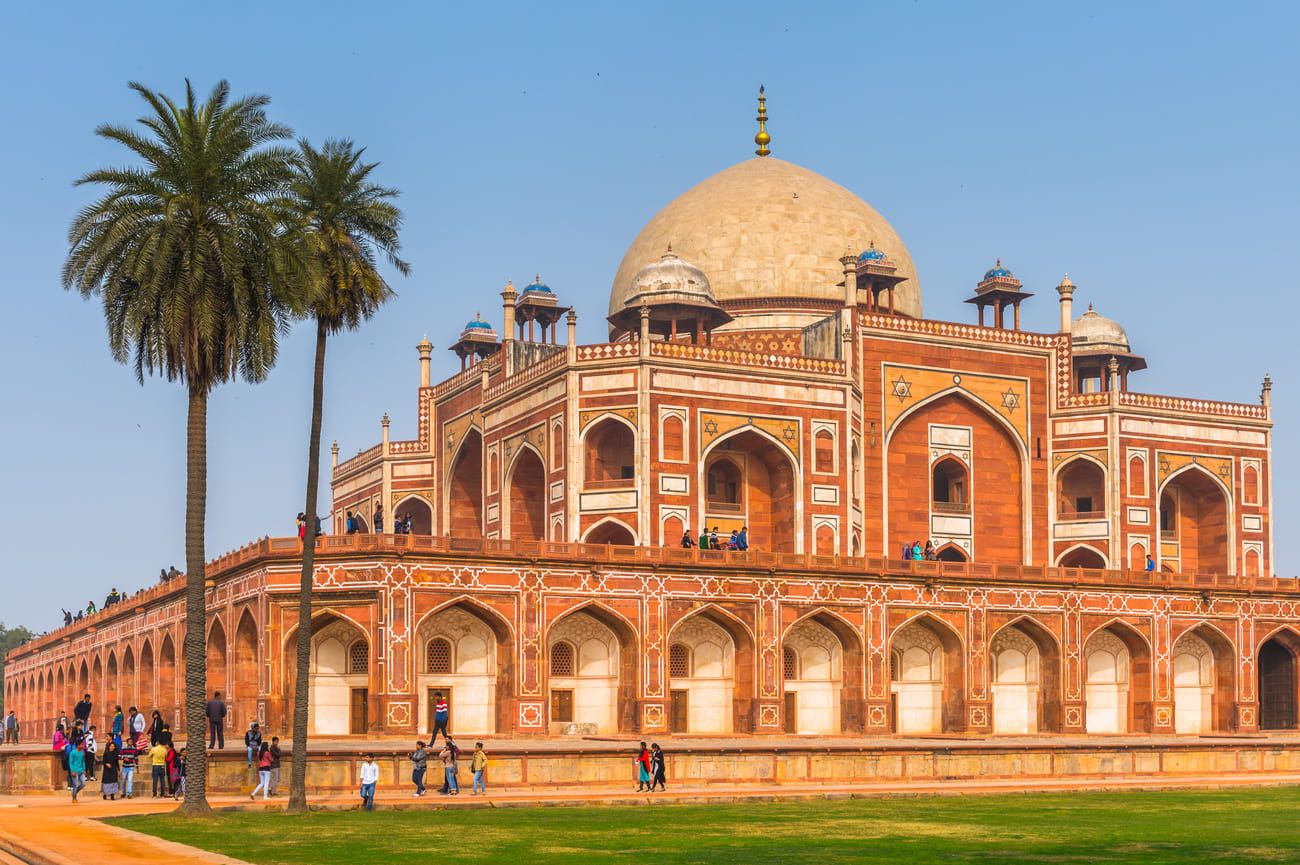
One of the main attractions in the vicinity of Nizamuddin is the tomb of the Mughal emperor Humayun (UNESCO Site), commissioned by his first wife © Anton_Ivanov
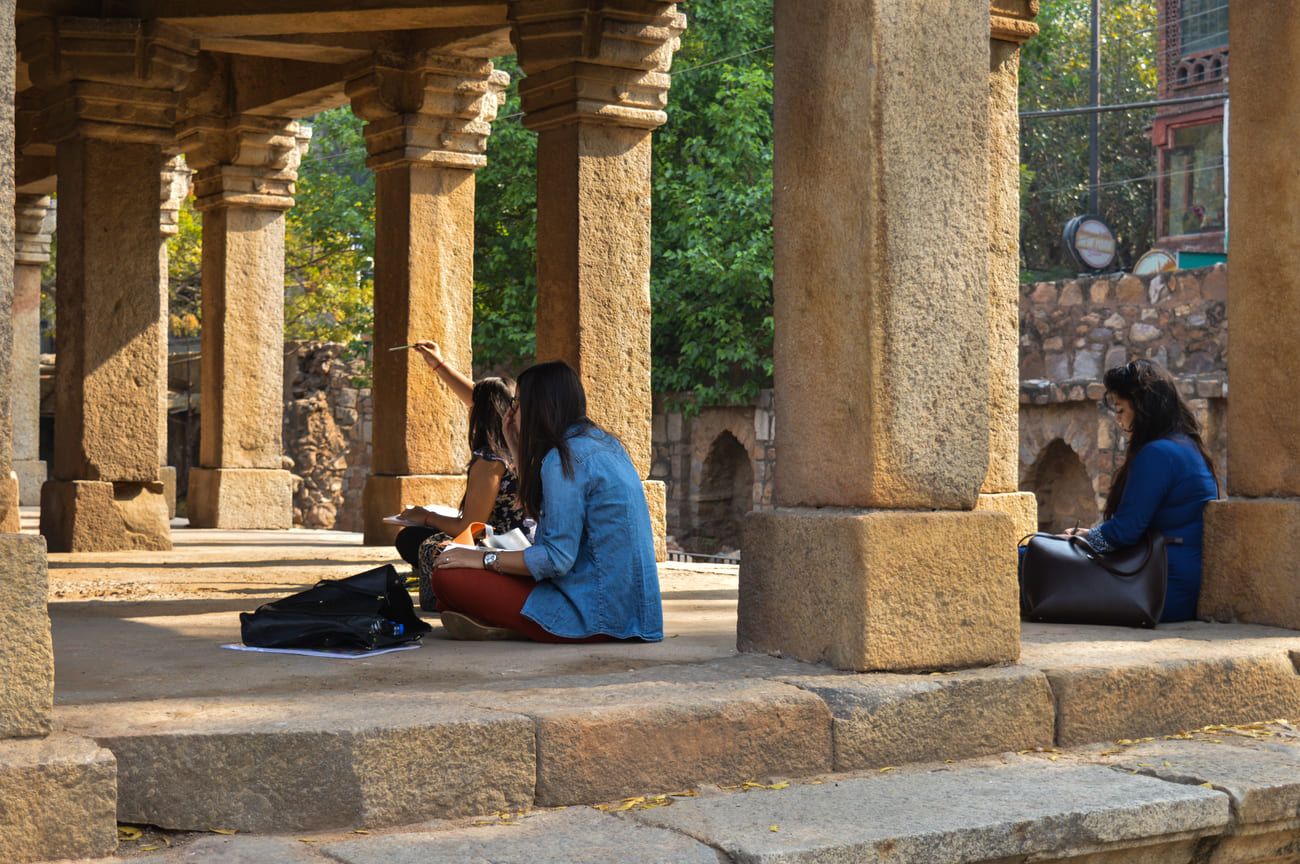
The Hauz Khas complex is a favorite with the young people of Delhi; they like to meet here amongst the ruins and beside the ancient water tank © ShyamSingh
Hauz Khas Village
This complex, dating from the 1300s, lies in the heart of the affluent modern-day neighborhood of Hauz Khas. Today it is the gathering place for youngsters, but in the olden days, it was a well-designed urban development. It is named after the ancient water reservoir where rainwater was collected. A large park, created recently, encircles the complex. The Village, as it is often referred to, also houses a Khalji Dynasty mosque and other tombs from that era. It is a good idea to visit the village during the evening; there are around 50 bars, restaurants, and cafes in the area where you can stop for a refreshing drink and something to eat after a long day of sightseeing.
The Hauz Khas complex is a favorite with the young people of Delhi; they like to meet here amongst the ruins and beside the ancient water tank.
How to get there
Both Green Park and Hauz Khas metros run to some kilometers of the Village, from there you can hop on an auto.
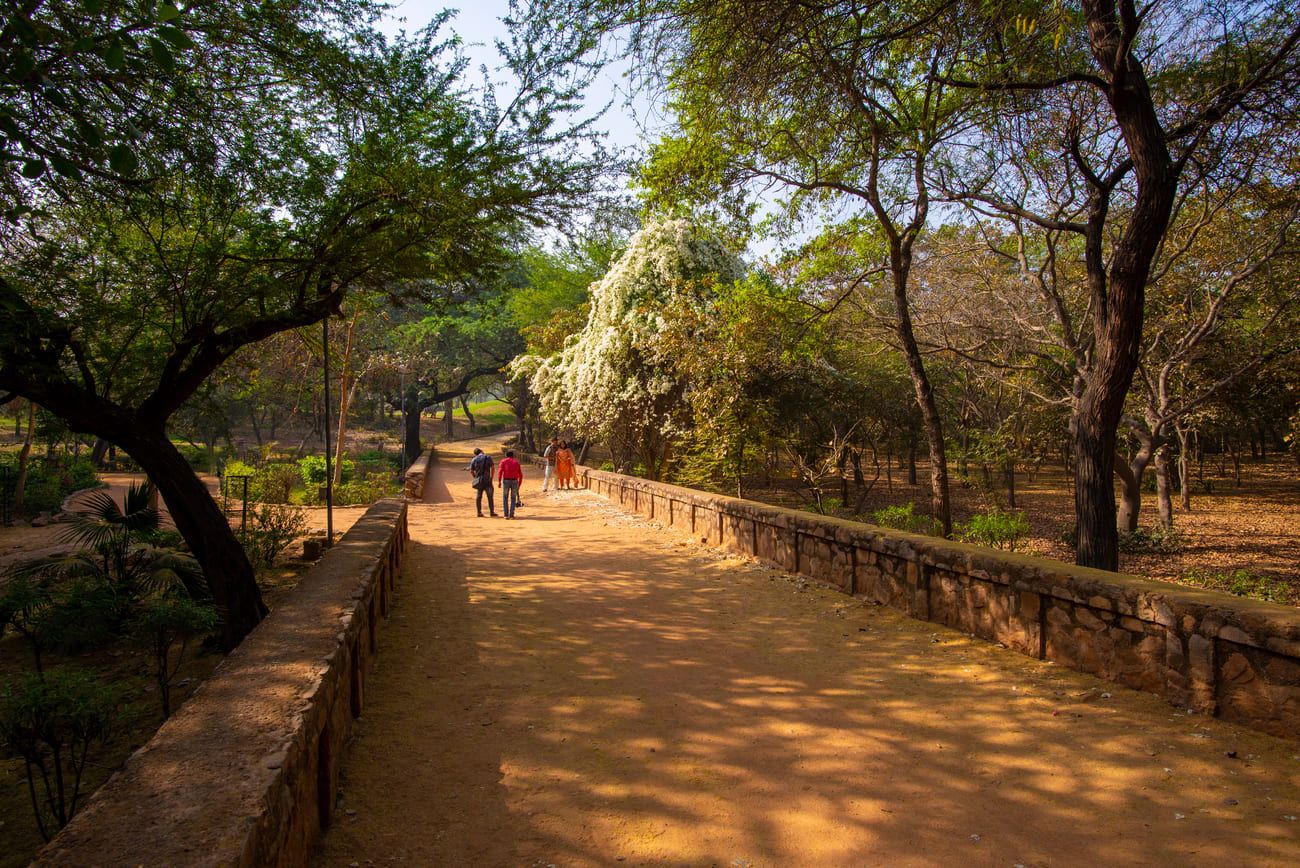
Early morning visitors to the Mehrauli Archeological Park in the southern part of New Delhi © Dan Tiego
Mehrauli Archeological Park
This Archeological Park with its collection of nearly one hundred historical monuments has been occupied continuously for more than 1000 years, which makes it the perfect spot to get to grips with the city’s diverse architectural heritage, all concentrated within a two-hundred-acre area. The cooler winter months are the best time for a stroll through Mehrauli. Explore the remnants of Lal Kot, the oldest surviving fort in the city, constructed in 1060 by the Rajputs of Elijah. There are Khilji relics, Tughlaq and Lodhi Sultanate remains, as well as monuments dating back to British occupation. After this smorgasbord of architectural delights, spoil yourself with a visit to the World Heritage Site of Qutab Minar right next door.
How to get there
Take the metro to Qutab Minar and then continue on a tuk-tuk or bicycle rickshaw, but once inside, you will want to continue on foot.
More information
The incomplete minaret of Alai Minar is a chapter in a less fortunate story; it was supposed to be twice the height of Qutub Minar, and part of a much bigger structure but construction came to an abrupt end in 1316 when Sultan Alauddin Khilji passed away.
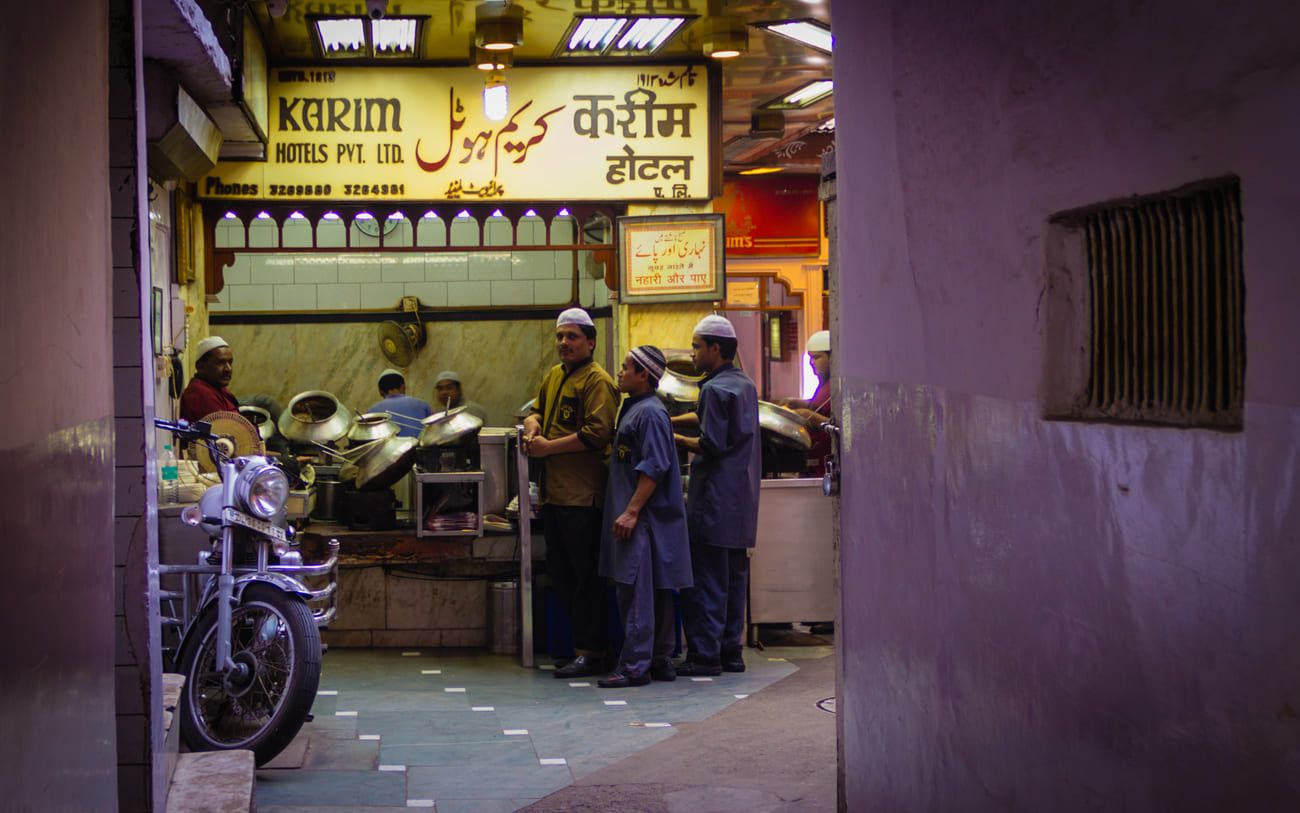
People from all over visit the famous Karim’s restaurant to enjoy their traditional Mughlai food © Supamon R
FOOD TO INDULGE IN DELHI
When it comes to the food, Delhi has a whole range of cuisines to offer, given its cosmopolitan nature. The Indian capital prides itself on having some of the best restaurants and eateries, both pocket-friendly, budget places, and expensive ones. Cuisines are not limited to just the local ones they also include the most acclaimed exotic recipes from all over the world. One gets to enjoy global favorites only in typical ‘Dilli-style’.
To a great extent, Delhi’s Islamic and Mughal heritage defines its food. Therefore a stroll along the side streets of Jama Masjid in Old Delhi is invariably recommended. Make a stop at the historic, the renowned Karim’s to experience its wonderful selection of traditional non-vegetarian dishes. However, there is much more to the Delhi cuisine; a strong, steady flow of many other flavors and tastes have been invading the city through the years, resulting in the best street food in all of India. It can rightly be called the Street Food Capital.
People from all over visit the famous Karim’s restaurant to enjoy their traditional Mughlai food.
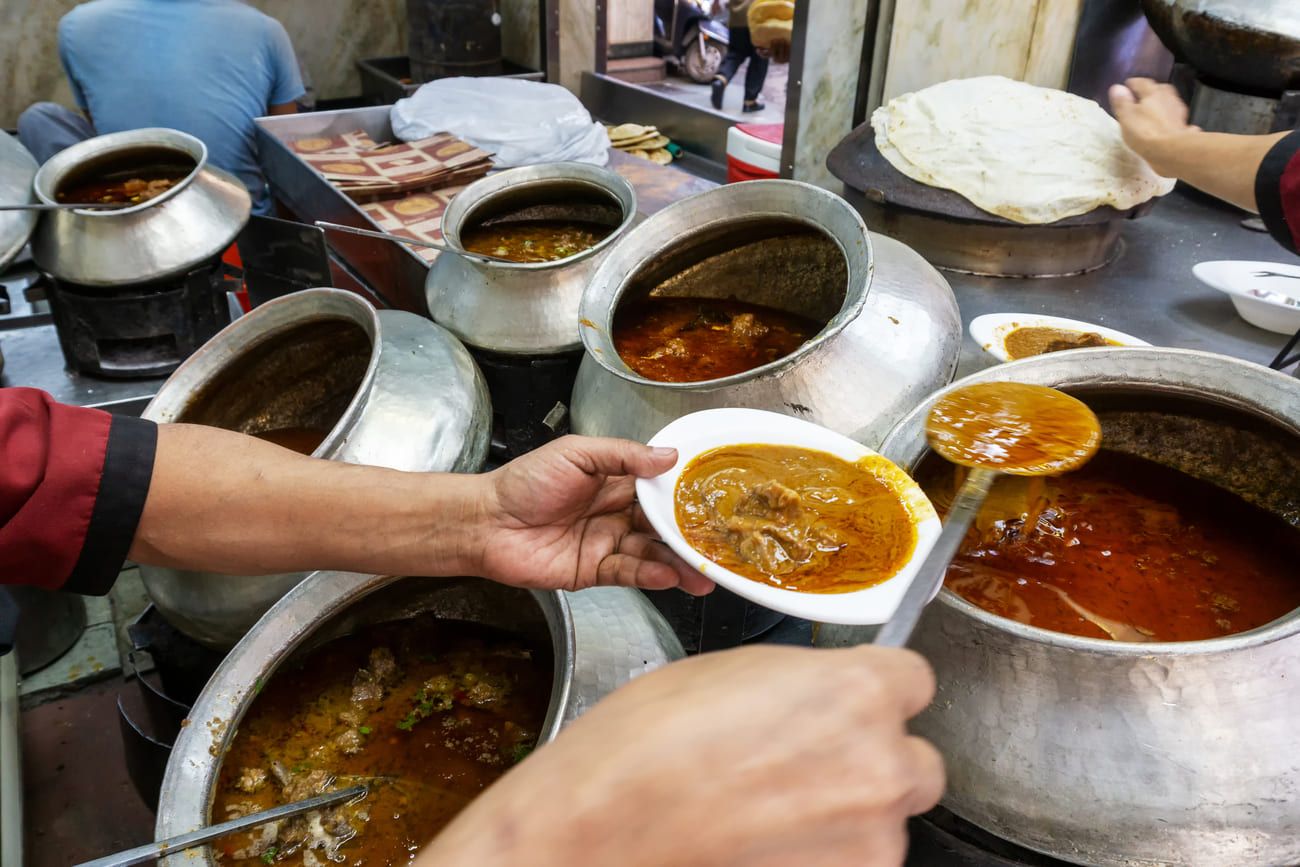
A cook dishing up delicious mutton curry at one of the many restaurants in Chandni Chowk, Old Delhi © Noracarol
It is quite surprising how Delhi has managed to fuse gourmet and street food successfully. A good example is a humble flatbread, paratha, with its selection of fillings like potato, Paneer (fresh cheese), mixed vegetables, and even a dry fruit parantha. Paranthe Wali Gali is noted for its many shops where hungry customers can pick and choose from a wide variety of parathas, but if that late-night craving hits you, pop out to the paratha shop at the Moolchand Flyover.
Parathas can be found at any time of the day and just about everywhere in Delhi. Why not try a different filling every time? You have not experienced Delhi until you have tried its signature Butter Chicken. The story goes that the creation of this simple, yet delectable dish was pure accident. During the 1950s, in Daryaganj’s Moti Mahal, the cook poured a tomato, butter, and chicken stock sauce onto left-over pieces of tandoori chicken by mistake. This was the birth of a now-famous dish. You do not have to go far to find Butter Chicken, it is everywhere, but for the best version, there is none other than the Moti Mahal in Daryaganj (old Delhi).
Not only did the Mughals leave modern-day India with beautiful clothes, fine poetry, art, and music, they also left them kebabs. And everyone who has tasted marinated pieces of meat, fish, or chicken on a stick, grilled over a charcoal fire, will attest to the mouth-watering aroma and heavenly taste of this Mughal legacy. For the classic version, make your way to the hangouts in Nizamuddin or Jama Masjid. If the weather turns chilly, the best way to fend off the cold is with delicious Seekh Kebabs and kali dahl or black lentils, with fresh bread, or tandoori roti. Over-indulged last night? Iconic Kake Di Hatti in the heart of old Delhi has the perfect remedy for that disagreeable hangover; a heavy, greasy dish of spicy, rich Chole Bhature (chickpea curry with fried leavened bread), followed by either salty or sweet lassi, a Yogurt drink.
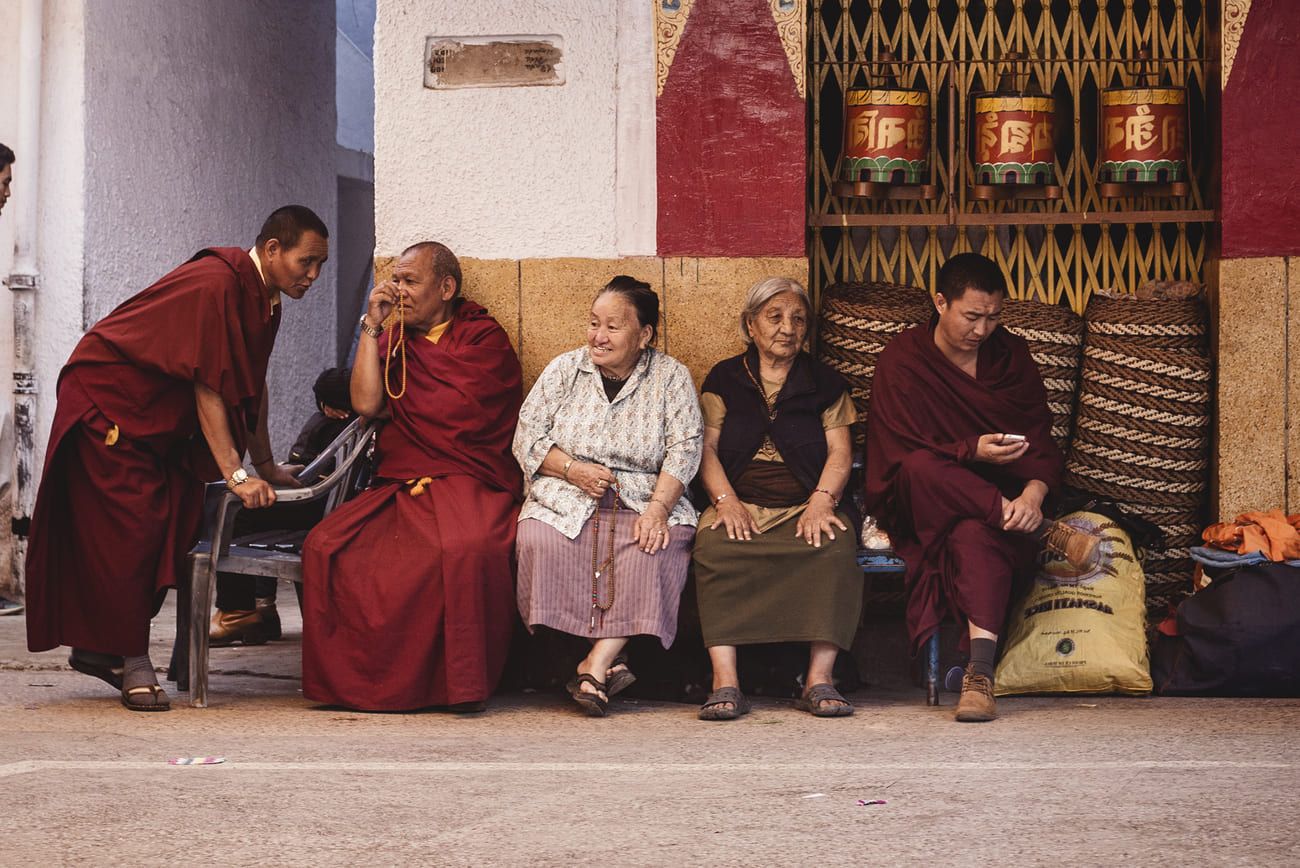
If you are a perfectionist and want to try truly authentic momos, go to Majnu-ka-Tilla, the former settlement for Tibetan refugees © Alexandra Lande
The culinary road which momos, the Tibetan snack of steamed filled dumplings took, was an interesting and circuitous one. It started life as a gourmet appetizer, then slowly made its way to the street stalls, infecting everyone with its aromatic charm, only to end up on fine dining menus again. Two decades later and it is still going strong, alive on every street corner. But quantity does not always equal quality, so if you are adamant to try the hawker version, go to Humayunpur or Nagaland Kitchen, Green Park. Obviously, Majnu-ka-Tilla, also called Little Tibet, serves the very best authentic momos.
If you are a perfectionist and want to try truly authentic momos, go to Majnu-ka-Tilla, the former settlement for Tibetan refugees.
Interesting fact
Refugees, fleeing Tibet during the 1950 Chinese occupation, were settled in this area where narrow, curvy lanes and alleys are filled with street carts, shops, kiosks, boutique hotels and a monastery.
Lastly, let’s move onto dessert, the inevitable sweet conclusion to every meal. CR Park sells wonderful syrupy Rashogollas and sweet Bengali Sandesh. Forget about that diet, make your way to Old Delhi and surrender yourself to crispy desi ghee jalebis, creamy kulfi Faloodas (country ice-cream) at the famous Giani’s di Hatti in Chandi Chowk or Daulat ki Chaat, perfect for wintery days.
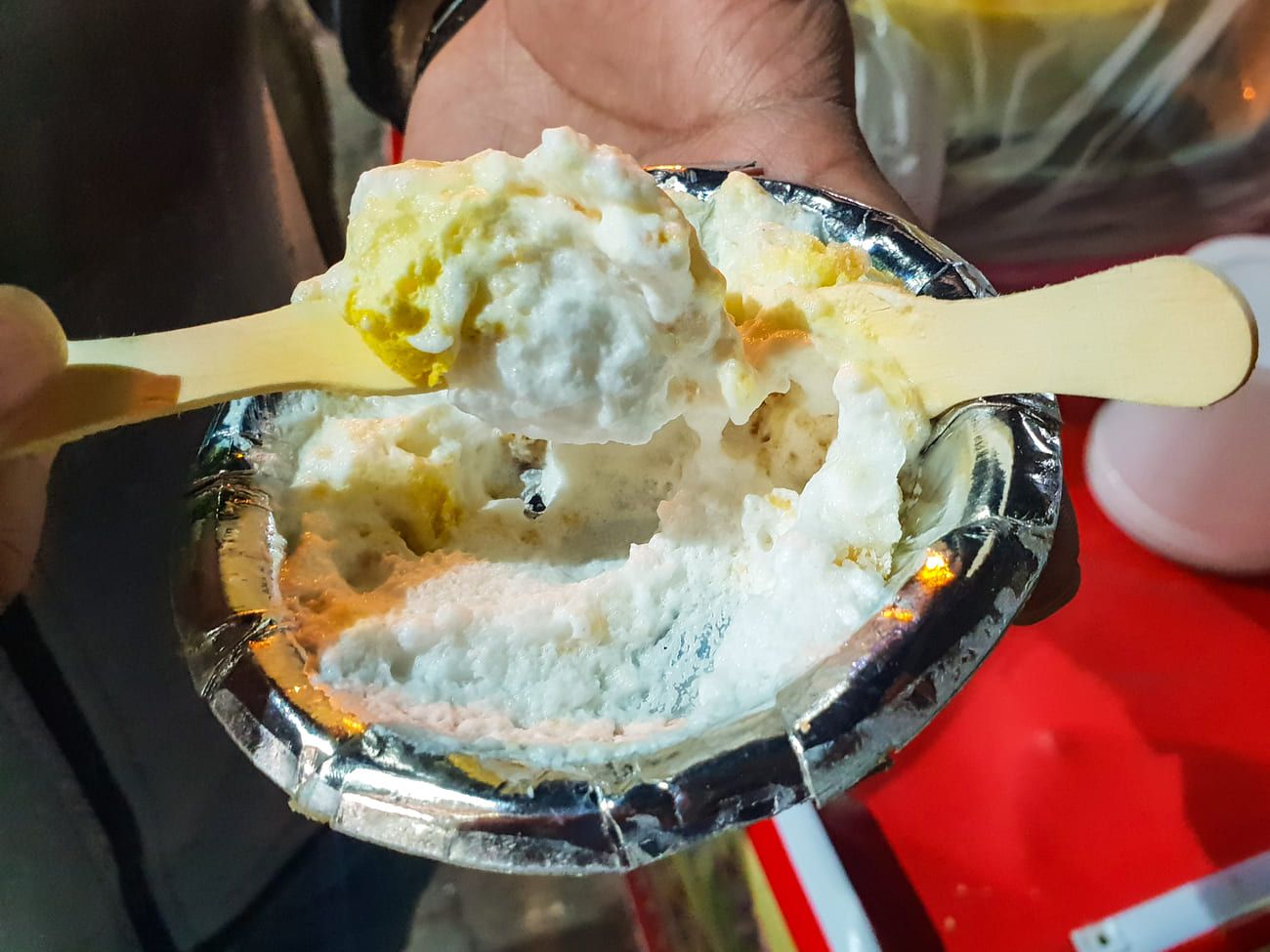
Daulat ki chaat, a delicious traditional Indian sweet dish in an Old Delhi market © 27_Pixel
Paharganj, a Different World
From all corners of the earth, travelers flock to Paharganj, the slightly decrepit, nostalgic, old neighborhood around New Delhi’s Railway Station. Here the Paharganj Posture rules, perfectly modeled in ‘The Heat and Dust Project’ by Devapriya Roy and Saurav Jha. The hotels have ludicrous names and dark rooms, where visitors linger in bed until noon. After an hour of slow awakening, they make their way outside for a leisurely brunch at the renowned German Bakery, or if money is tight, at Khosla or the ever-reliable Madan Café. Then there is a slow stroll to an internet café or a rickshaw ride to the Chandni Chowk. At sunset, energy levels suddenly rise, and the shabby streets fill up with mobs of travelers inspecting the many colorful stores, while others sip on cheap cocktails in shady bars. You see elderly British couples, on their umpteenth annual visit to India, young Israelis freshly discharged from the army, earnest college students from Korea, and shifty Karol Bagh businessmen, everyone, save the prim British, loudly discussing something important.
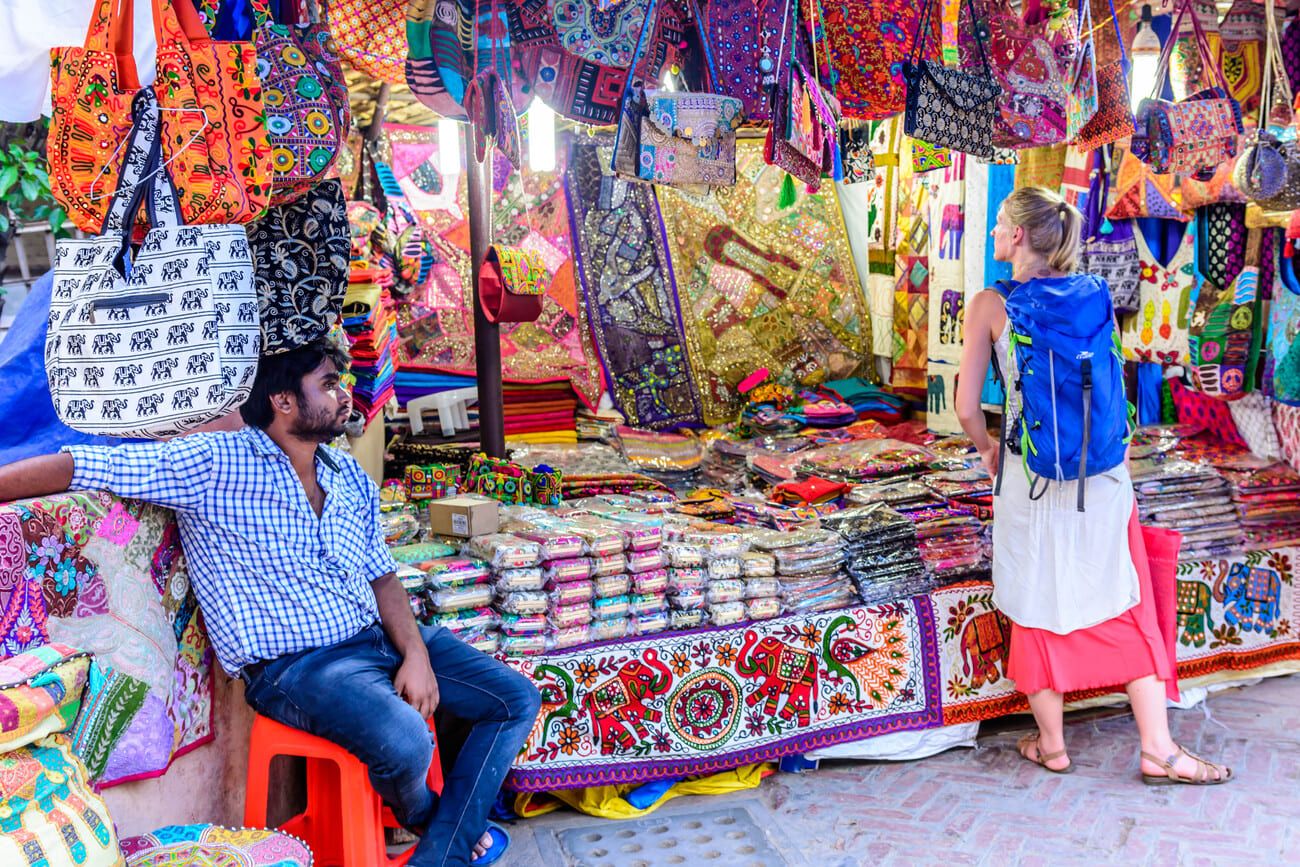
A tourist admiring colorful souvenirs from a traditional Indian shop at Dilli Haat, New Delhi © Sumit.Kumar.99
SHOPPING SPREE IN DELHI
Delhi has all-inclusive and expansive markets that make the city the best destination for all your shopping experiences. The markets boast from beauty and aesthetic products to electronics, clothing, and gadgets, to name but a few. The markets also offer good value to shoppers, given that they are pocket-friendly and tender to the needs of a wide customer base from different classes of society. This means that Delhi, in terms of pricing, has a range of products from the averagely priced to the luxurious, expensive brands. Some of the best-known centers for shopping include Dilli Haat, The Janpath and Tibetan Markets, The South Extension Market, Sarojini Nagar Market, Lajpat Nagar Market, Khan Market, and the Monastery Market. These are the typical ‘shop until you drop’ centers with just about everything to meet anyone’s desires.
All first-time shoppers in Delhi should keep in mind that shopping for bargains in this city is a lengthy affair and something you have to develop a skill for. Negotiations are much more flexible than for instance with the tough store owners in Thailand or Morocco, so take your time and learn to smell a good bargain.
However, if your time is limited, and you have not seen as much of India as you would have liked to, Dilli Haat will solve the problem. This is by far Delhi’s largest and most scenic open-air craft bazaar, perfect for that cool winter’s day. Here you will find crafts representing every state and corner of the country. Vendors are rotated regularly, and the whole 6-acre area falls under the watchful eye of the Delhi Government. The complex has a village-like feel which helps to make this shopping experience an extremely pleasant one.
In Dilli Haat the visitor will find a huge selection of artifacts and handiwork from every corner of the country.
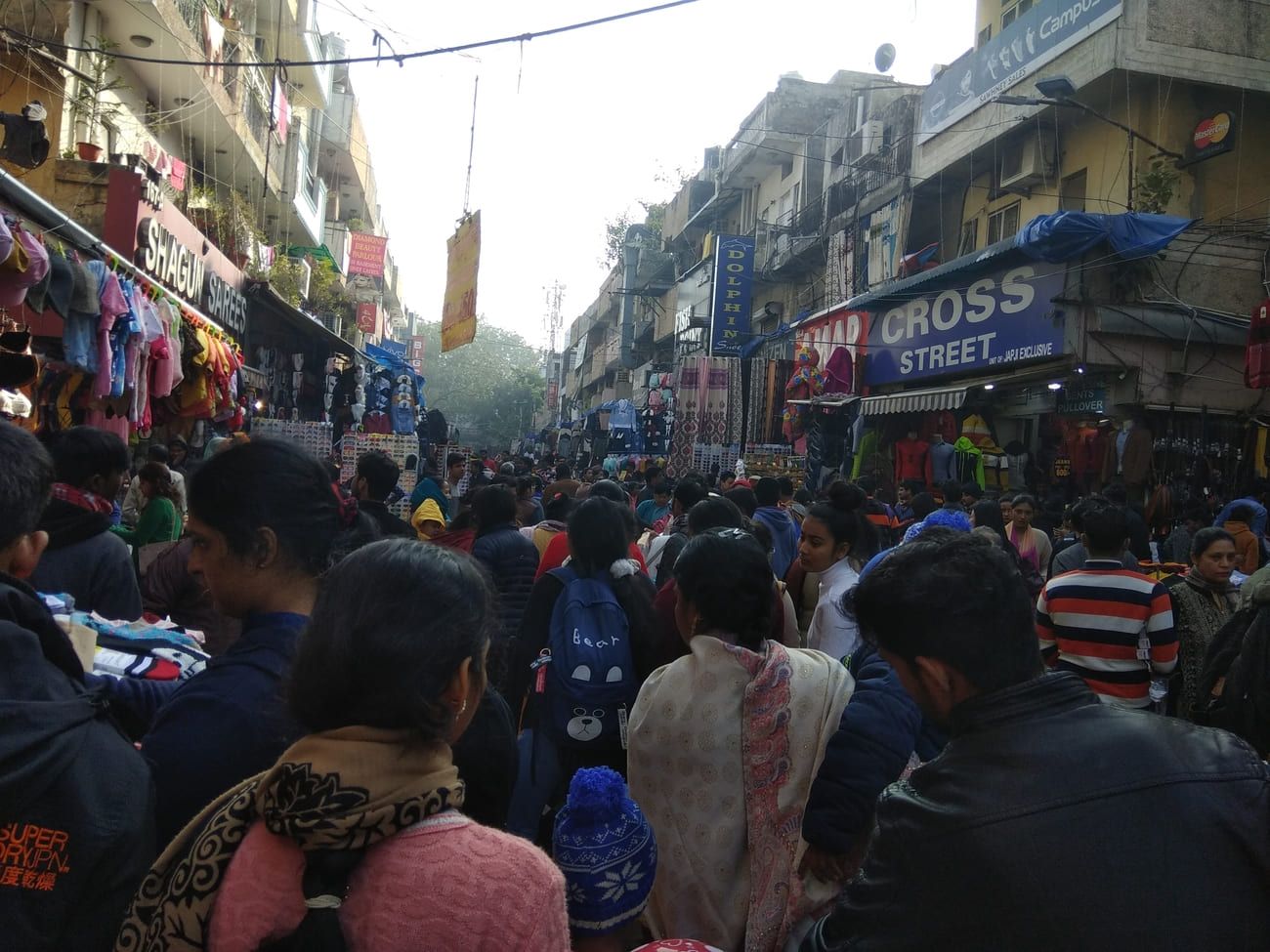
The famous Sarojini Nagar Market in Delhi. Use your bargaining skills in Sarojini Nagar to obtain imitation brand name garments at the very best prices © Satish Srivastava
If bargaining is your favorite activity head for Sarojini Nagar in the plush neighborhood with the same name. It is run by the Residents’ Welfare Association and most of the stores are family-owned. Here you can pick up imitations of Dolce & Gabbana, Prada, Armani, and many other designer labels, as well as export, rejects at unimaginable low prices, especially if you employ your bargaining skills. It can become a little too much of a cheap thrill after an hour or two but is well worth it in the end.
Use your bargaining skills in Sarojini Nagar to obtain imitation brand name garments at the very best prices.
If all this excitement of haggling, and overbearing sights and sounds is not your cup of tea, try the more stylish, relaxed atmosphere of Khan Market. This is the costliest retail area in India, with its classy, elegant shops that all have their loyal customers. Wander through the high street, enjoy a leisurely coffee, browse through the stores and then go to Bahrisons Booksellers. Established in 1953, his remarkable bookstore has withstood the test of time. Books are everywhere, in bookcases, and stacked like pillars up to the ceiling, and amazingly the attendants seem to be able to locate any title you ask for. Re-wind here for the rest of the afternoon and you will be ready for your evening activities.
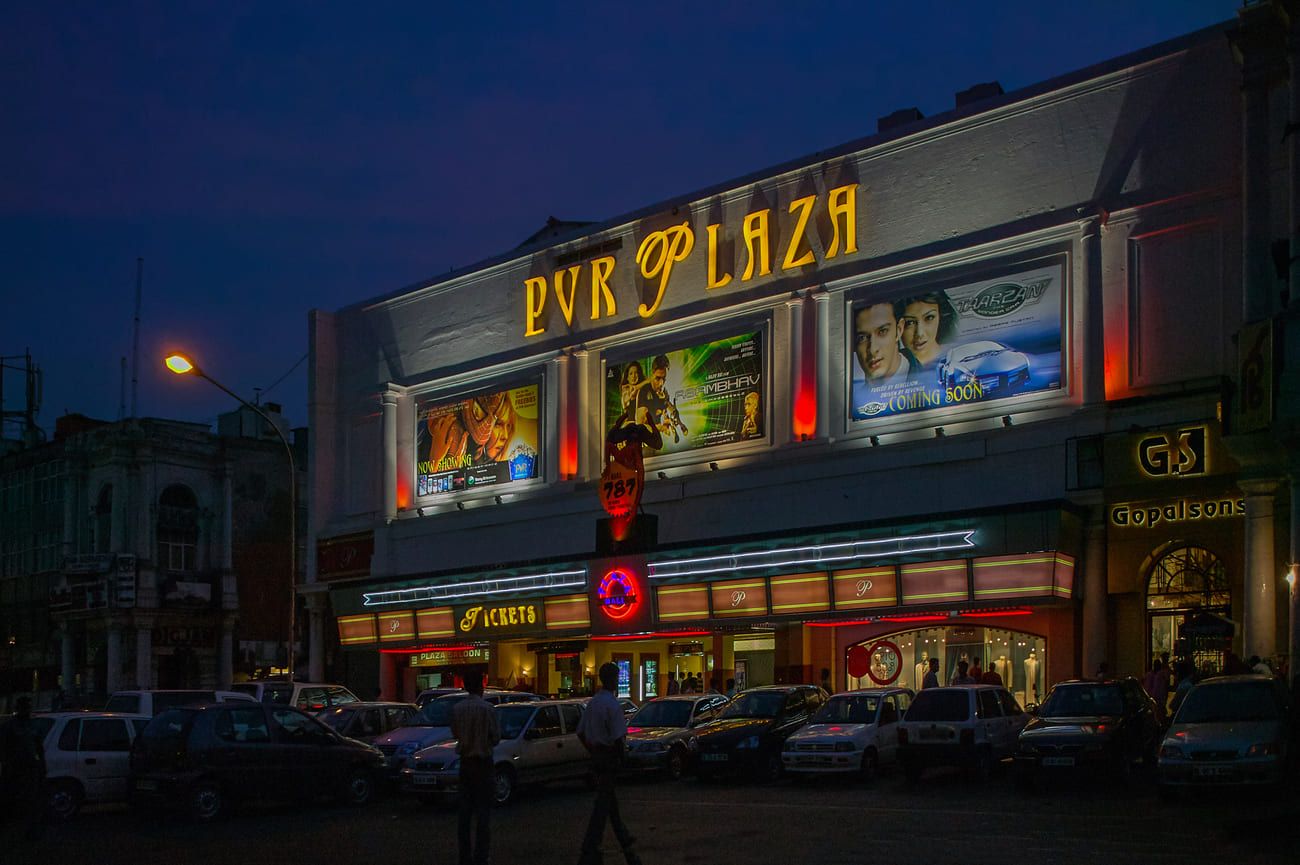
Cinema Plaza at Connaught Place, New Delhi, India © Anil D
The most iconic market in Old Delhi is without a doubt Chandni Chowk. It is by far the oldest too and exploring its narrow, winding little lanes quickly turns into an exciting adventure itself. Alleys divide the bazaar into specialized areas; in Katra Neel, you will find vivid saris and textiles, Bhagirath has a wide selection of electronics, and Dariba Kalan specializes in ancient silver jewelry. There are also bazaars that sell spices, essential oils, dried fruit, traditional Indian sweets, and many more. Replenish your energy every now and then with a savory snack (chaat) from one of the many vendors.
The city is also acknowledged for its cinema halls, otherwise referred to as the ‘entertainment watch-outs’. They include the PVR in Connaught Place, PVR Saket, Priya, and CP which are some of the most famous cinema halls. Other forms of entertainment that should not be overlooked are the theaters hosting cultural and literary events; they form an important part of the entertainment. Delhi is vibrant by night with lively discos and nightclubs, pubs, and bars galore to explore. It is for this reason that Delhi is typically referred to as a Day-in and Day-out city!
How to get there
Khan Market, Chandni Chowk, Sarojini Nagar and Dilli Haat are all close to metro stations. Explore the alleys of Chandni Chowk in a rickshaw; it is an authentic and cheap option.
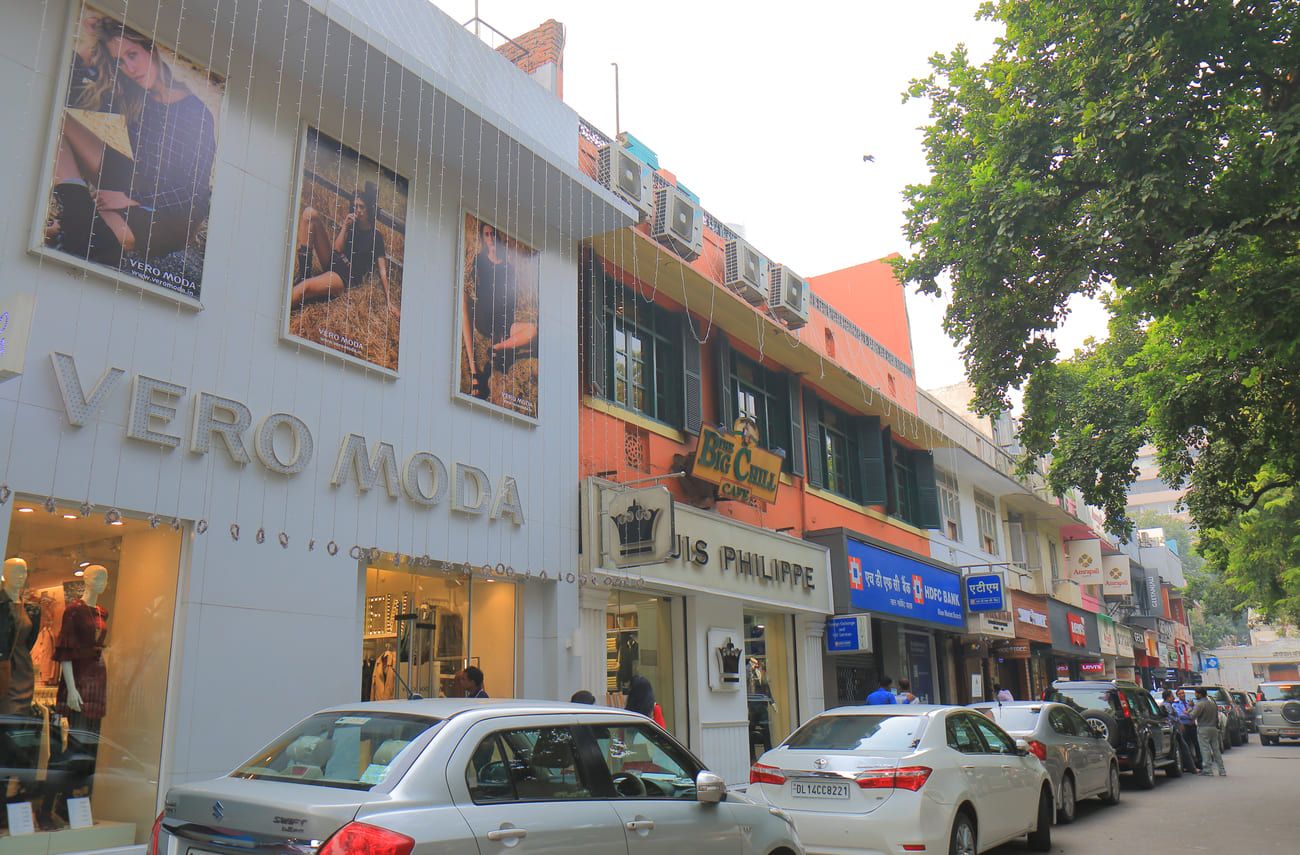
Street view of the popular Khan Market shopping complex in New Delhi, India © TK Kurikawa
Interesting fact
Festivals and performances from many different states across the country are regularly hosted at Dilli Haat. Find more information as you enter the market.
Toward the South-west of the city is the state of Rajasthan which is also called the Pink City of Jaipur because of its pastel-painted avenues and the extravagant forts and palaces. The Taj Mahal, located in the city of Agra, is just 200Km (3 hours) from Delhi. Together with Agra and Jaipur, Delhi belongs to the Golden Triangle Circuit, usually a 4 to 6-day trip.
The Himalayas can be reached from the state of Himachal Pradesh which is 300 km north of Delhi. The town of Manali is famous as the starting point for skiing, climbing, and rafting adventures. The temple town of Haridwar and the yoga capital Rishikesh are 5 hours’ drive from New Delhi.
Delhi is easily accessible from other cities in India. Flights to other cities are immensely affordable and frequent. For instance, Mumbai which is located south-west of Delhi, is two hours away by air, with the coastal city of Goa just a bit further for those with a hunger to explore the beauty of nature and beaches.
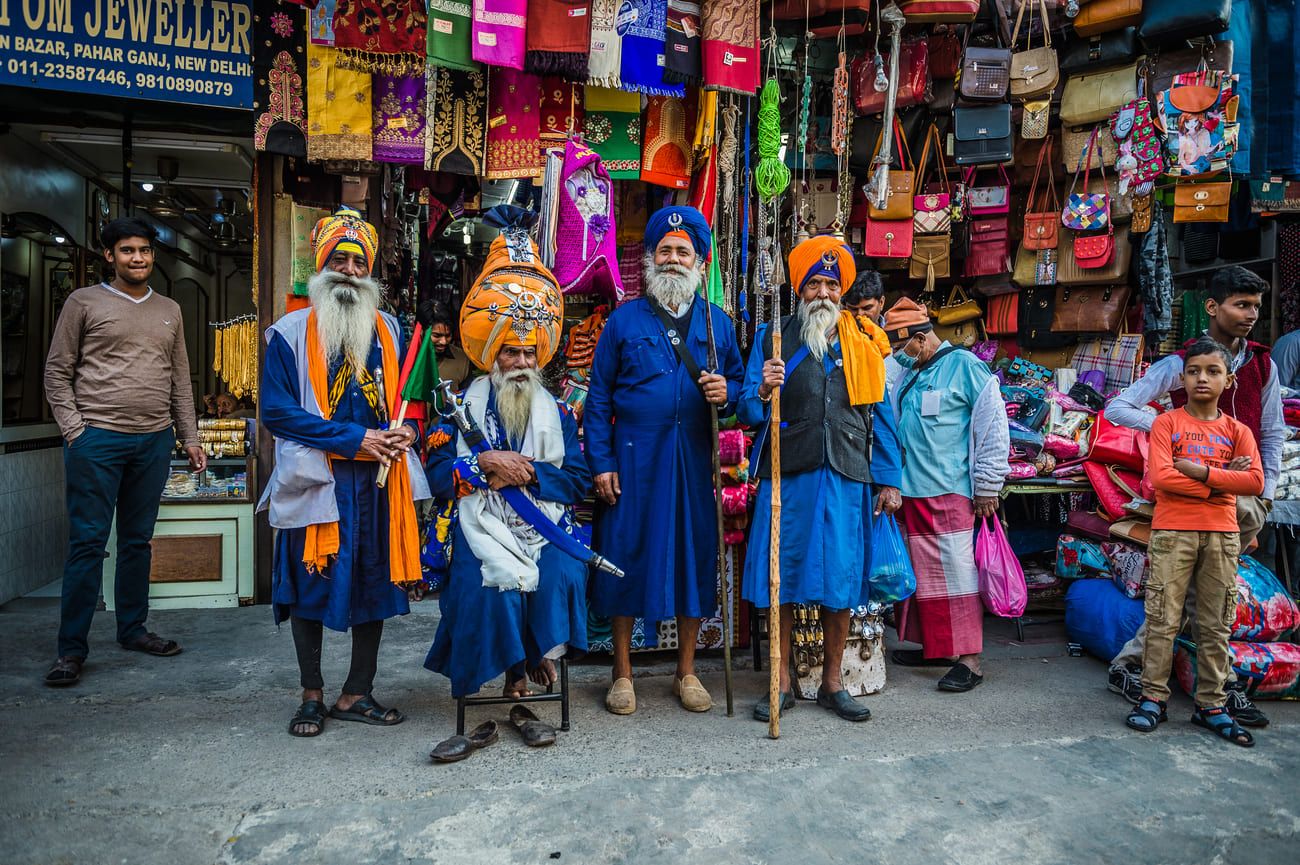
A group of proud Indian men in their traditional attire in the Gurudwara Bangla Sahib in New Delhi © Valentin Tulea
Some Images From Our Trip To Delhi
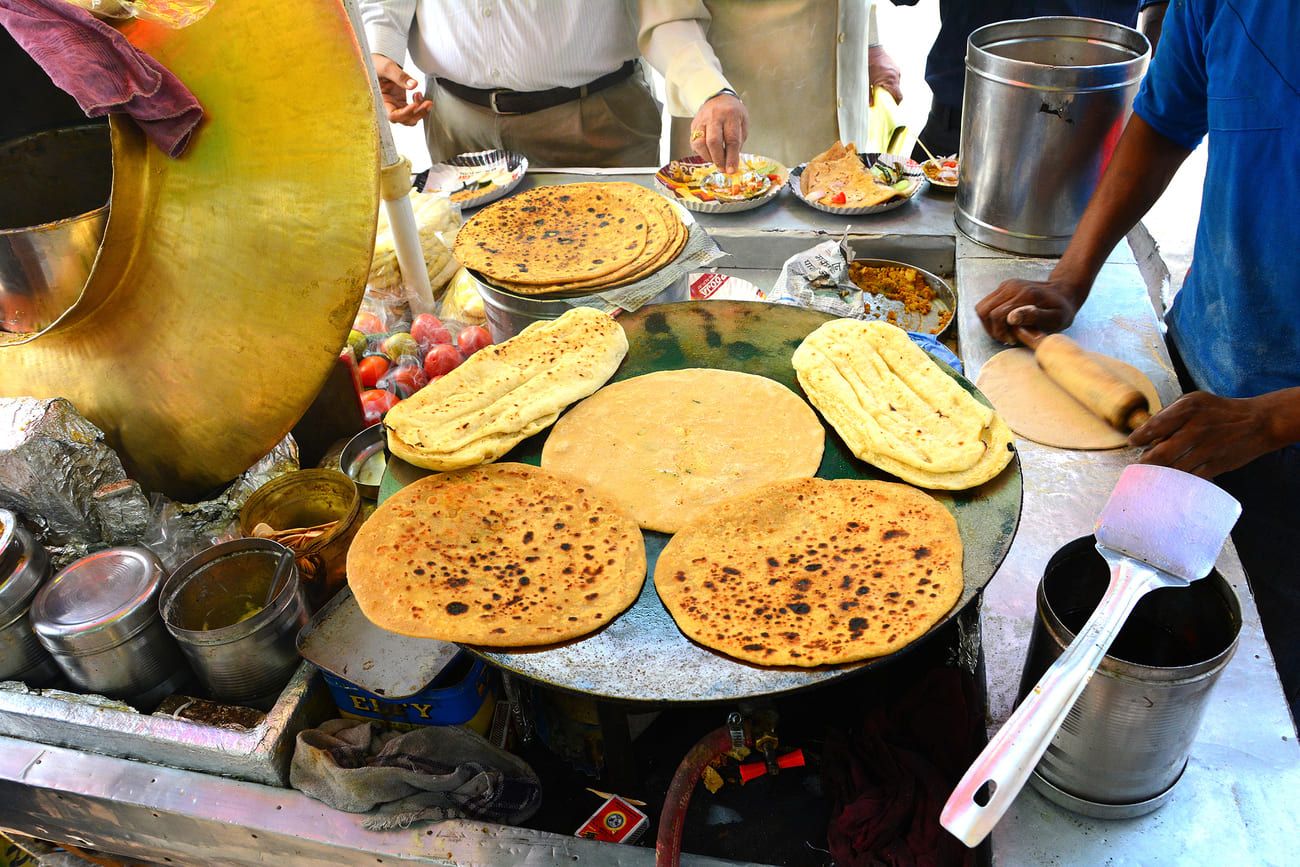
Parathas can be found anytime of the day and just about everywhere in Delhi. Why not try a different filling every time? © AjayTvm
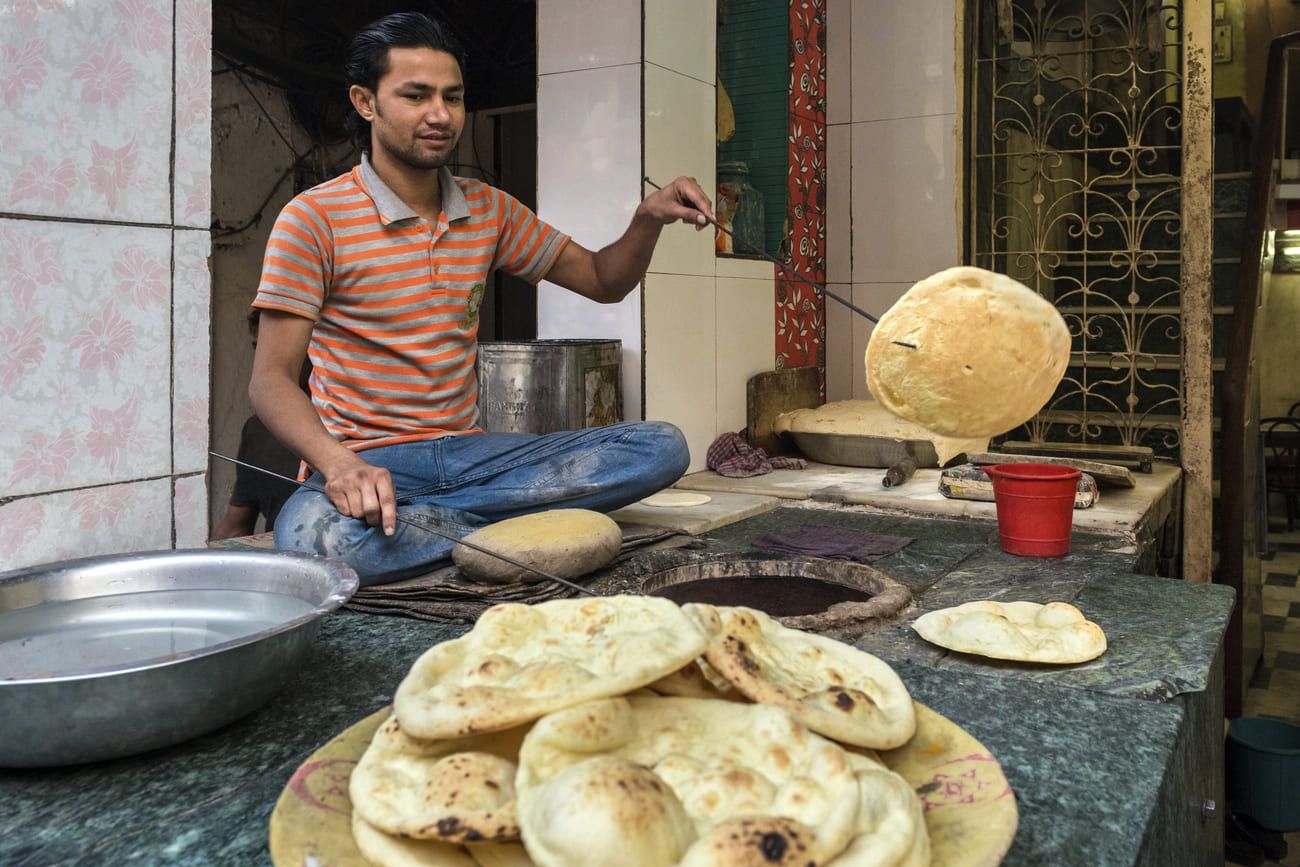
Baker baking naan in an outdoor oven in Delhi © Marek Lipka-Kadaj
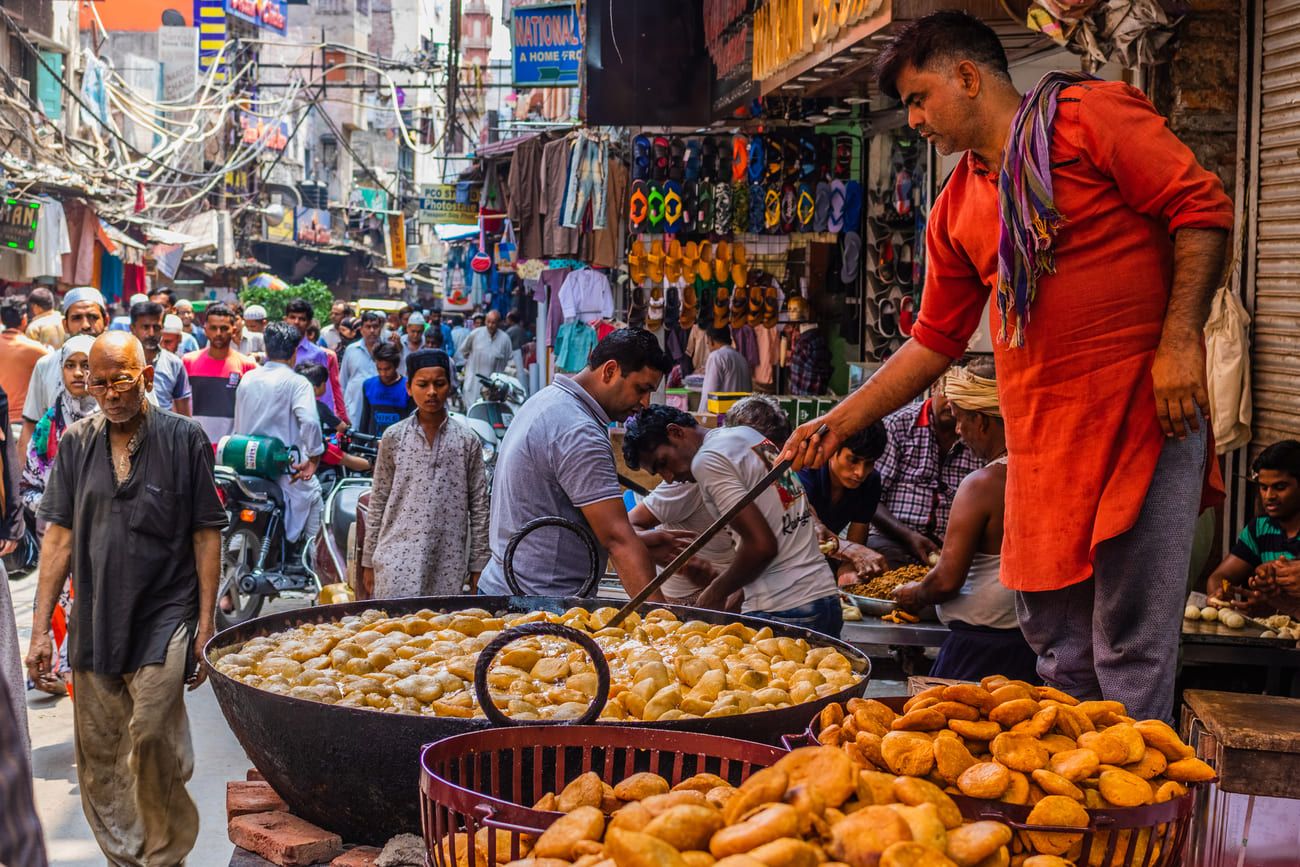
A vendor preparing snacks at a busy street market © Mahesh M J
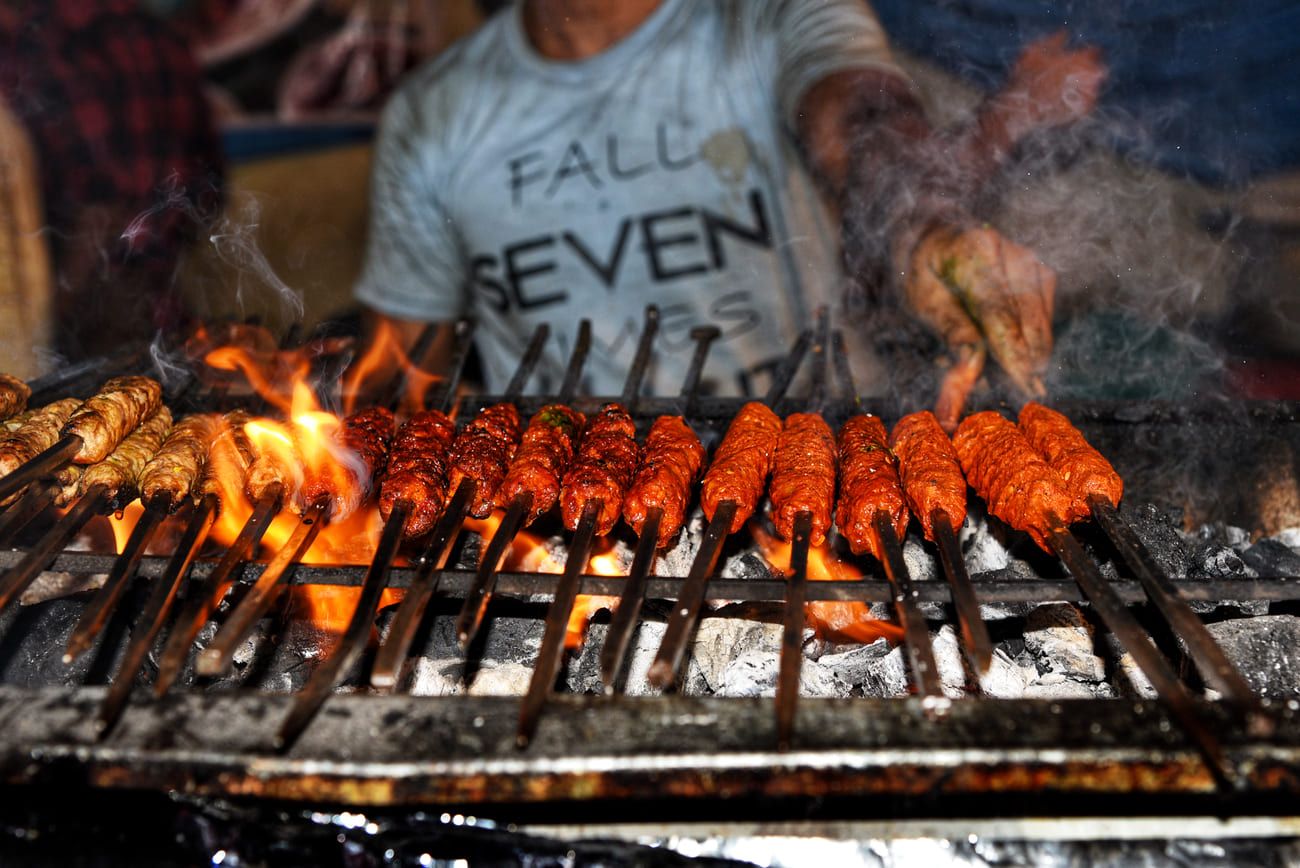
Spicy Seekh and tasty camel meat kebabs during an Iftar food festival at the Indian Ramadan market in Shivaji Nagar, Bengaluru © Santhosh Varghese
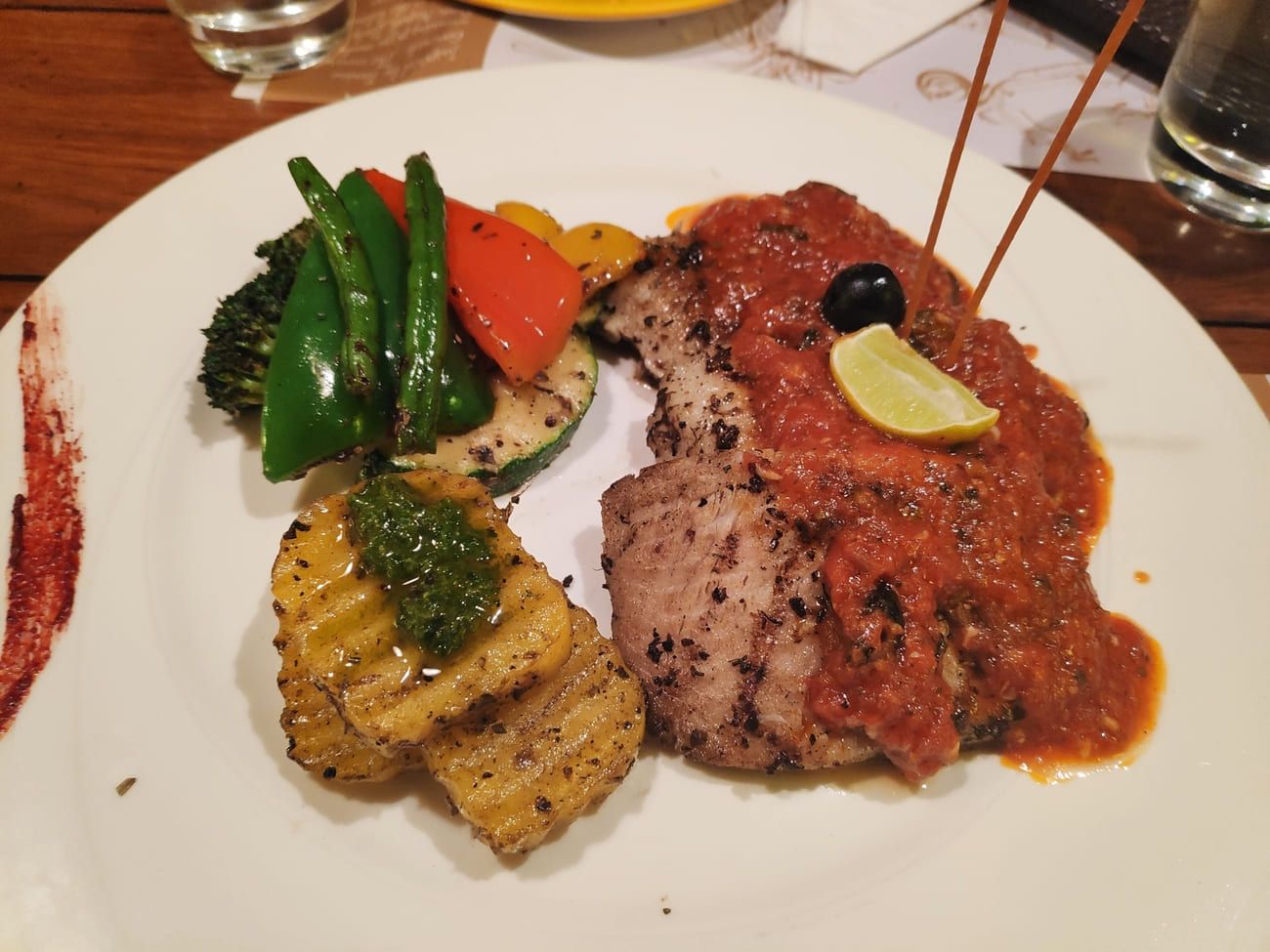
Tasty grilled fish with a peri-peri sauce and vegetables at the Tonino Restaurant, Connaught Place, New Delhi © Anuj Girdhar
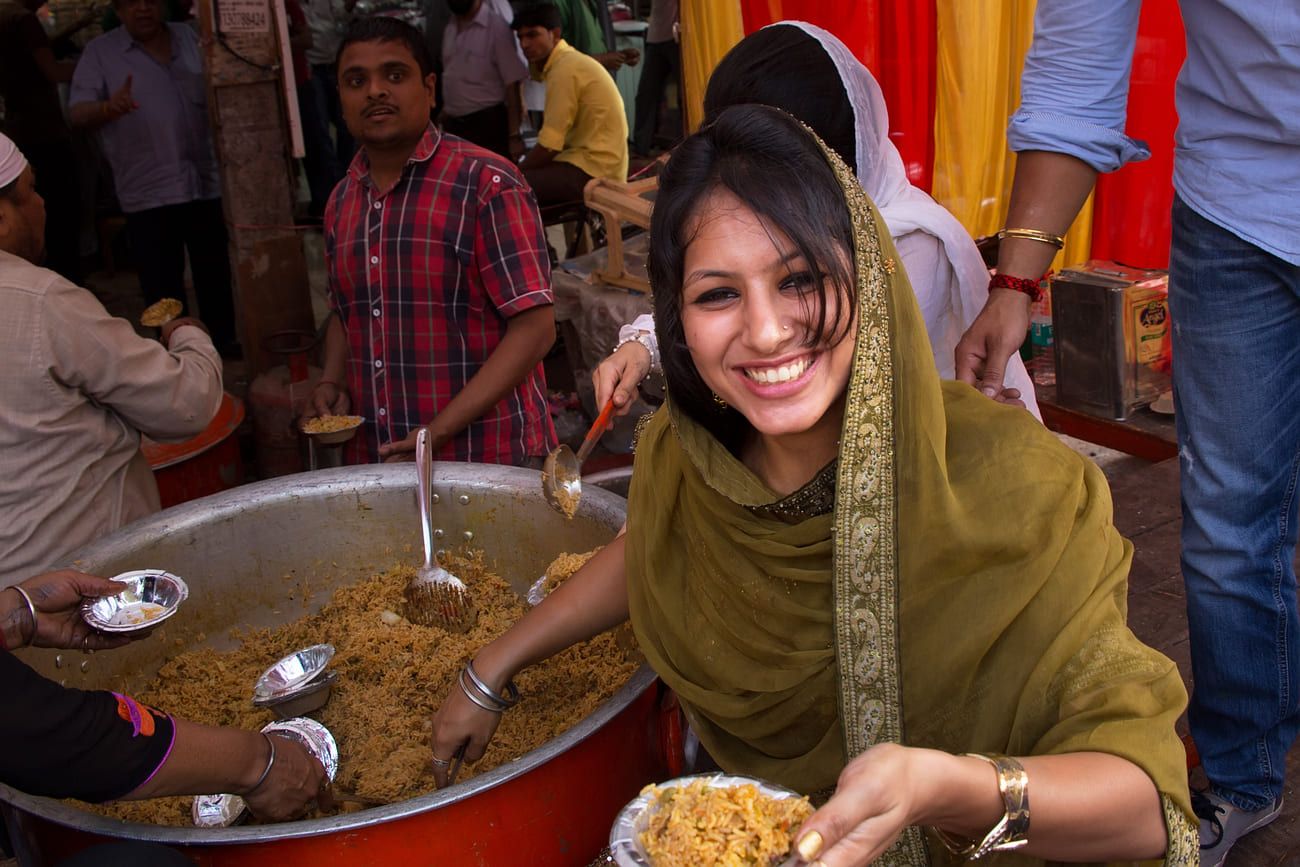
Woman dishing out rice during Guru Nanak Gurpurab celebration in Delhi, India. The festival celebrates the birth of the first Sikh Guru © Don Mammoser
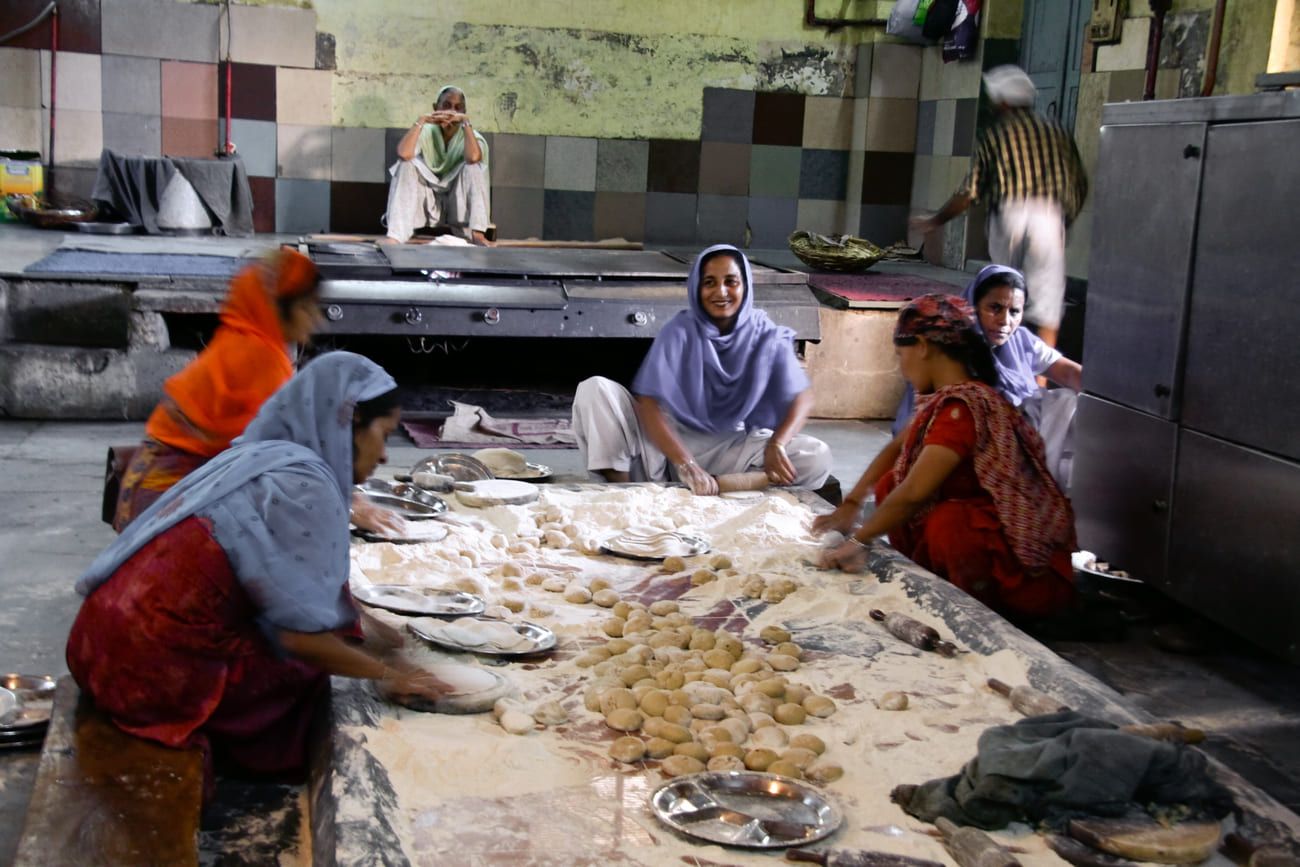
Women preparing food in the kitchen of a Sikh temple in Delhi, India. Sikh temples serve thousands of free meals to the poor every day © Paul Prescott
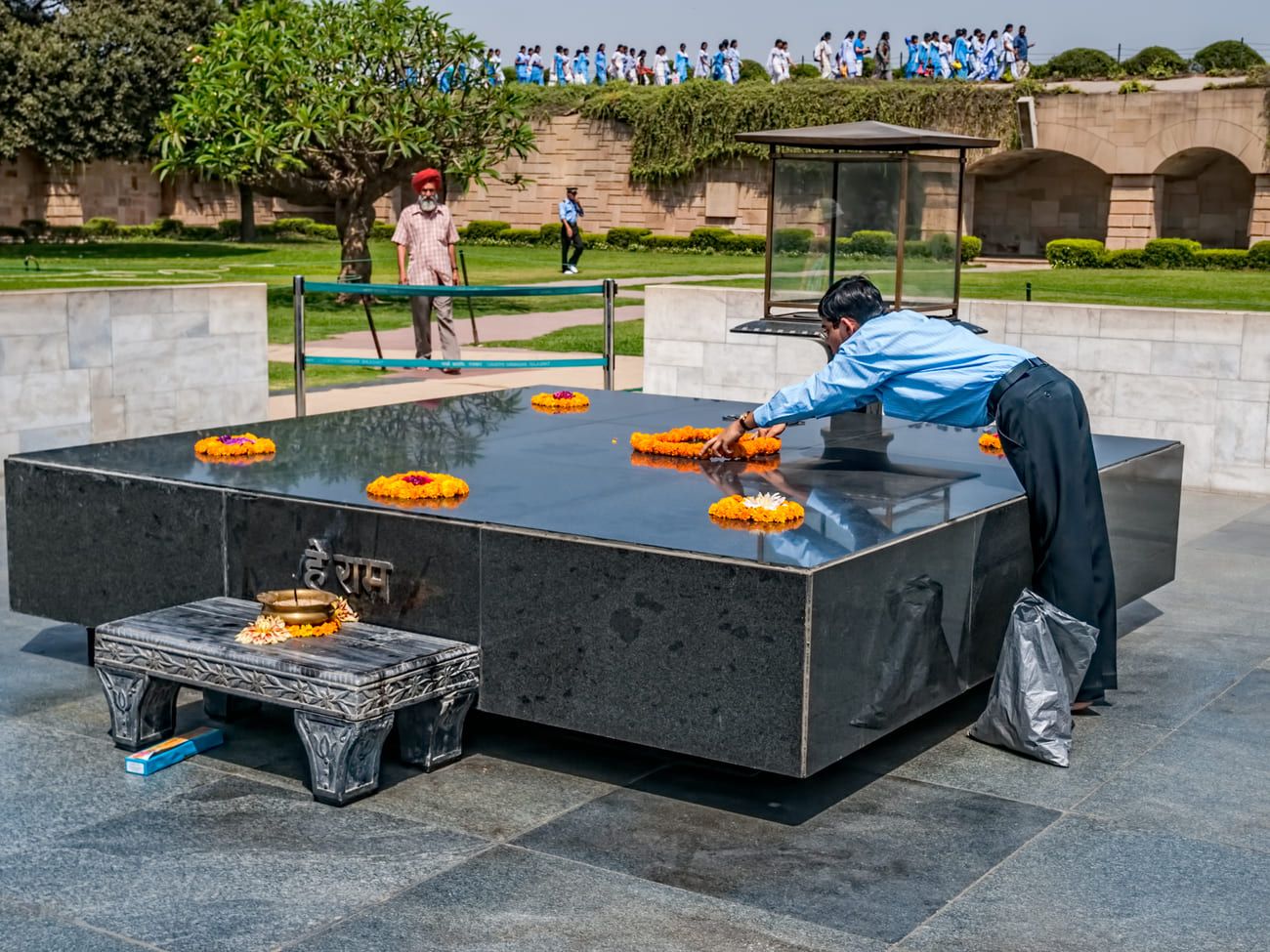
A Mahatma Gandhi admirer placing floral wreaths on the Raj Ghat memorial in his honor, New Delhi © Jasmina
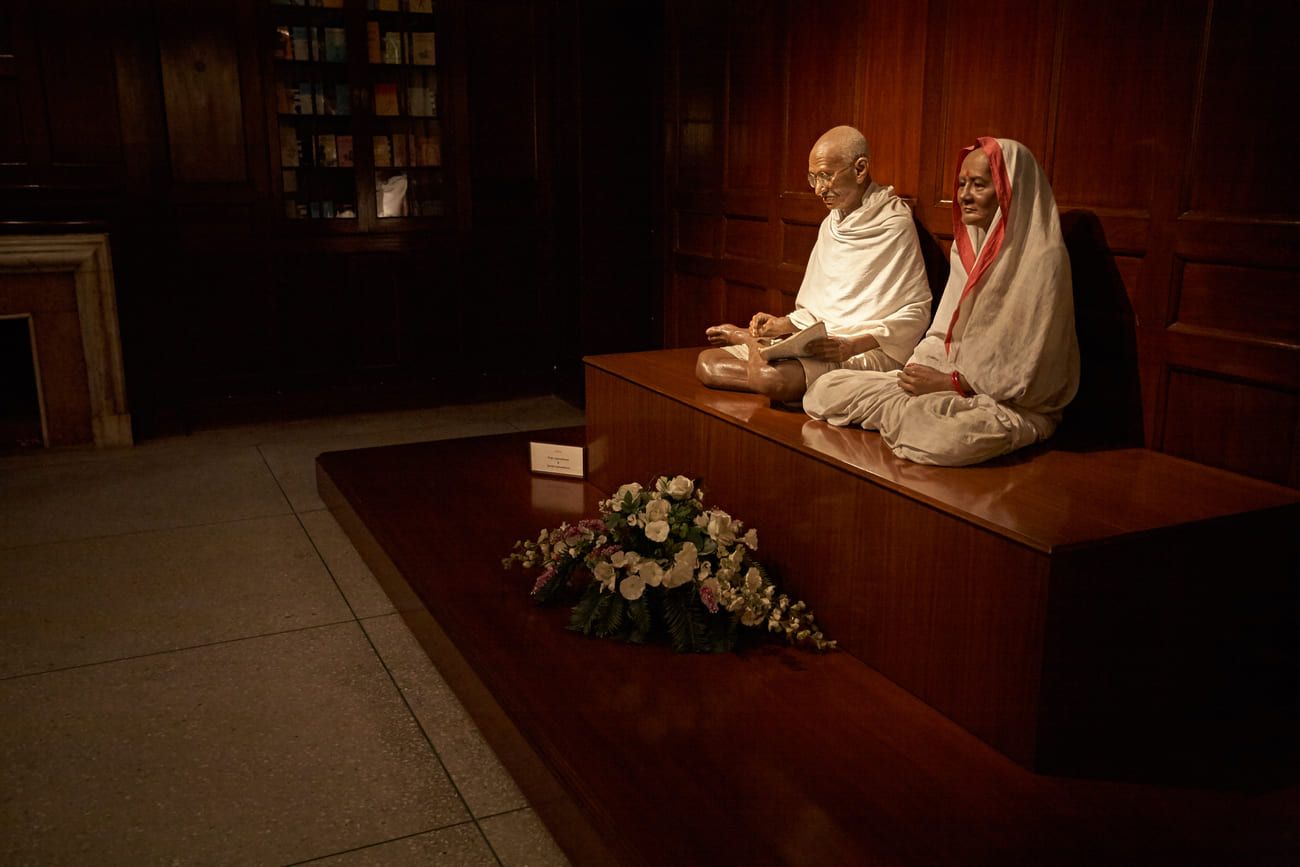
Wax likeness of Mahatma Gandhi at the Gandhi National Museum, Birla House, New Delhi © Salvacampillo
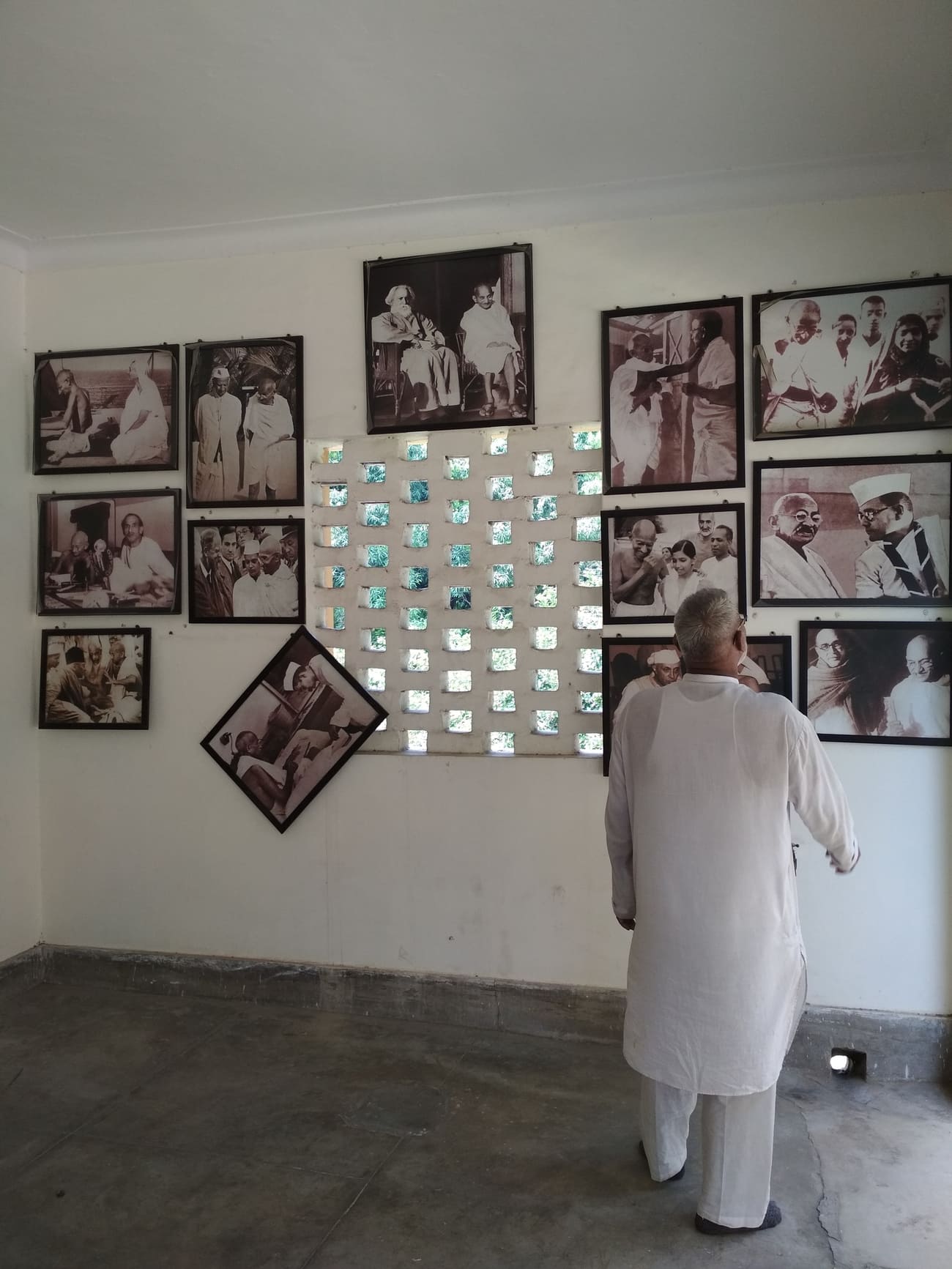
Visitor looking at the pictures of Pandit Nehru with other leaders in the Mahatma Gandhi room
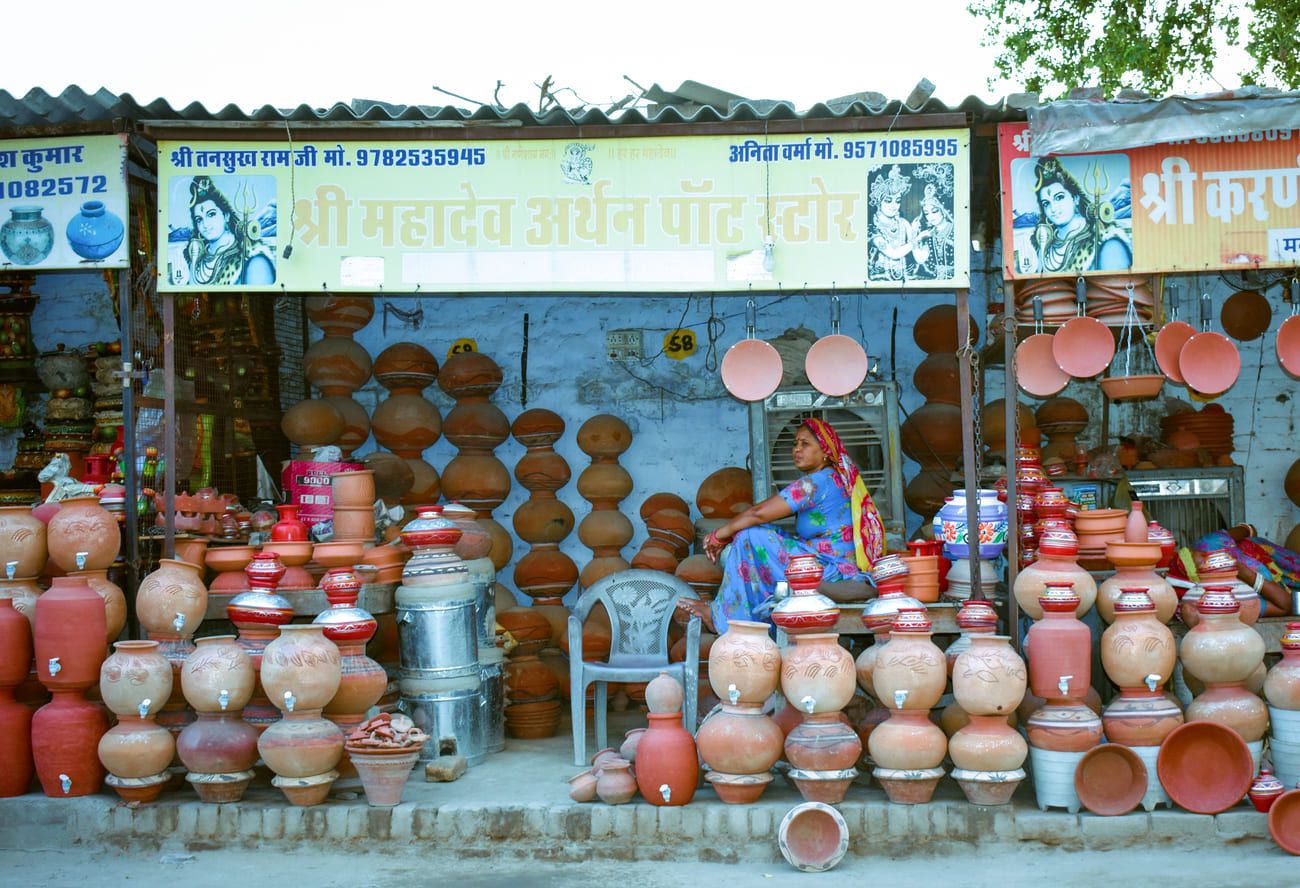
A vendor at her stall selling water vessels © Singhramana
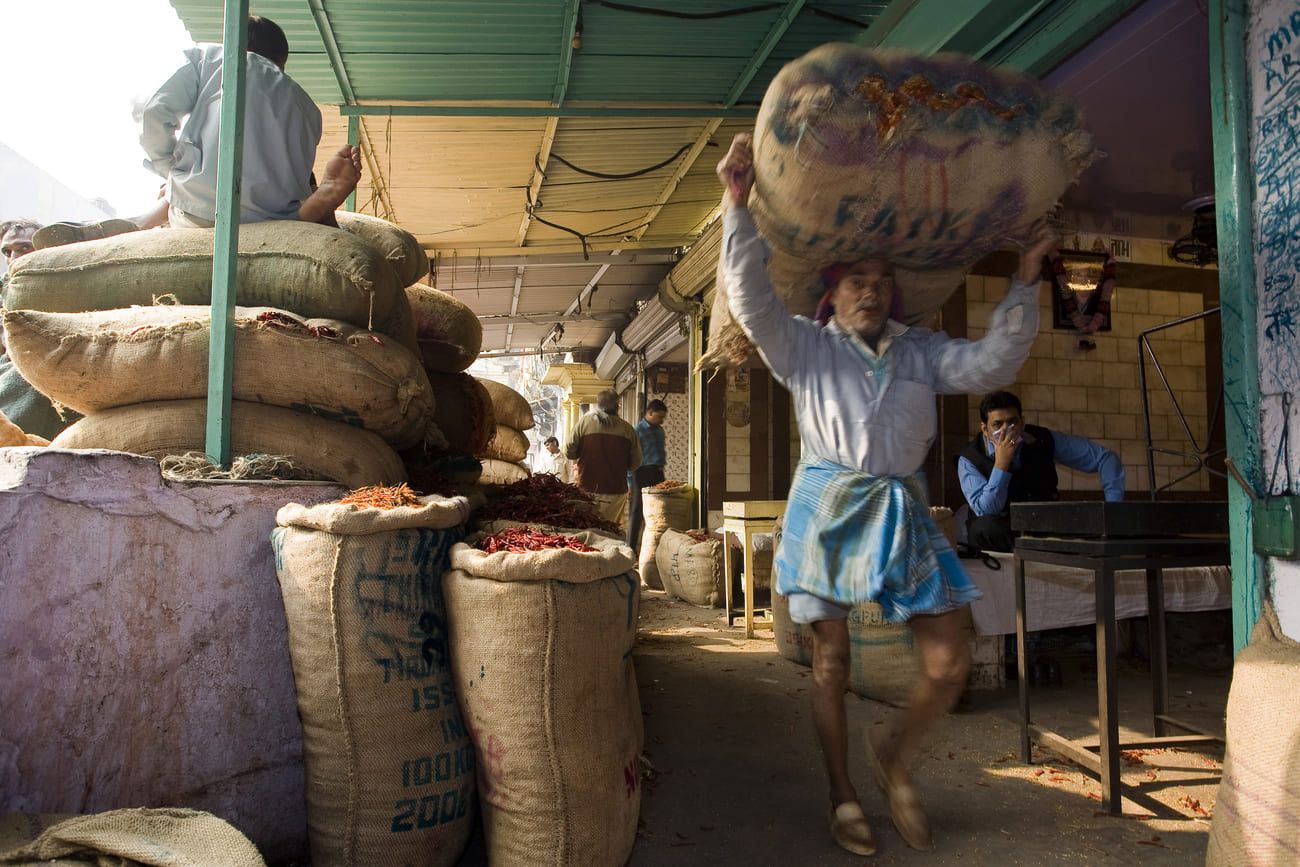
A worker with a bag of spices at the spice market © Maxironwas
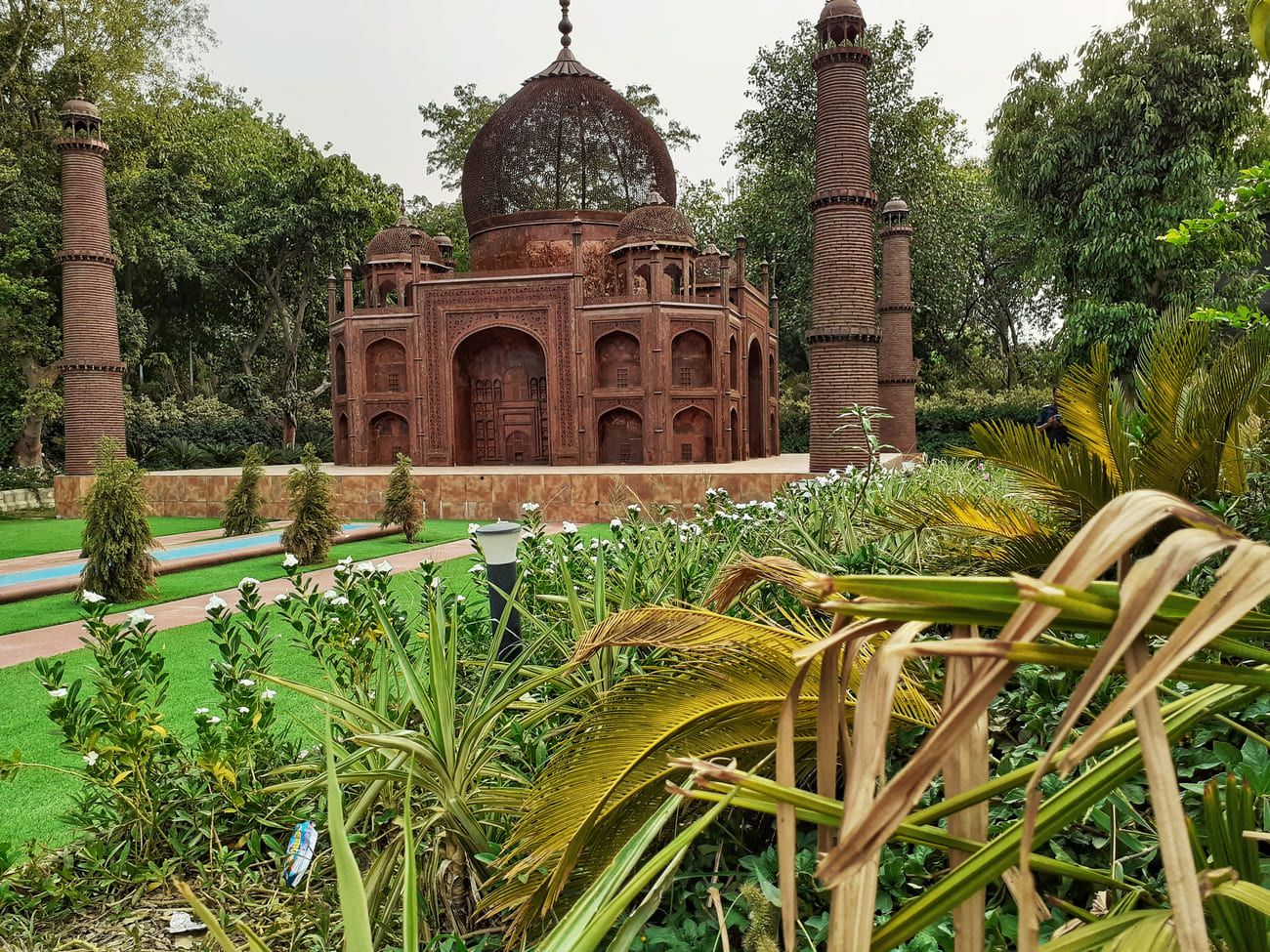
A magnificent replica of the Taj Mahal, made from waste material, near the Nizamuddin Metro station, New Delhi © Razz Yadav

Airplanes at Indira Gandhi International Airport in Delhi, the busiest airport in India © Subodh Agnihotri
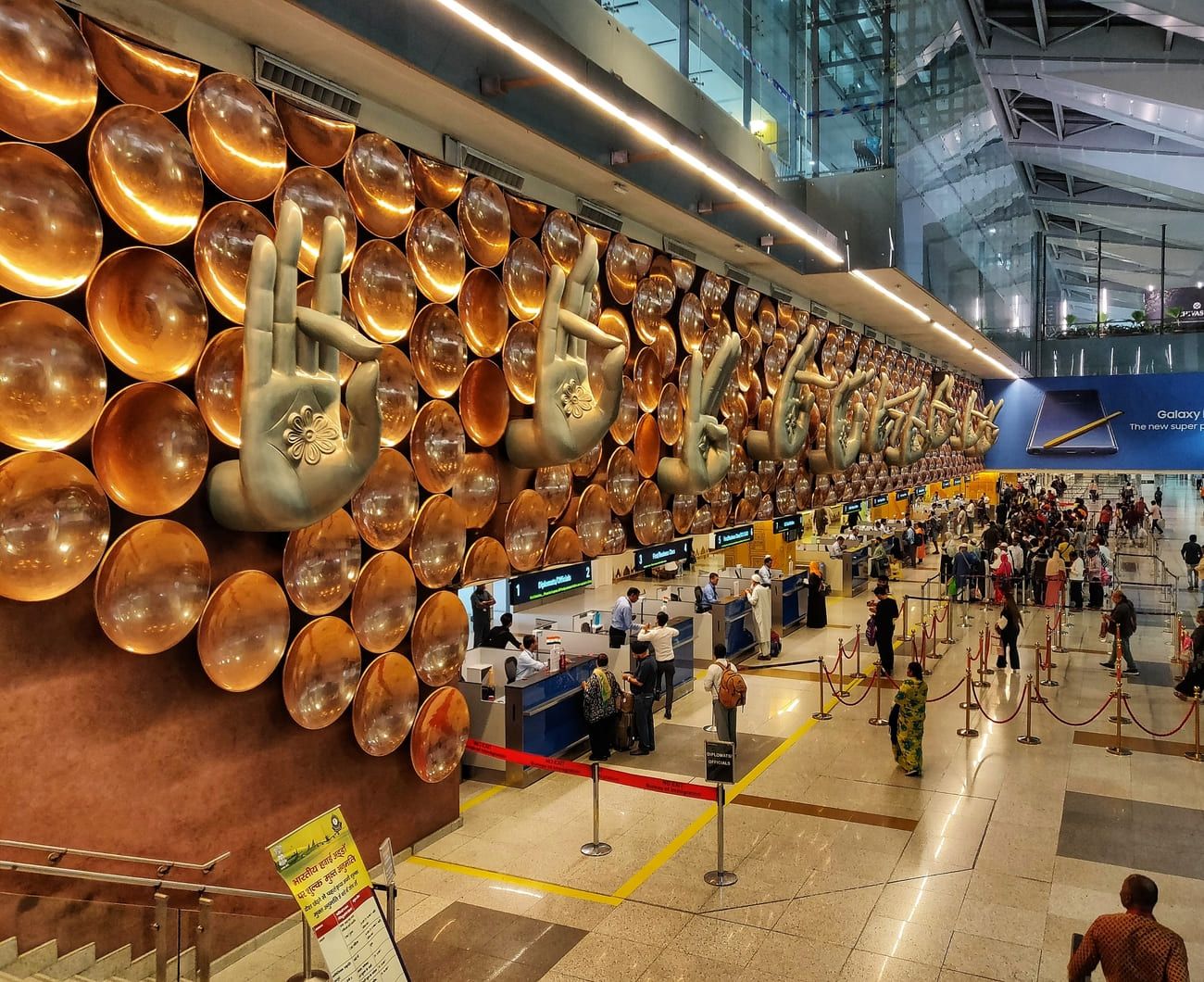
Artwork at the Indira Gandhi International Airport in New Delhi © Shashank Kumar
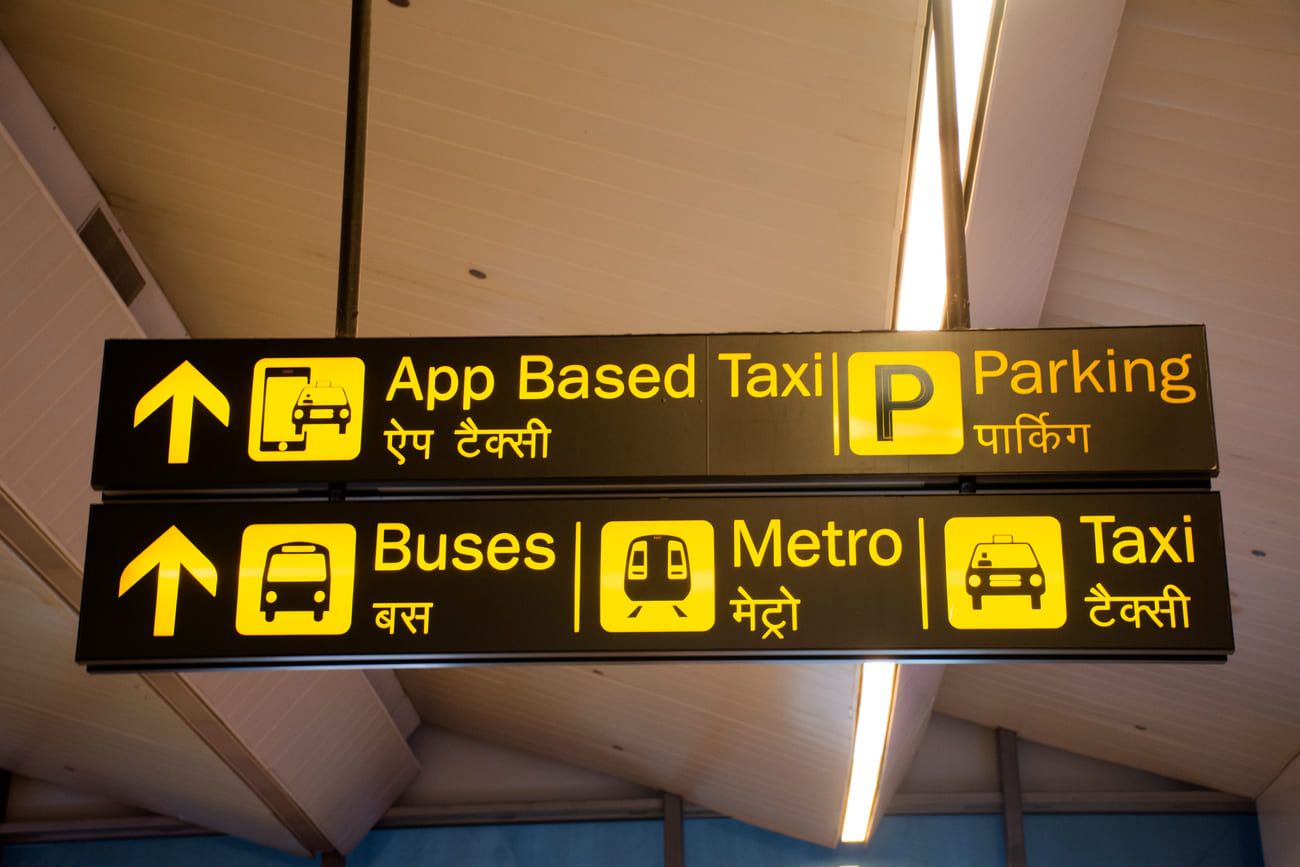
Information board at the Indira Gandhi International Airport, New Delhi, India © Anirut Thailand
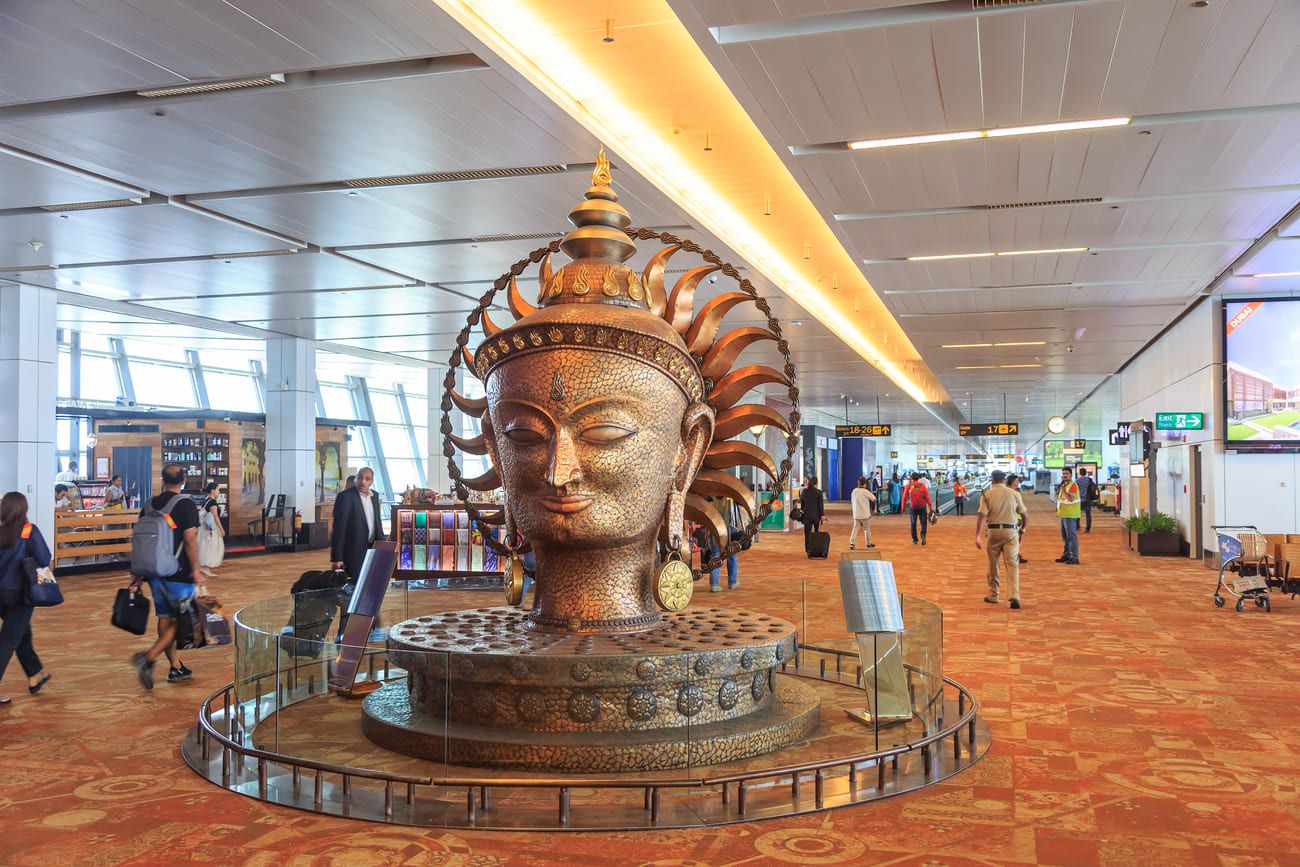
Departure hall at Indira Gandhi International Airport showcasing a beautiful artwork © Casper1774 Studio
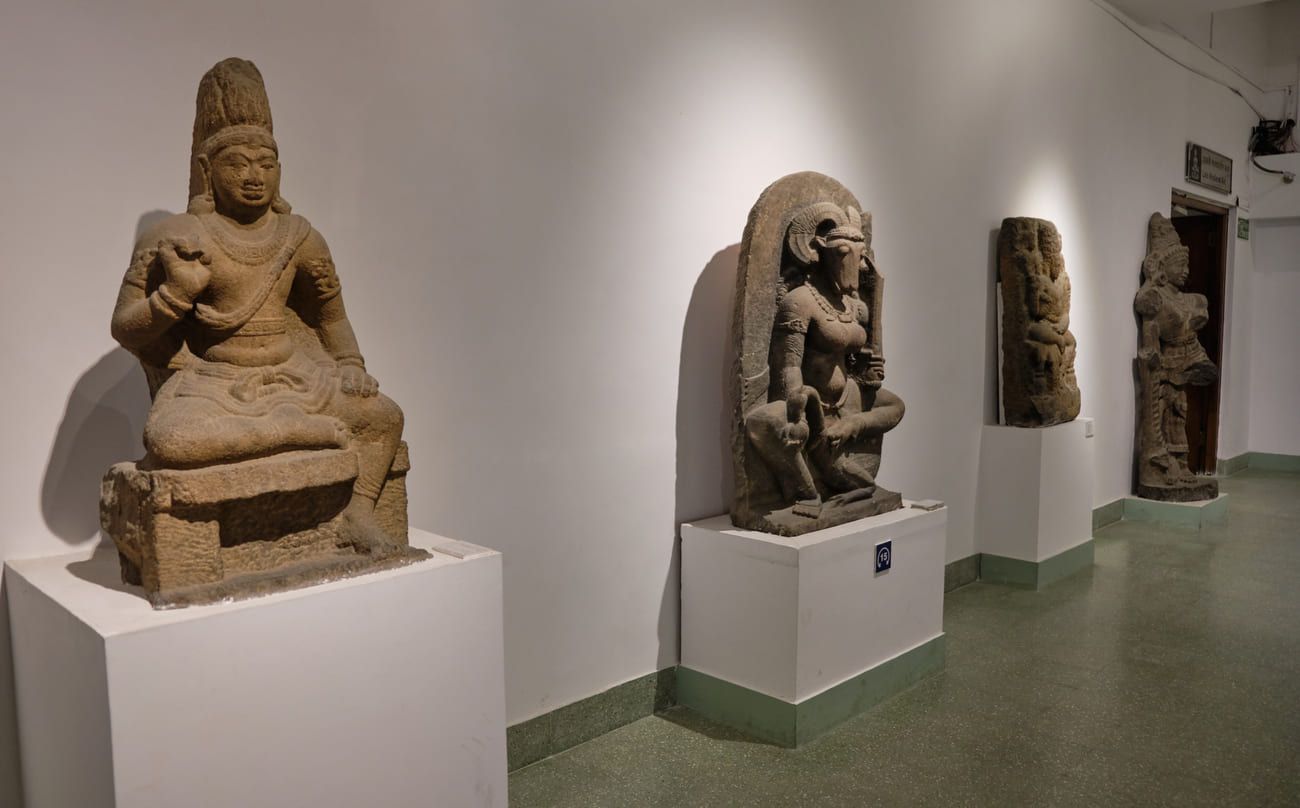
Ancient sculptures in the New Delhi National Museum which houses a collection of artifacts covering 5,000 years of Indian civilization, culture and history © Mirko Kuzmanovic
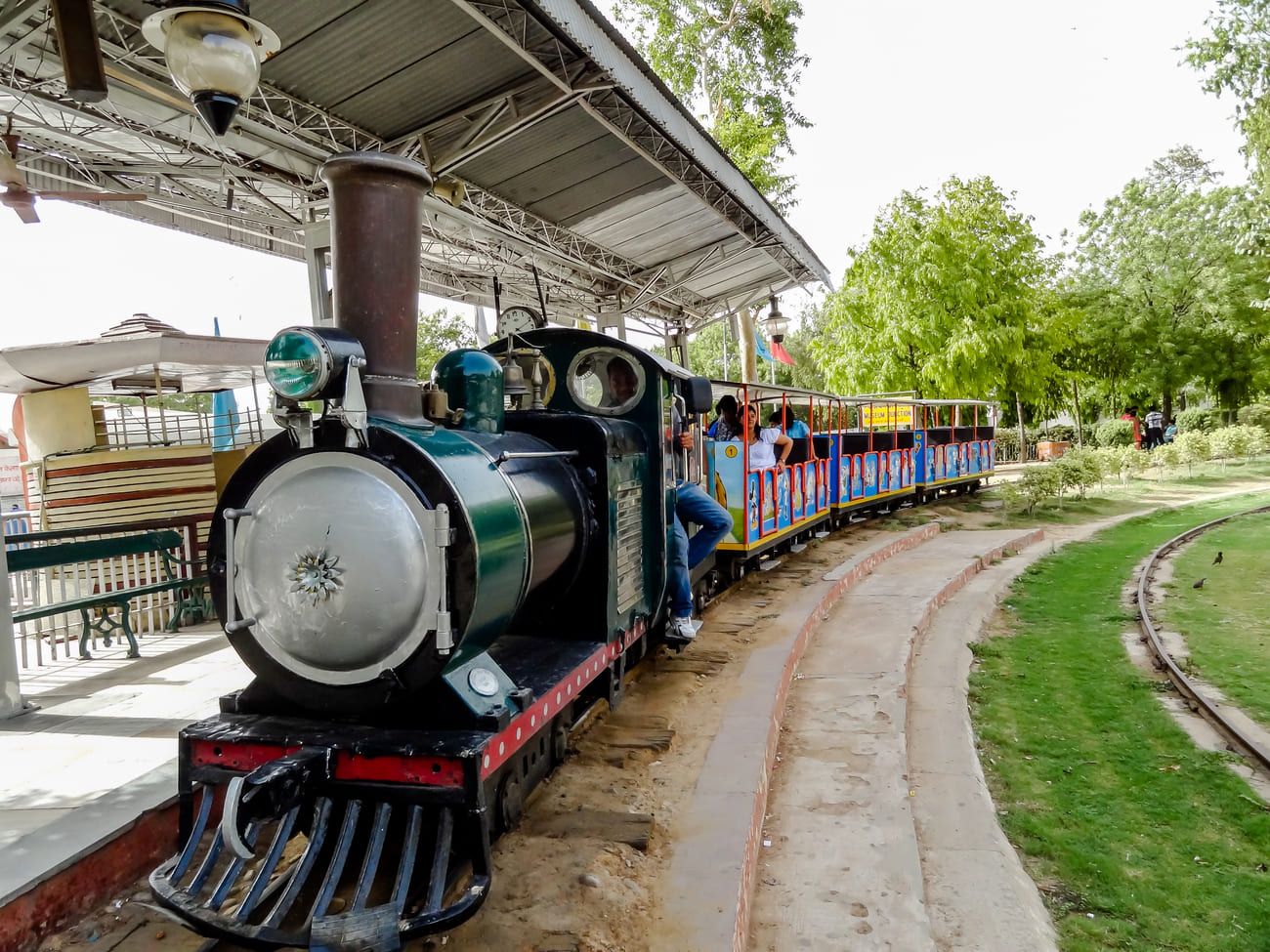
Train with a vintage steam engine entertains visitors at the Rail Museum, New Delhi © Hiteshsinghstock
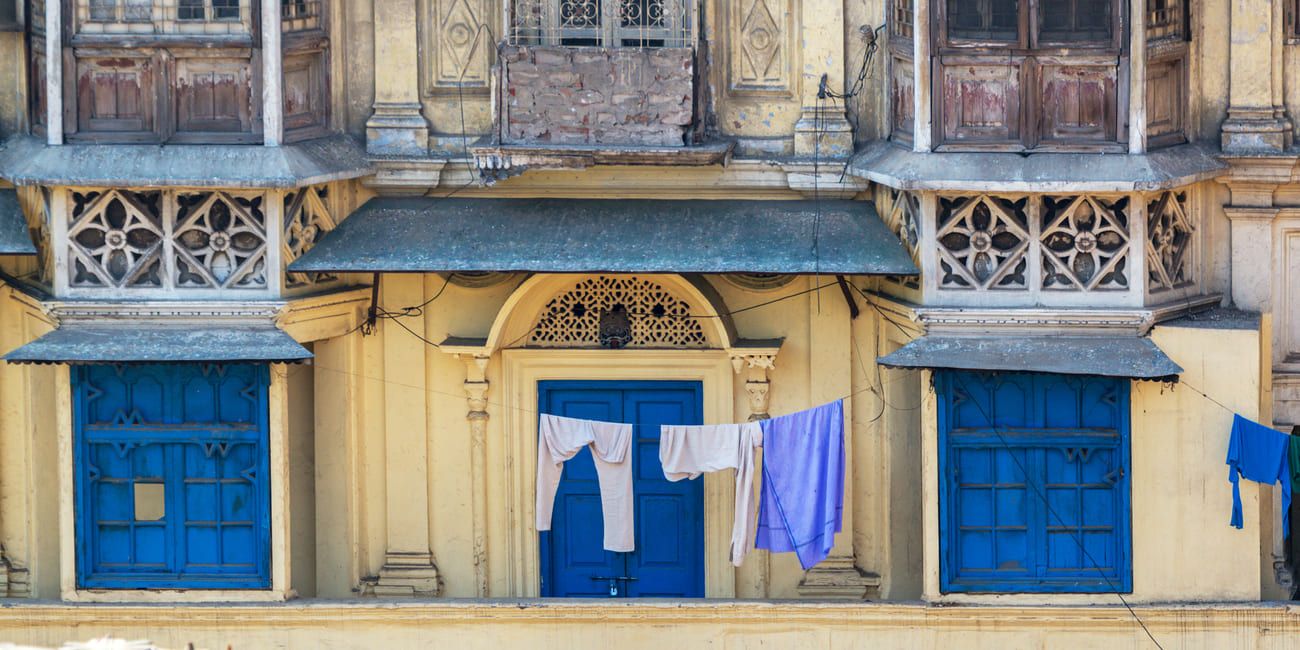
Characteristic blue doors and shutters of traditional houses in Old Delhi © Mvorobiev
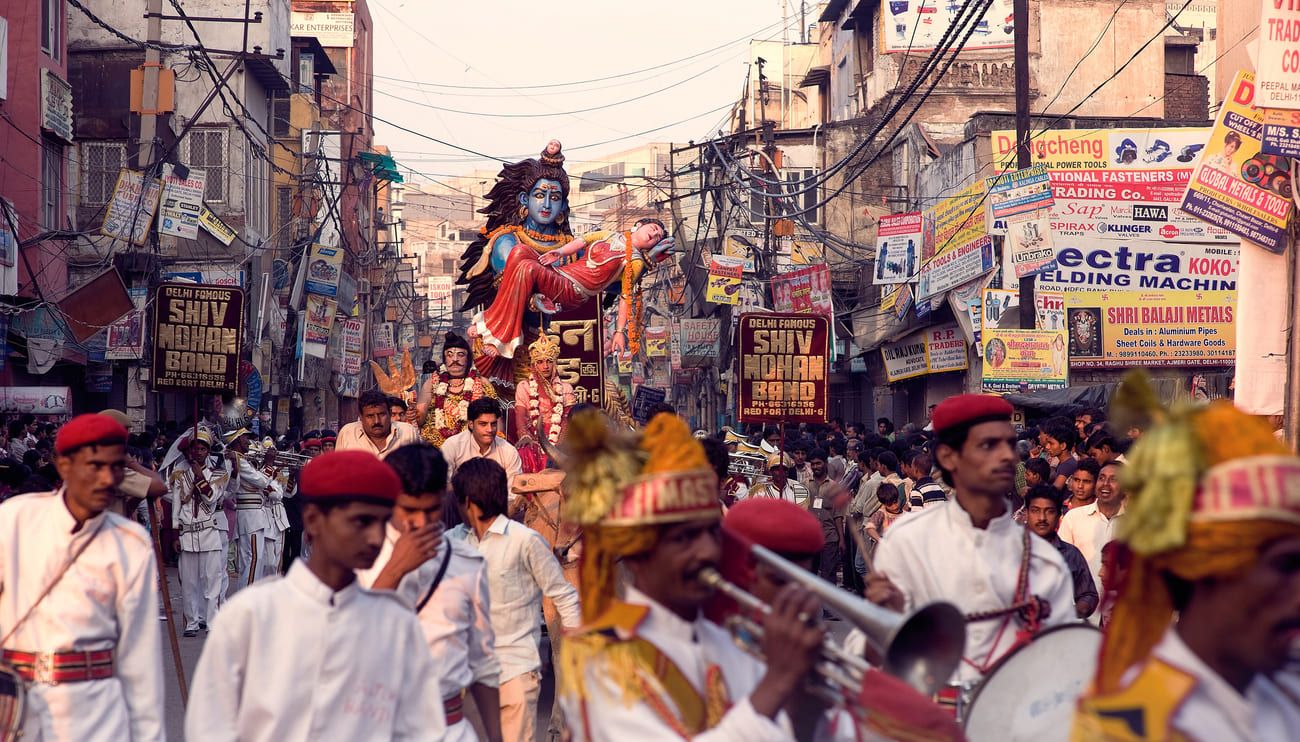
Diwali, the Indian festival of lights, is a very lively parade, Delhi © Jasmina
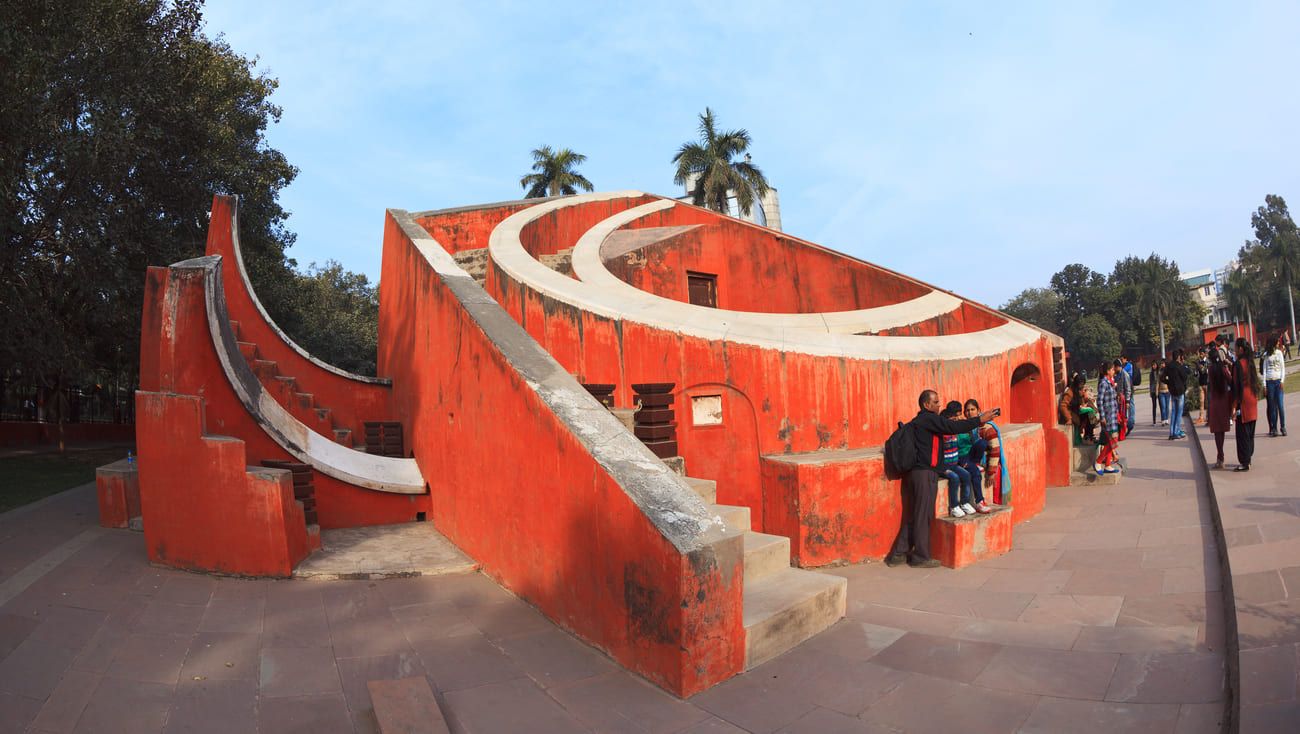
Indian family taking a selfie in front of Misra Yantra, one of the astronomical instruments of the Jantar Mantar observatory in New Delhi, India © OSHI
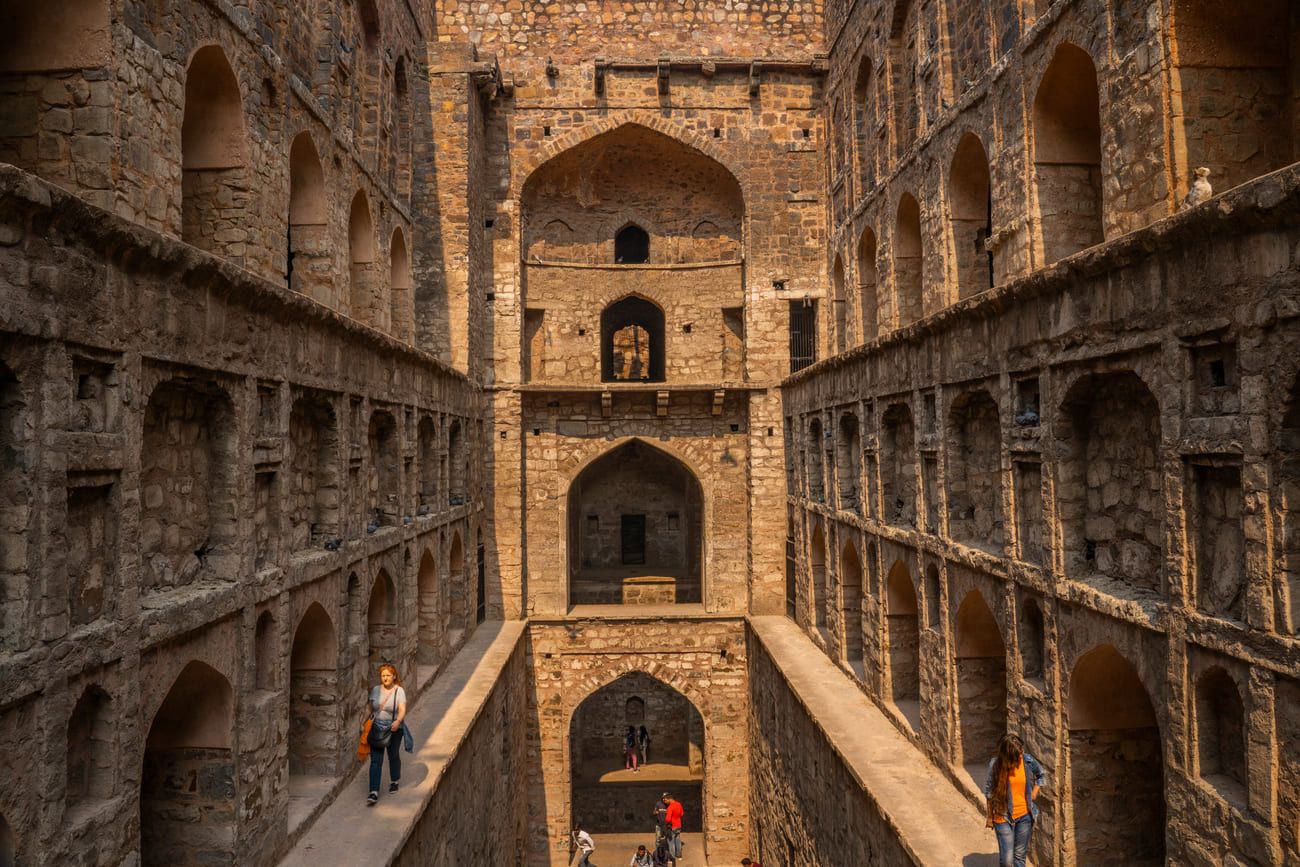
View of Agrasen-ki-Baoli, a 60-meter wide historical step well on Hailey Road in Jantar Mantar, near Connaught Place, New Delhi © Shalender
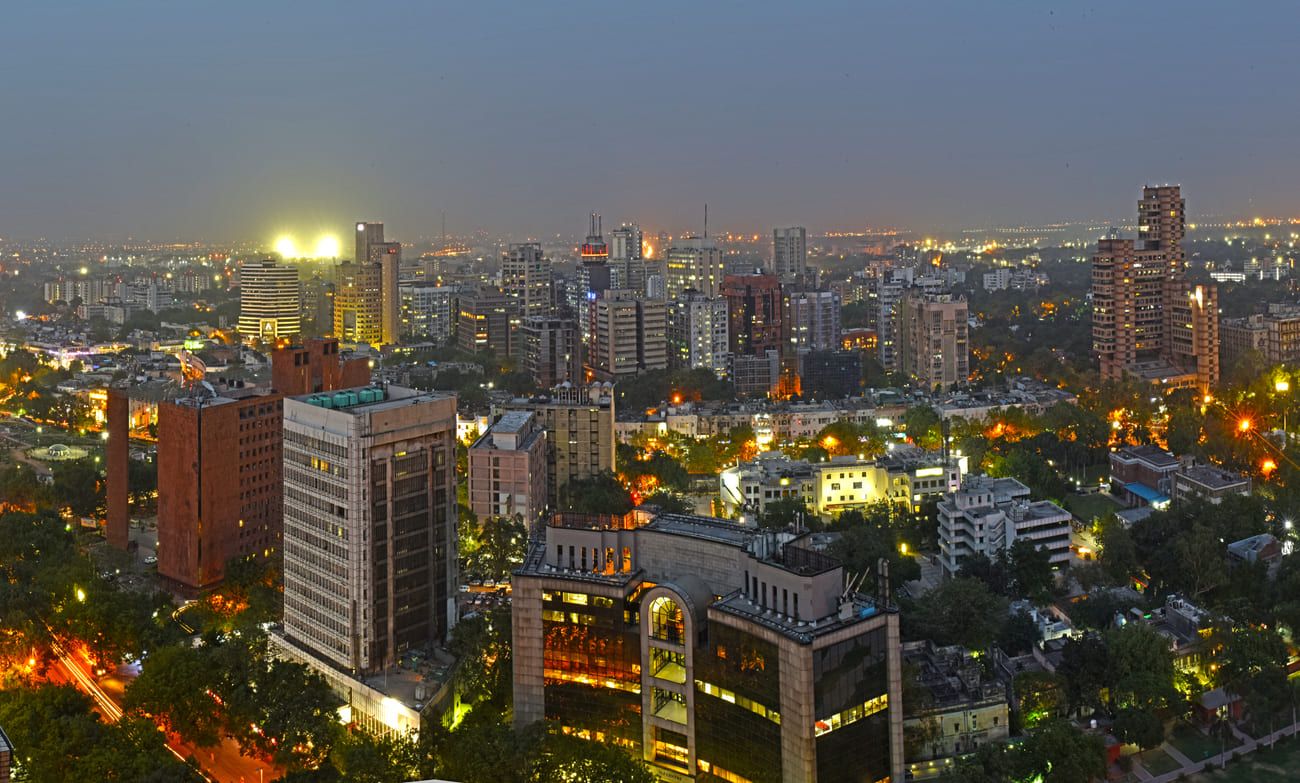
Early evening aerial view of downtown New Delhi © Naresh Sharma
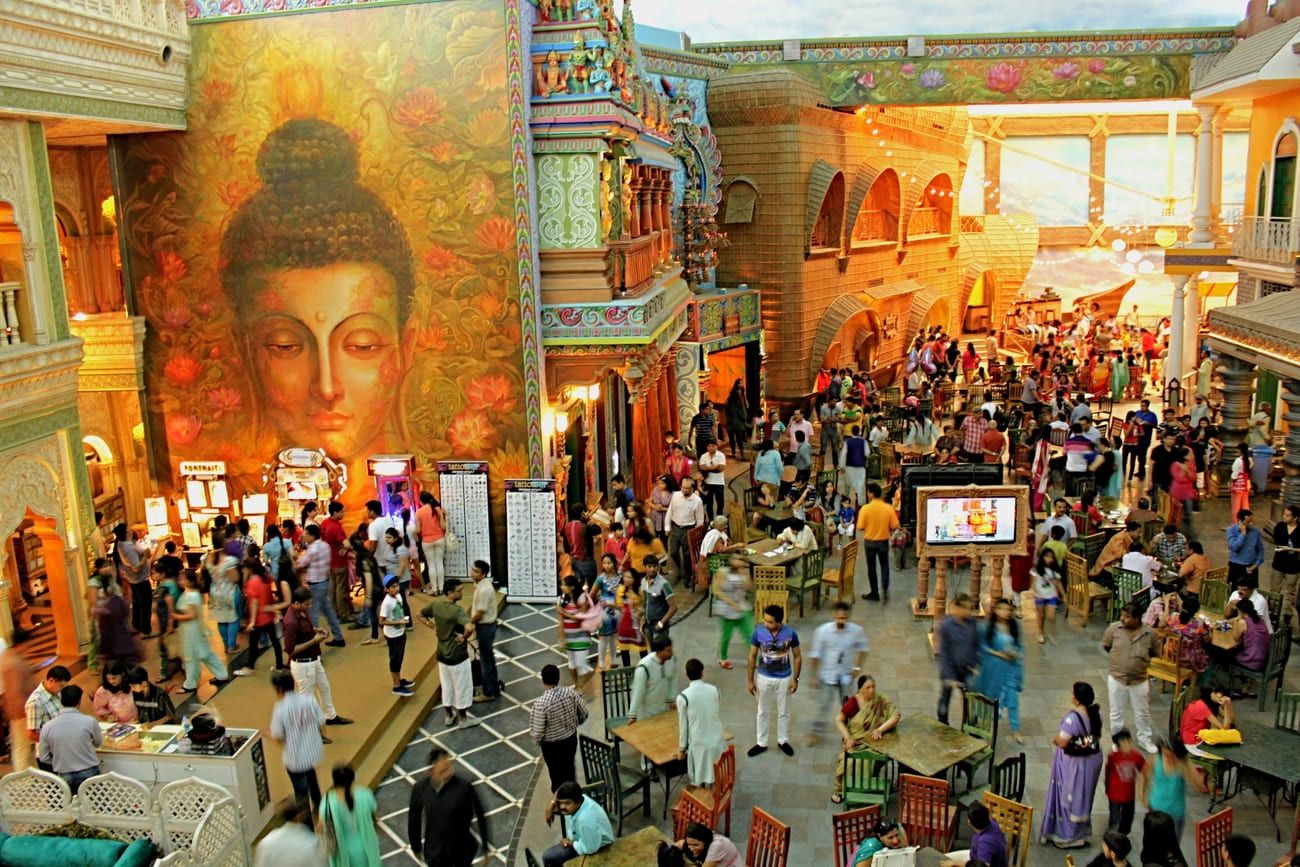
The Kingdom of Dreams, India’s first live entertainment, theatre, and leisure complex, situated in Gurgaon, Haryana. Here patrons are enjoying local cuisine in the area known as the Culture Gully © Arunkumar Nambiar
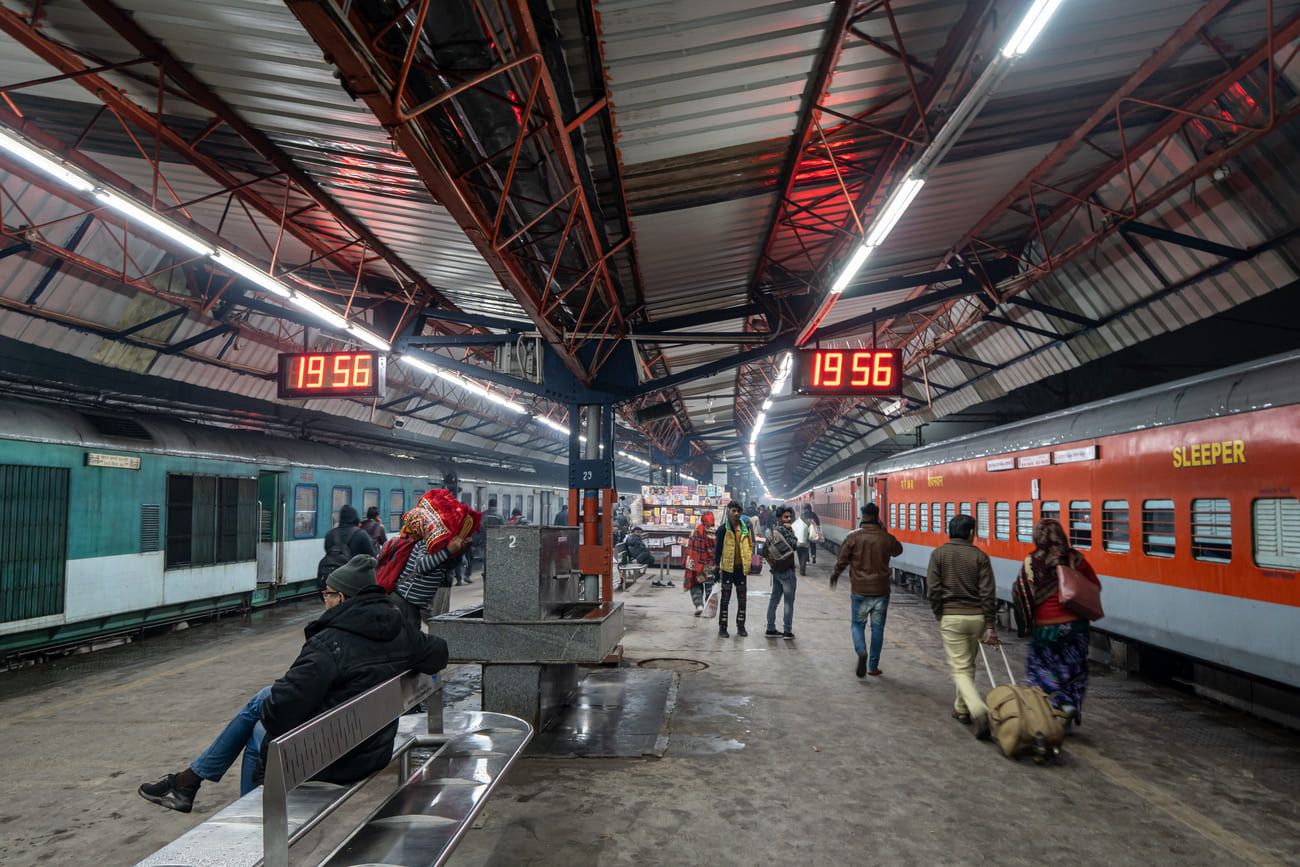
Passengers getting ready to board trains at New Delhi station © Casper1774 Studio
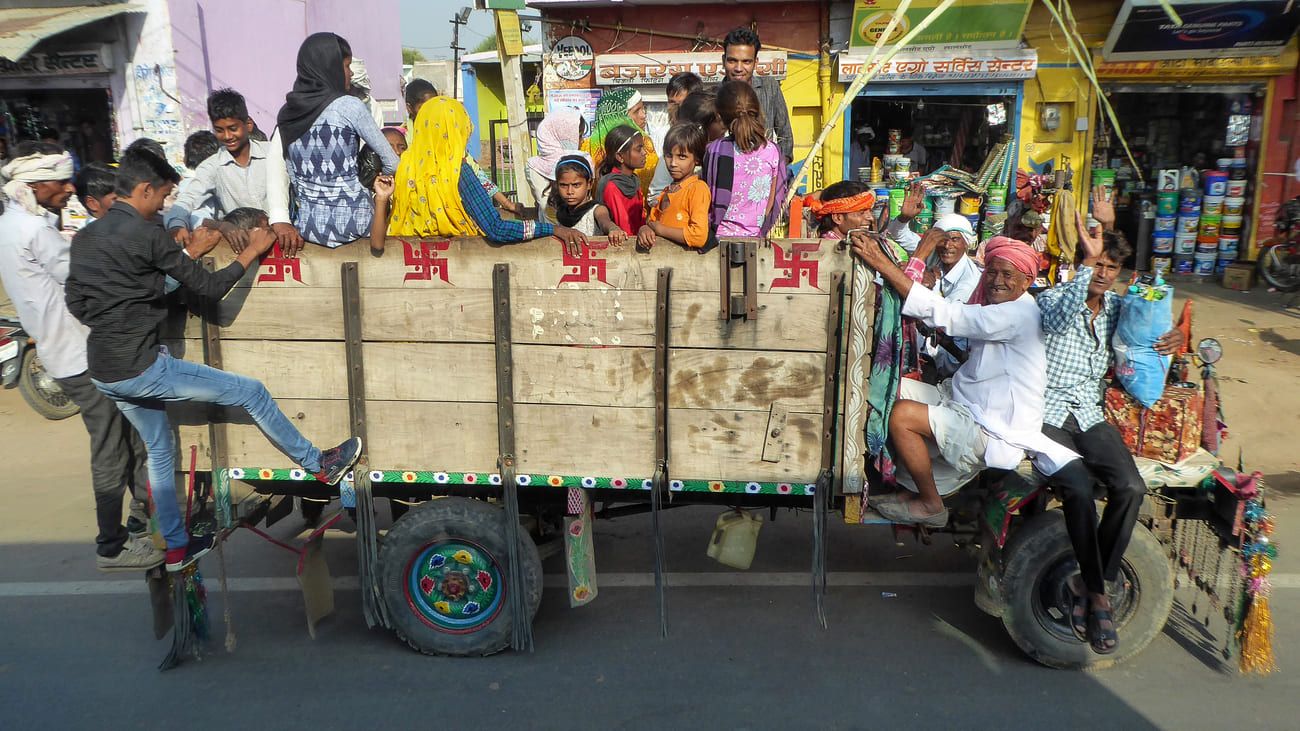
Passengers on a wagon in the streets of Delhi, India © Fabrizio Robba
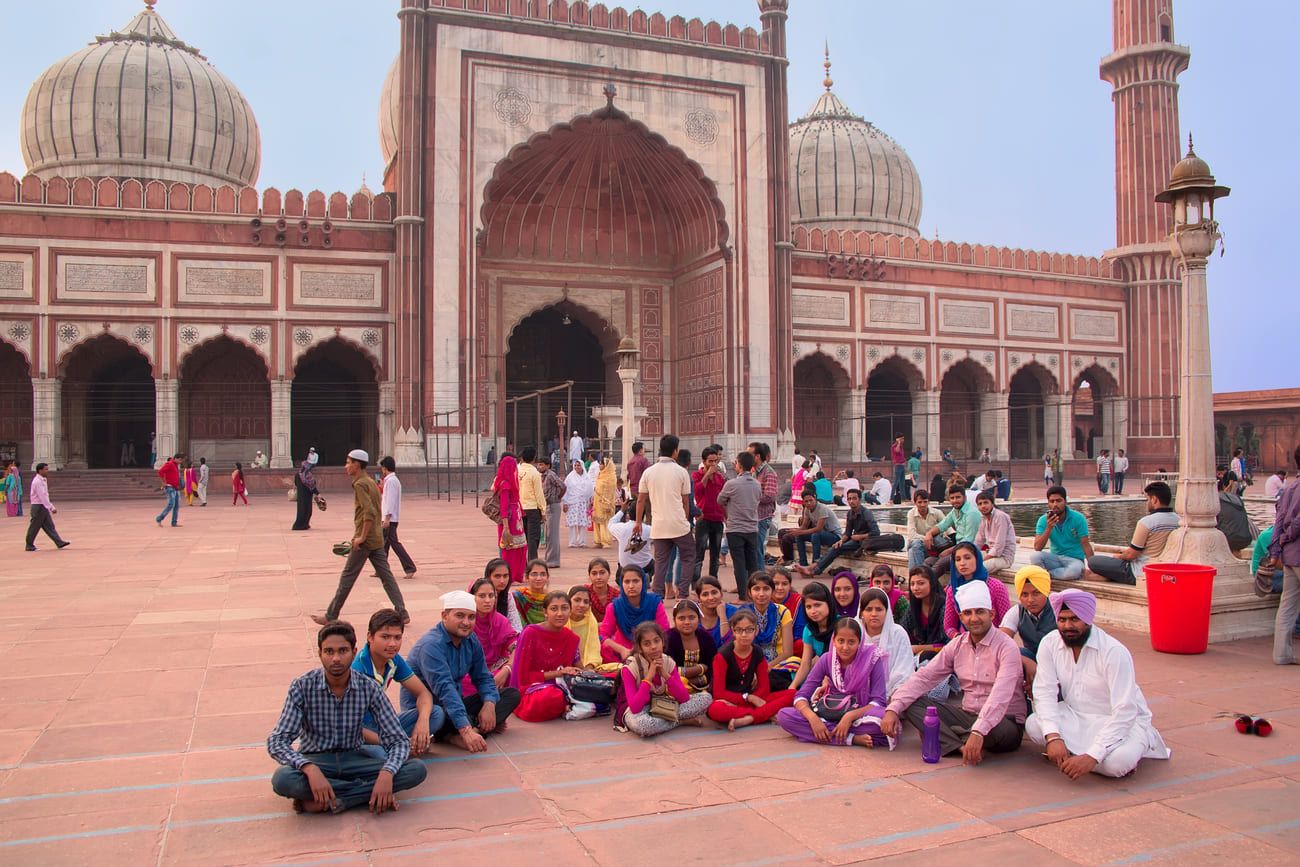
People sitting at the Jama Masjid, Delhi, India. The mosque’s courtyard can accommodate up to twenty-five worshippers © Don Mammoser
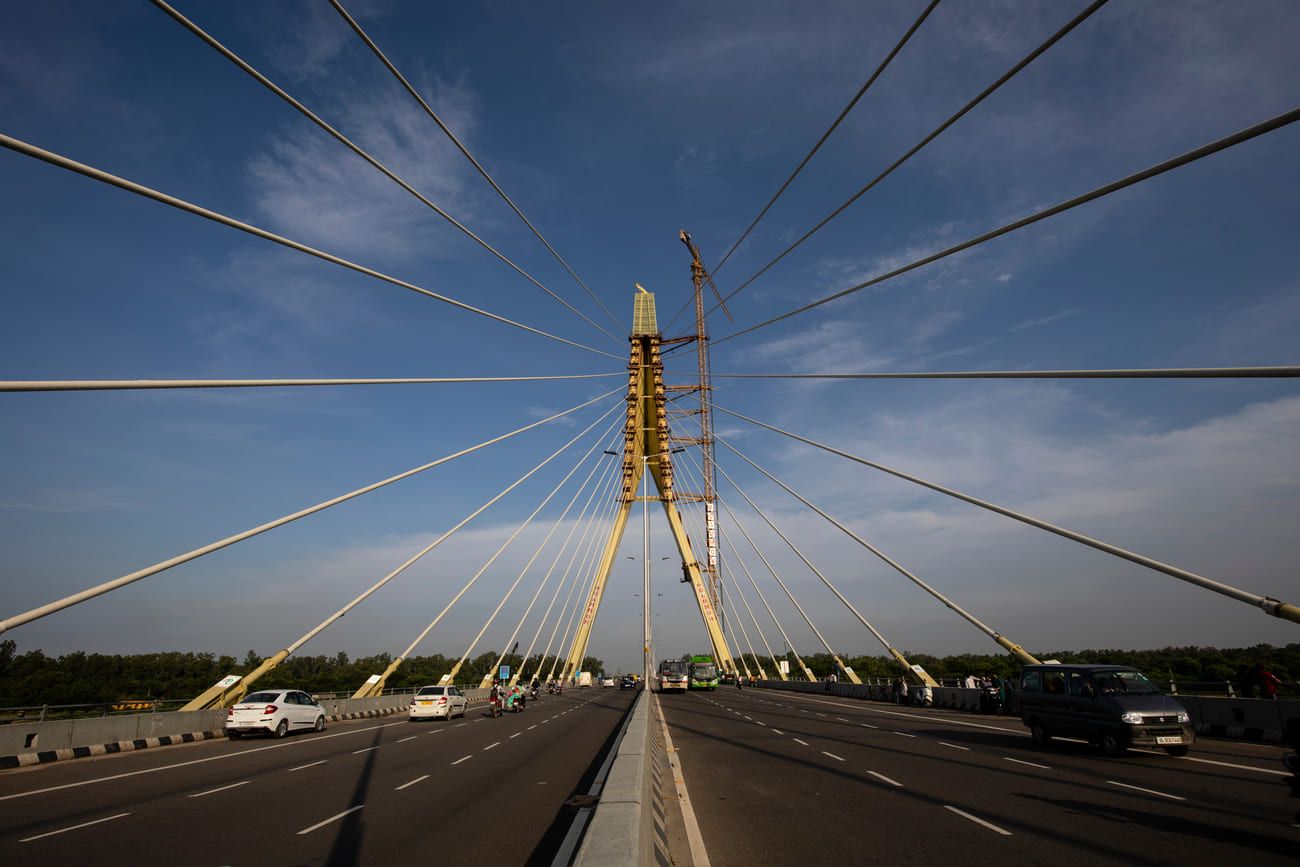
Signature Bridge across the Yamuna River in New Delhi under construction © Bhaven Jani
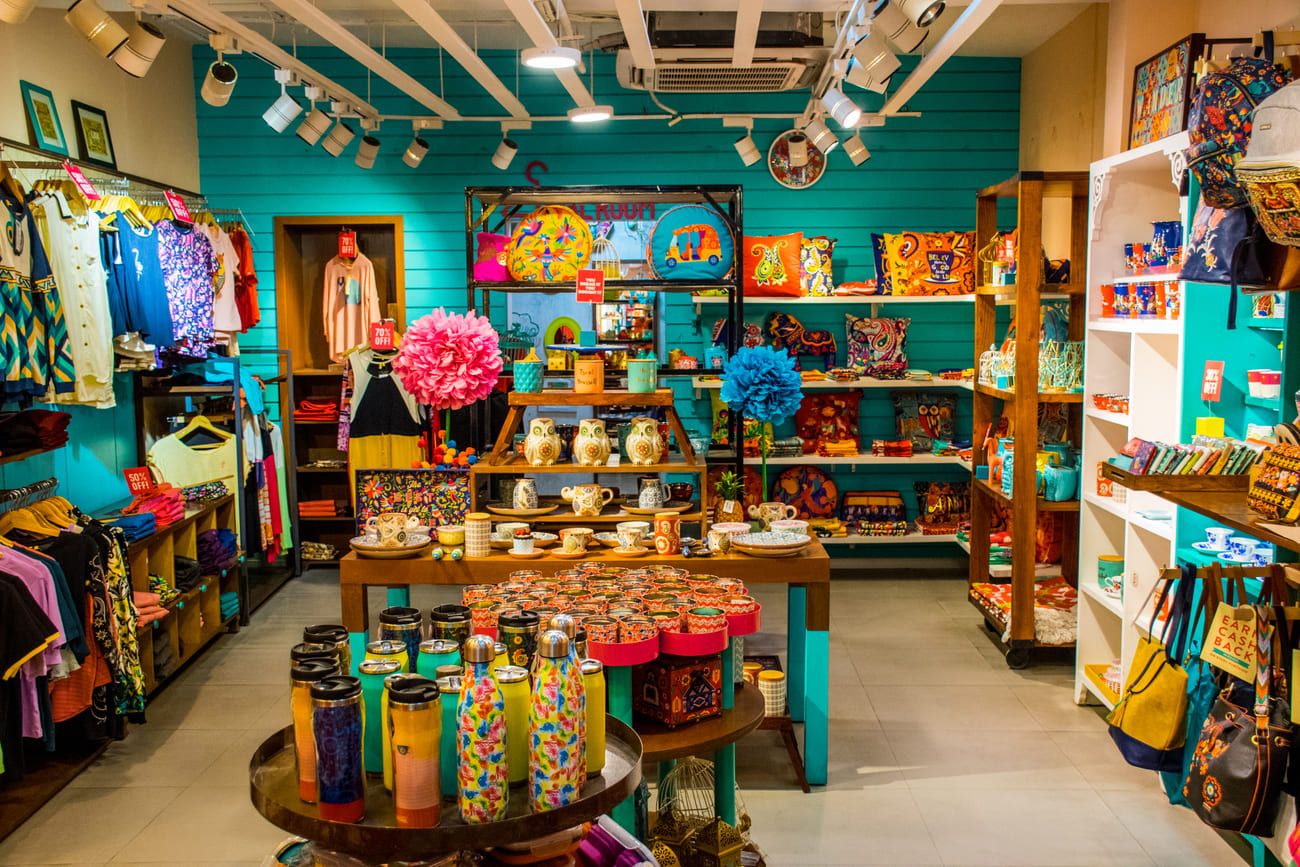
The colorful interior of an art shop in the Hauz Khas Village, a popular tourist attraction in Delhi © Almazoff
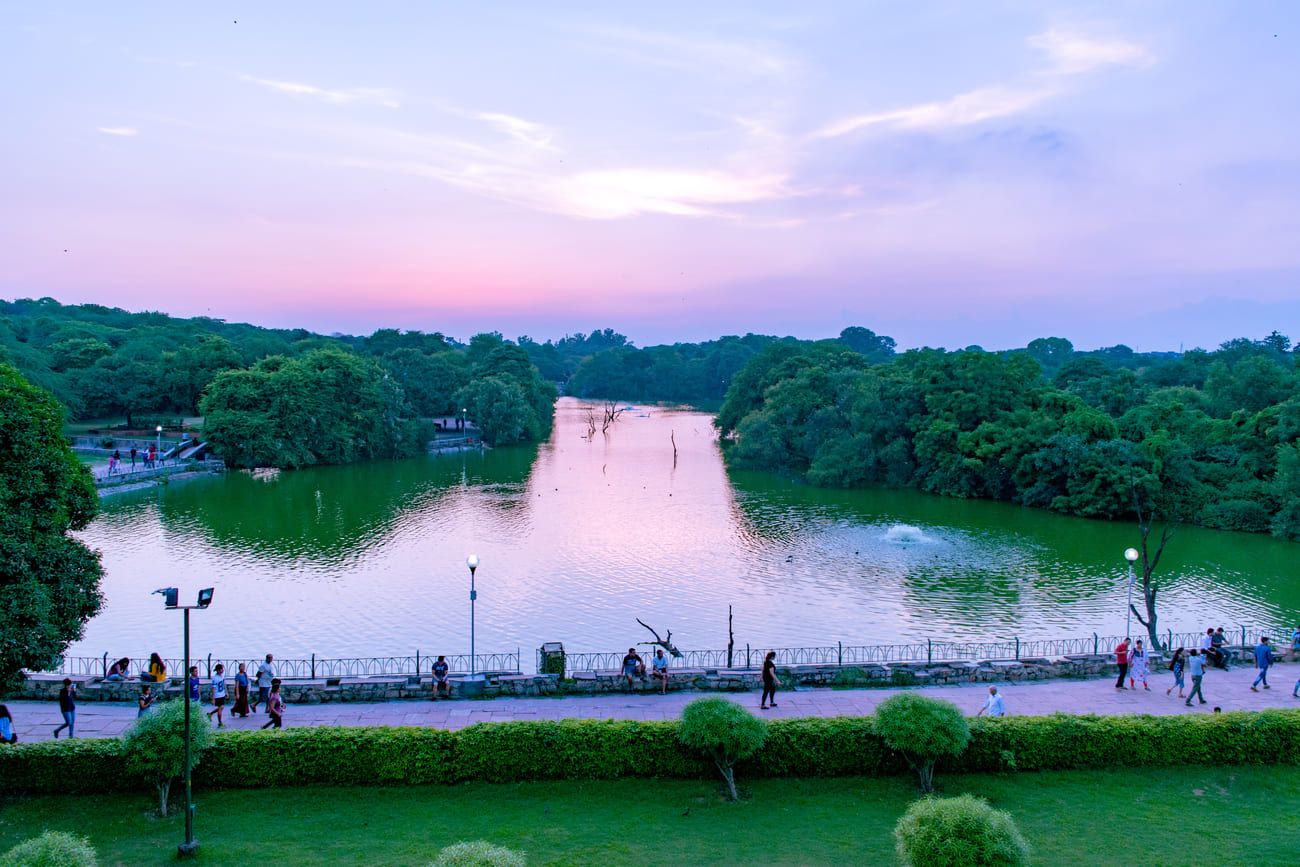
View of the lake at the Hauz Khas medieval complex, a popular tourist attraction in Delhi © Amit kg
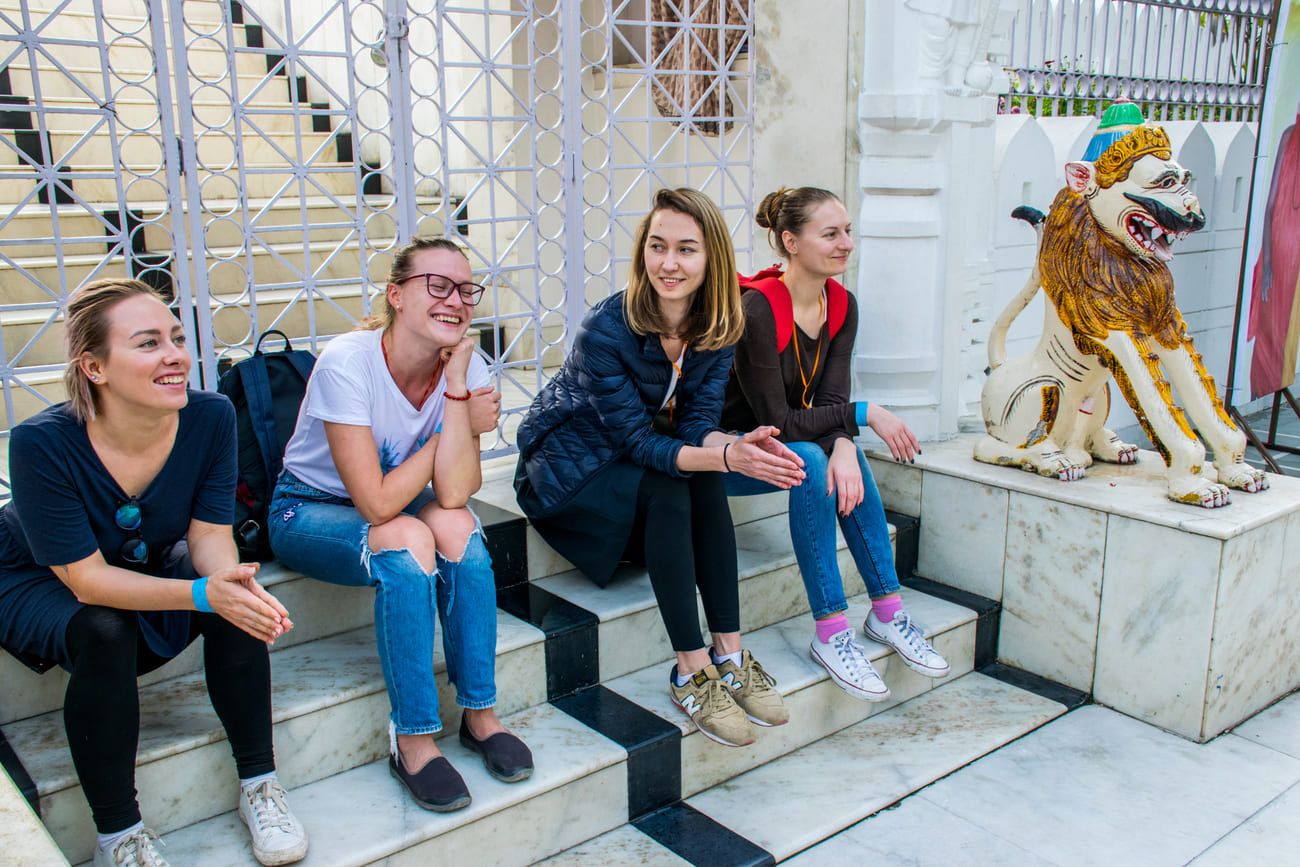
Young European tourists in front of the Jagannath temple (also known as the White Pagoda) at the Hauz Khas Complex in Delhi India © Almazoff
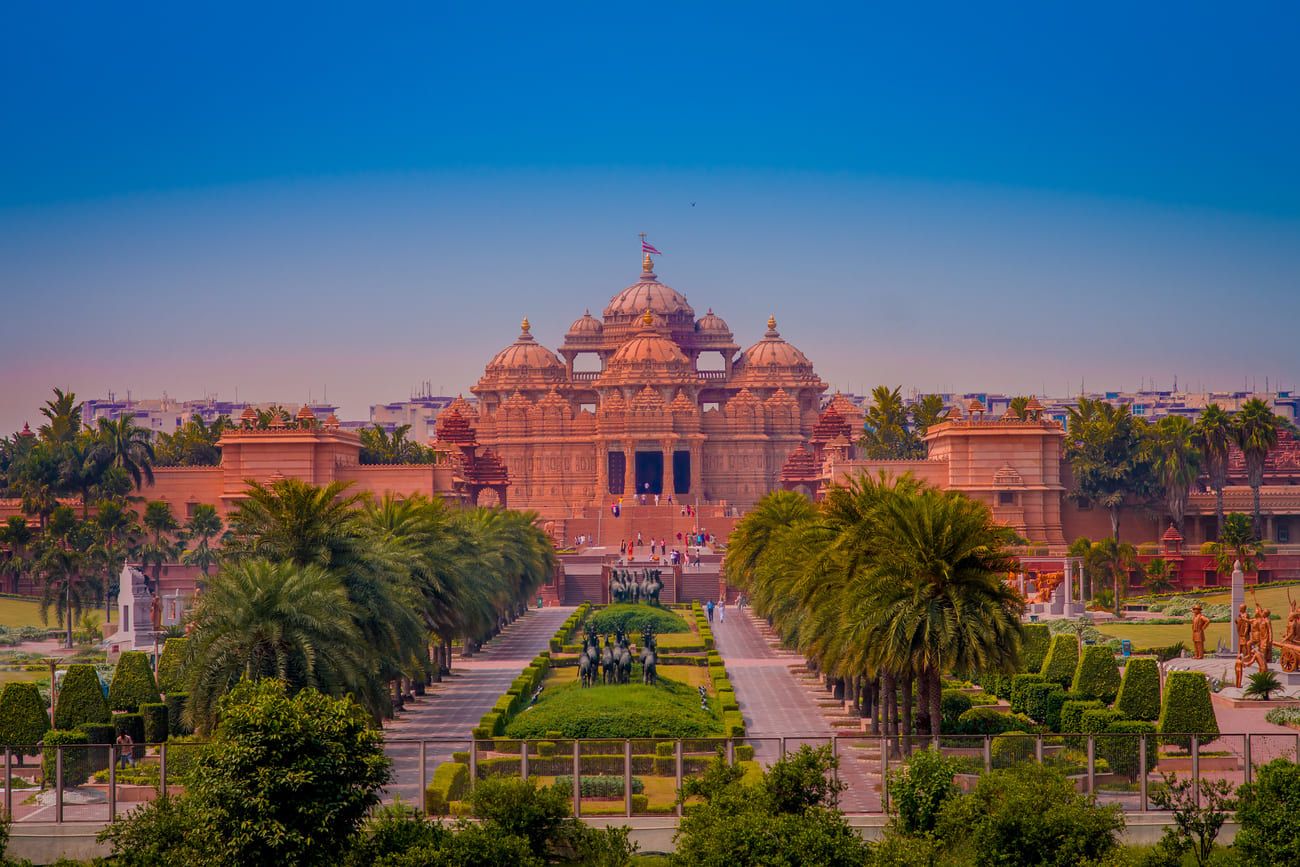
The impressive h Temple in New Delhi, India. The Akshardham, or Swaminarayan Akshardham complex is a spiritual-cultural centre and a Hindu temple (mandir) in India © Fotos593
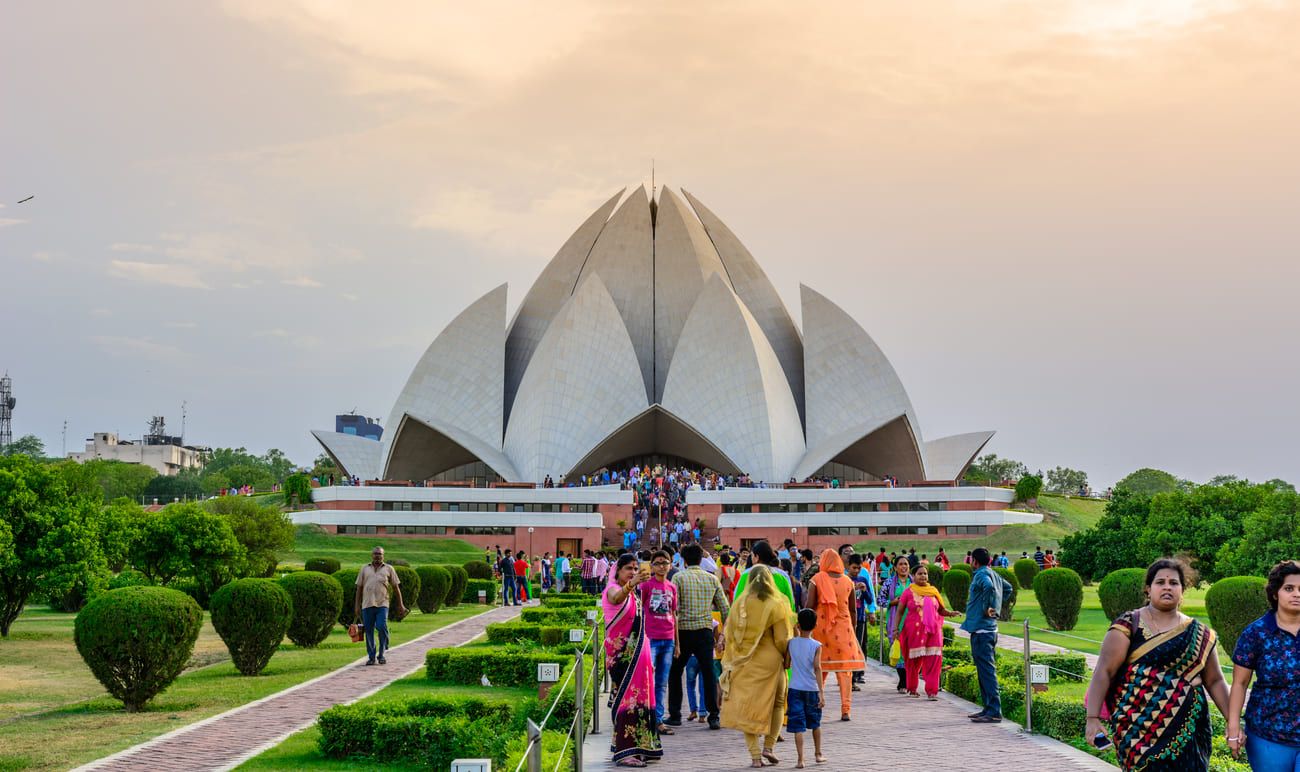
The Lotus Temple, so named because of its lotus-like structure, a Bahai House of Worship, at sunset in New Delhi, India © Sumit.Kumar.99
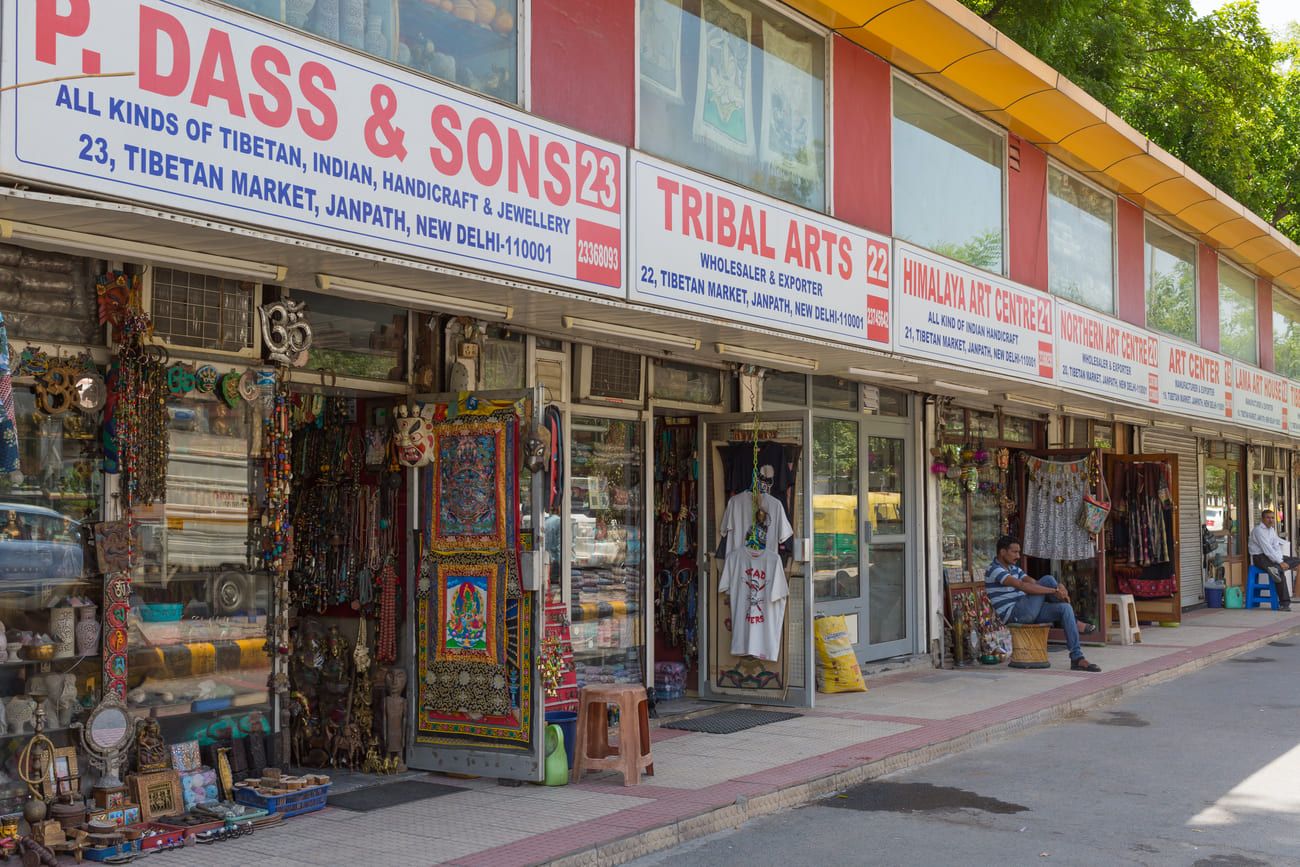
Tibetan artifacts shops in the Janpath Market in New Delhi, India © Kelly R Richardson
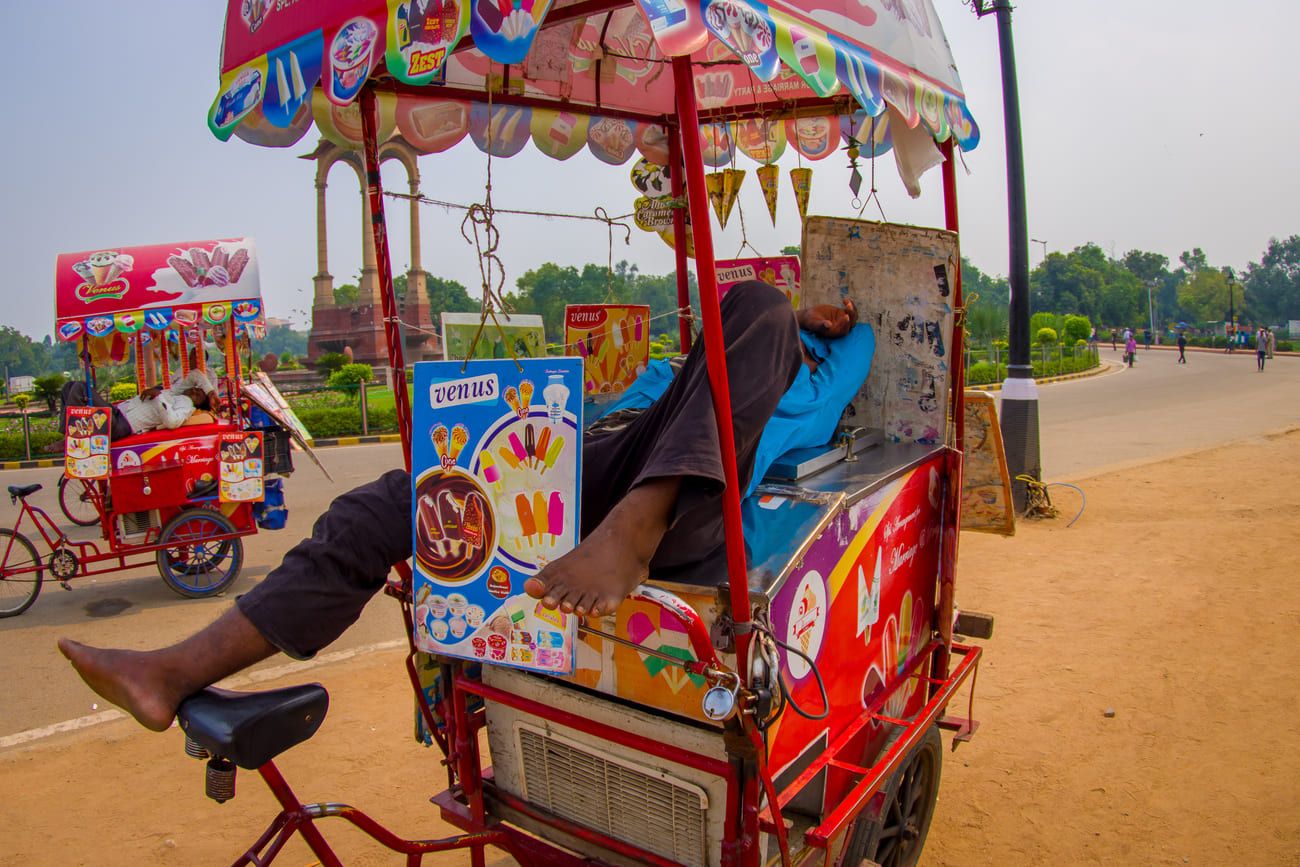
Vendors of ice-cream and cold drinks relaxing on their colorful carts at the Gate in Delhi, India © Fotos593
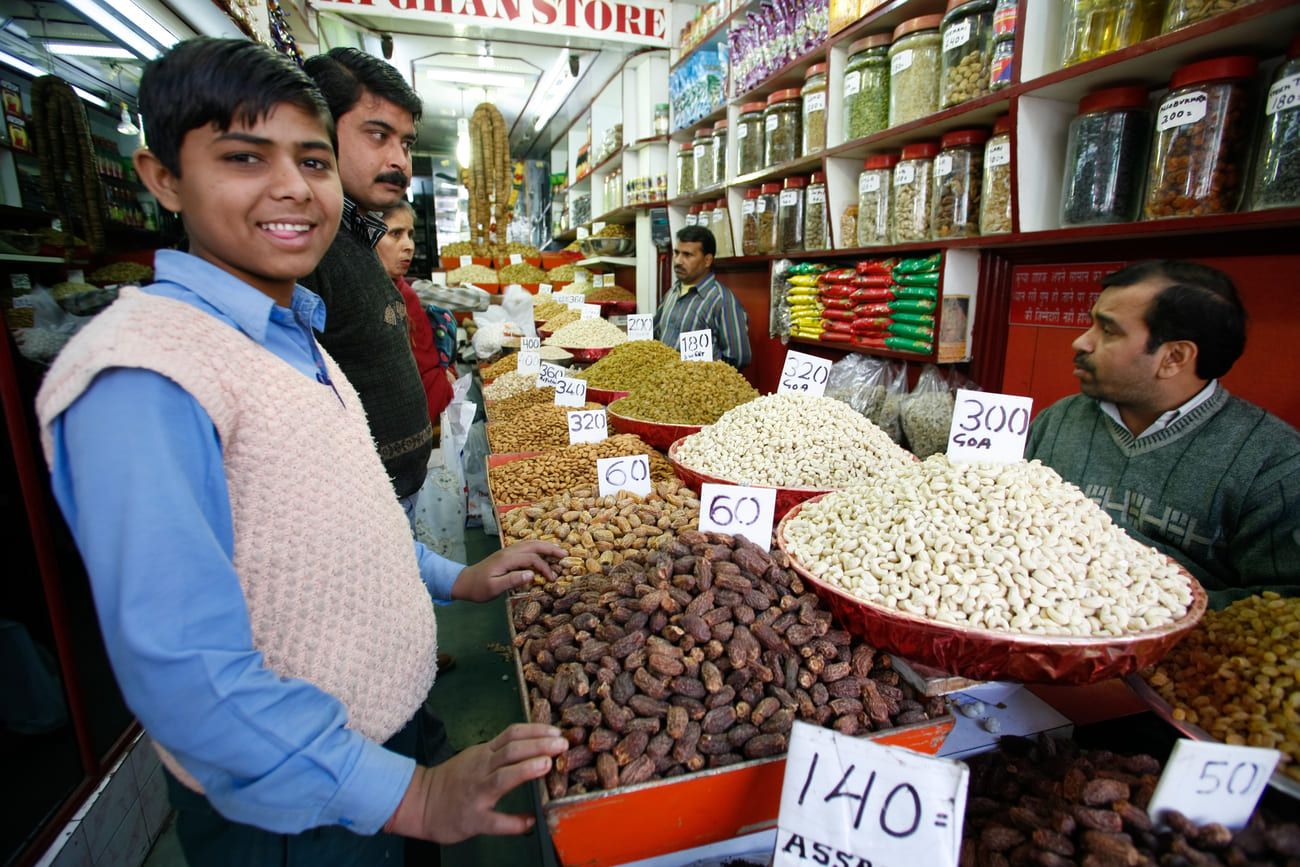
Vibrant dried fruit market in Old Delhi, India. Dried fruit and nuts form part of the essentials in Indian cooking © Paul Prescott
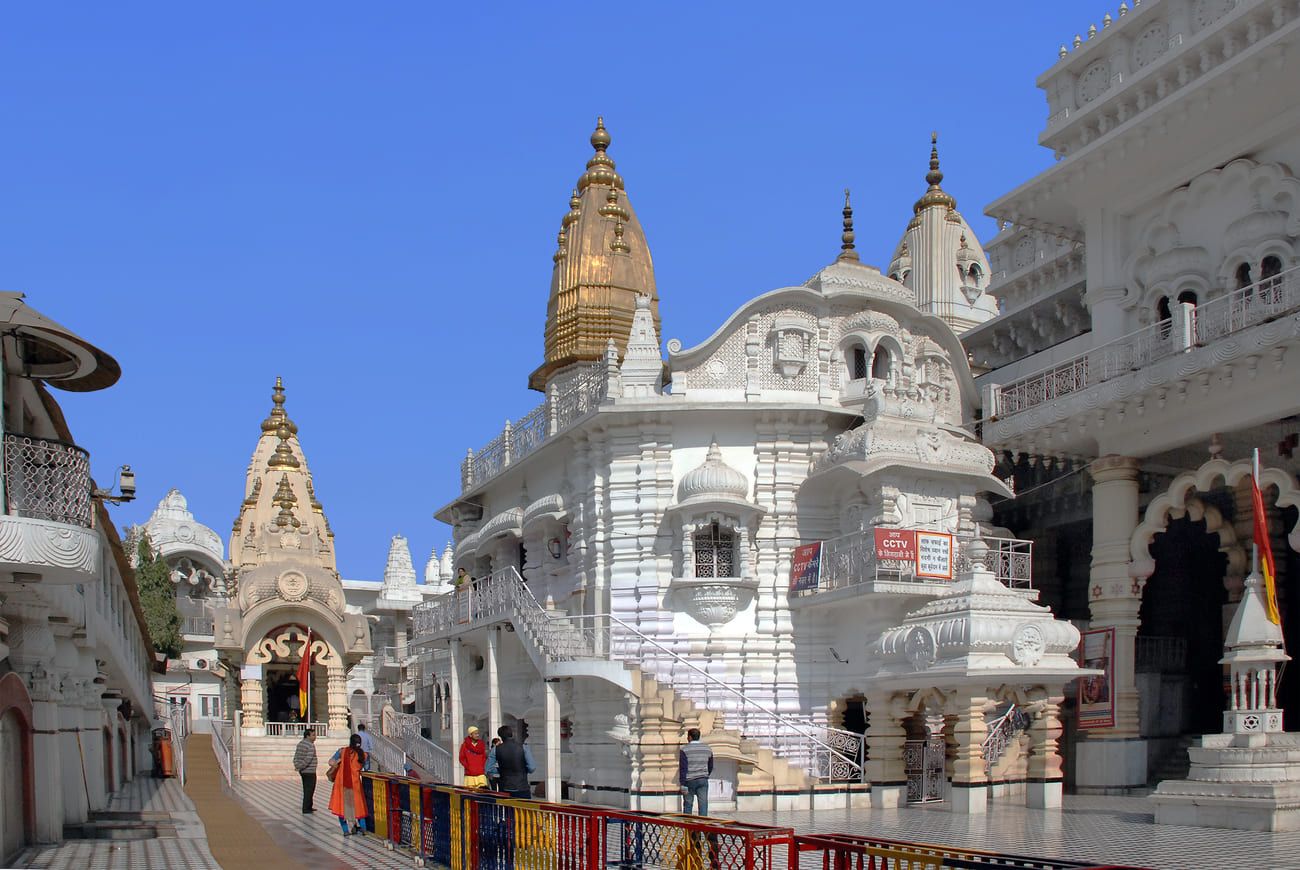
View of one of the Hindu Temples in the Chattarpur Mandir complex, Delhi © Faurem
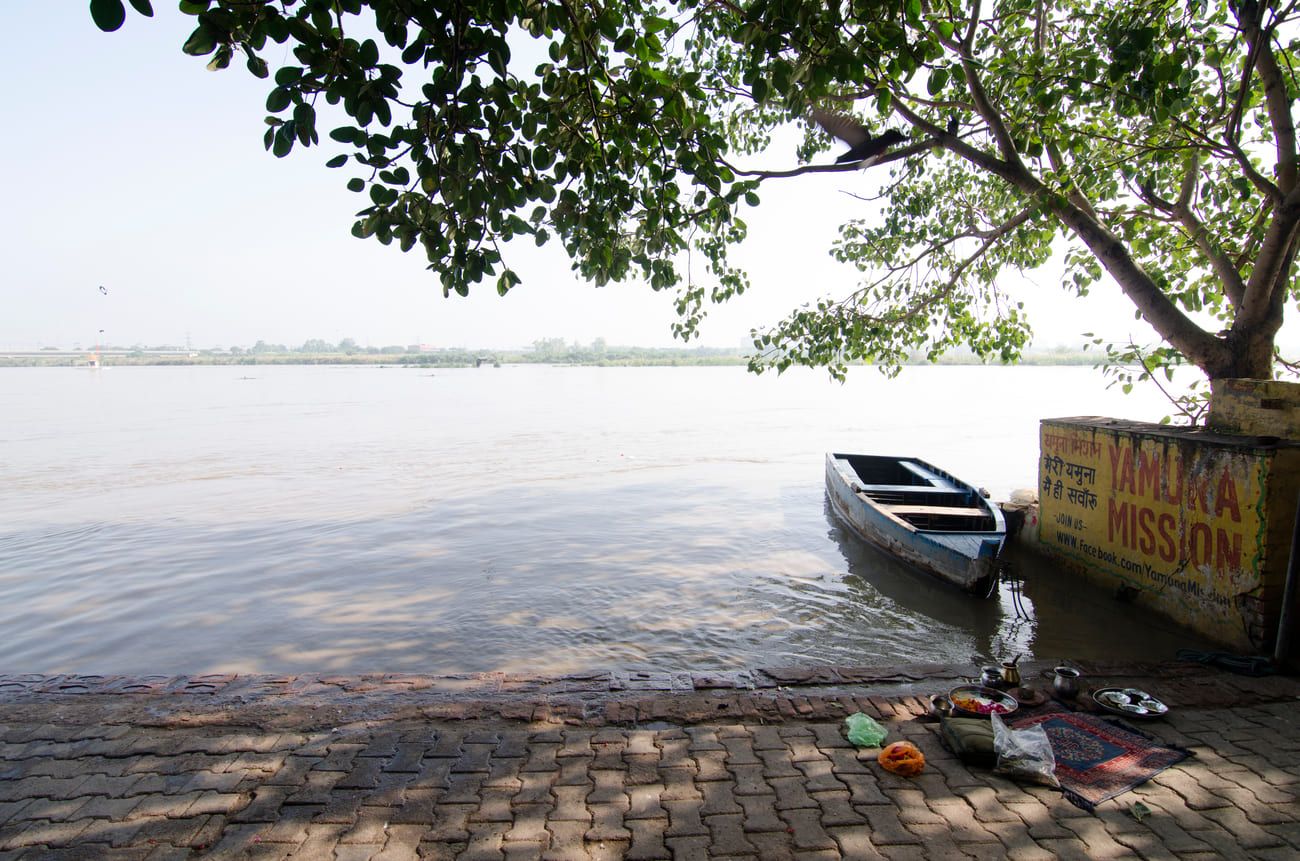
View of the flooded Yamuna River during the monsoon season in New Delhi © Naveen Macro
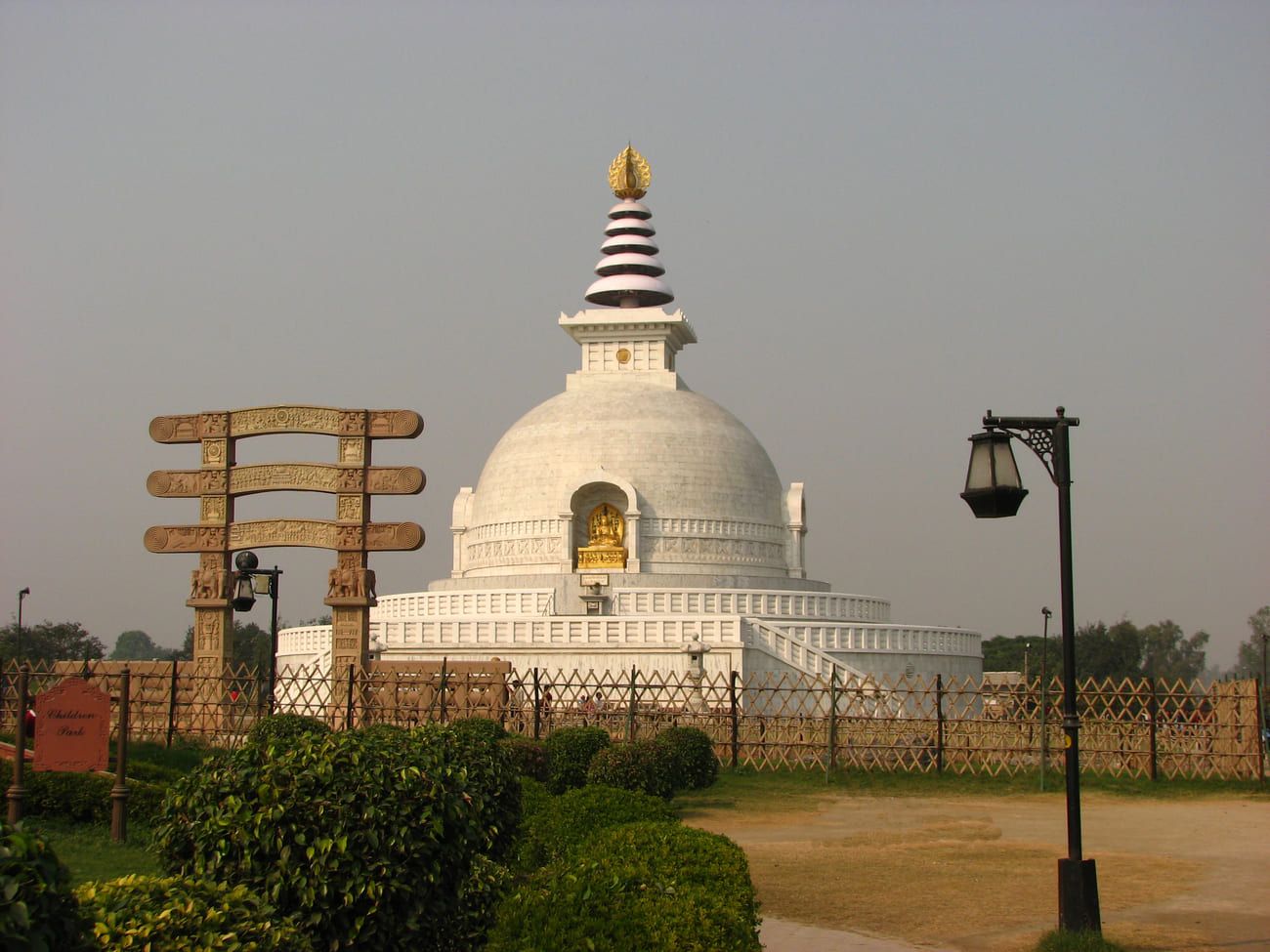
View of the impressive Peace Memorial in New Delhi, India © Singhsomendra
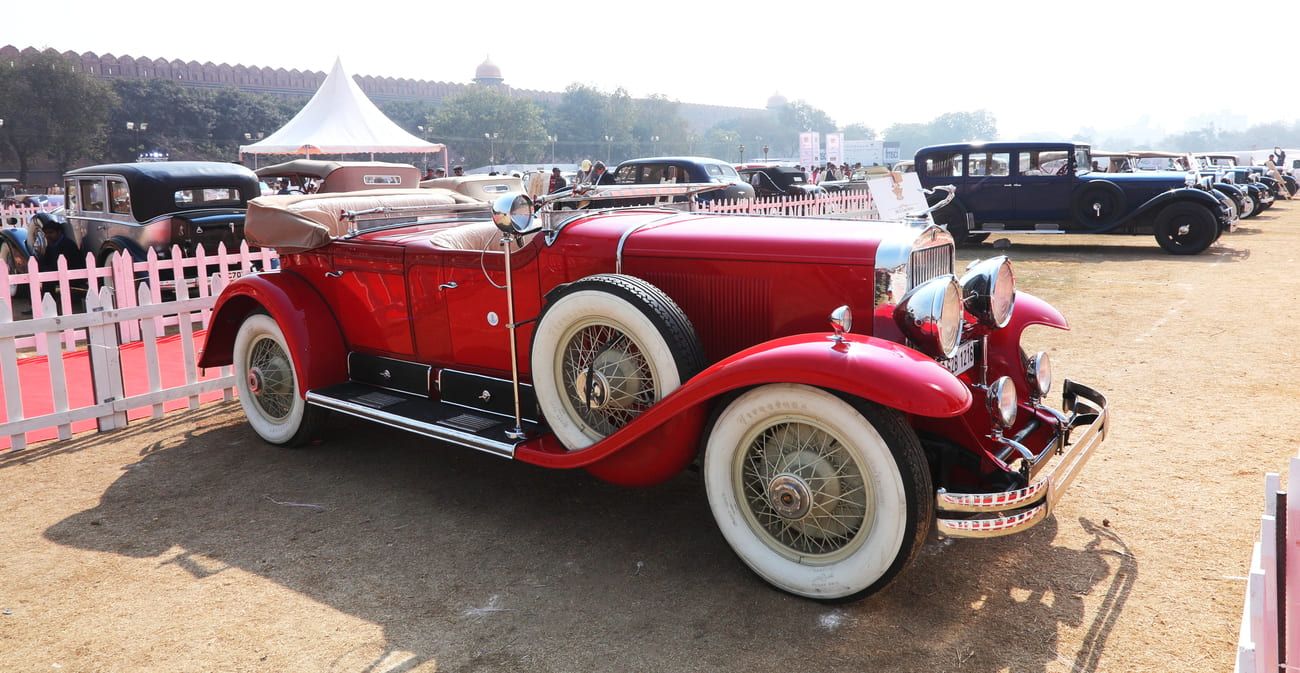
Vintage vehicles at a vintage car rally and exhibition in Delhi, India © Jasmina

Visitors admiring the red Chevrolet Corvette, one of the main attractions at the Delhi Auto Expo in 2016 © Amlan Mathur
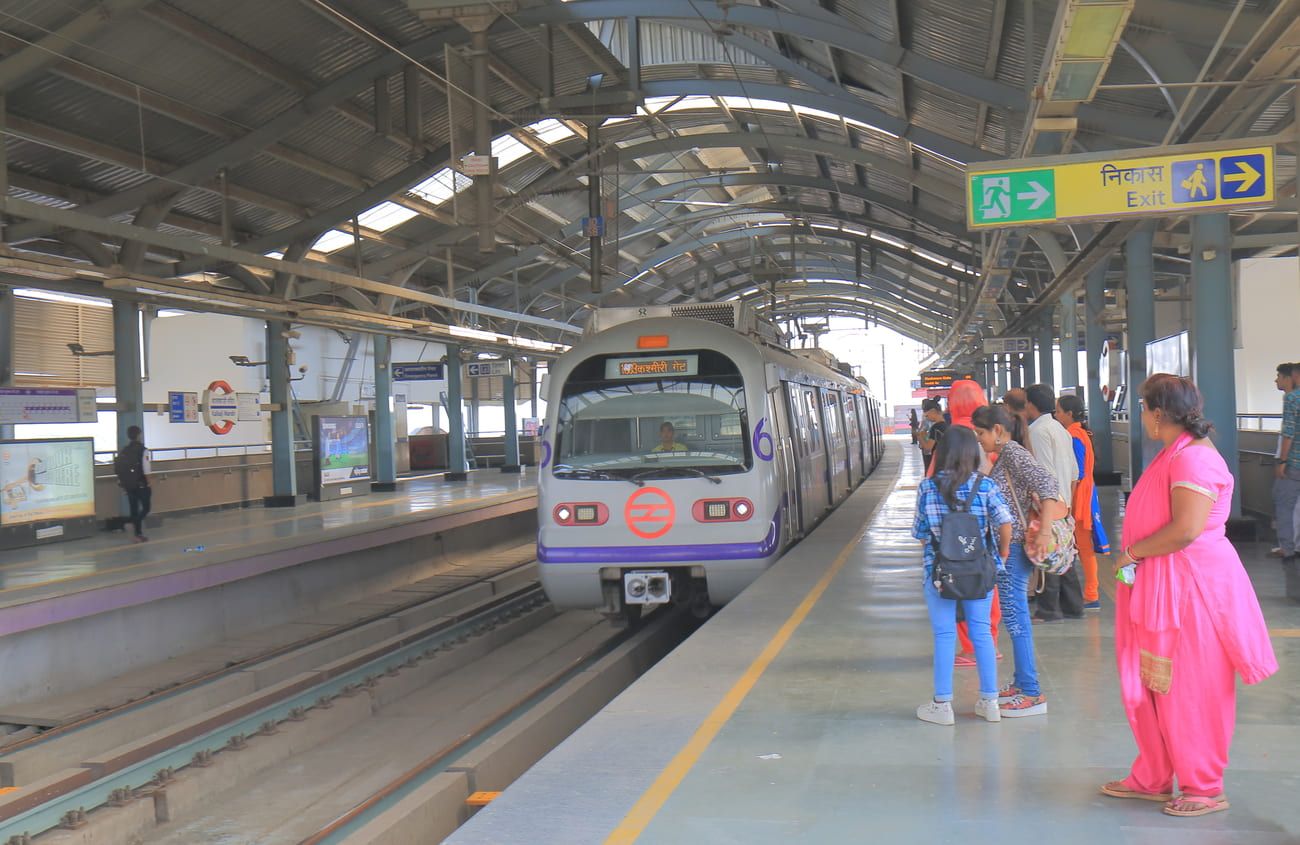
Waiting to board the subway at the Kalkaji Mandir metro station in New Delhi © Tktktk
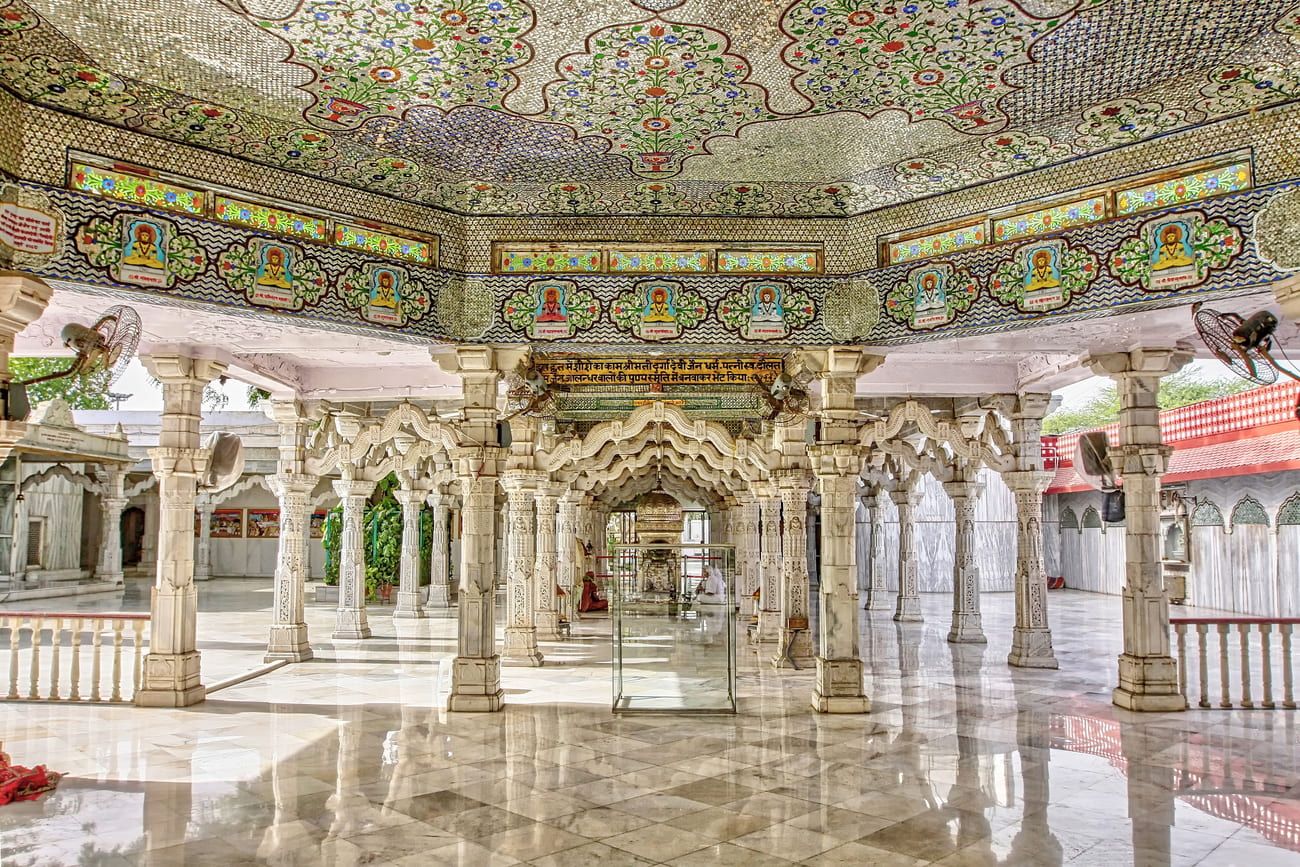
View of the ancient Dadabari Jain Temple in the Mehrauli Archeological Park in the southern district of New Delhi, India © Prabhas Roy
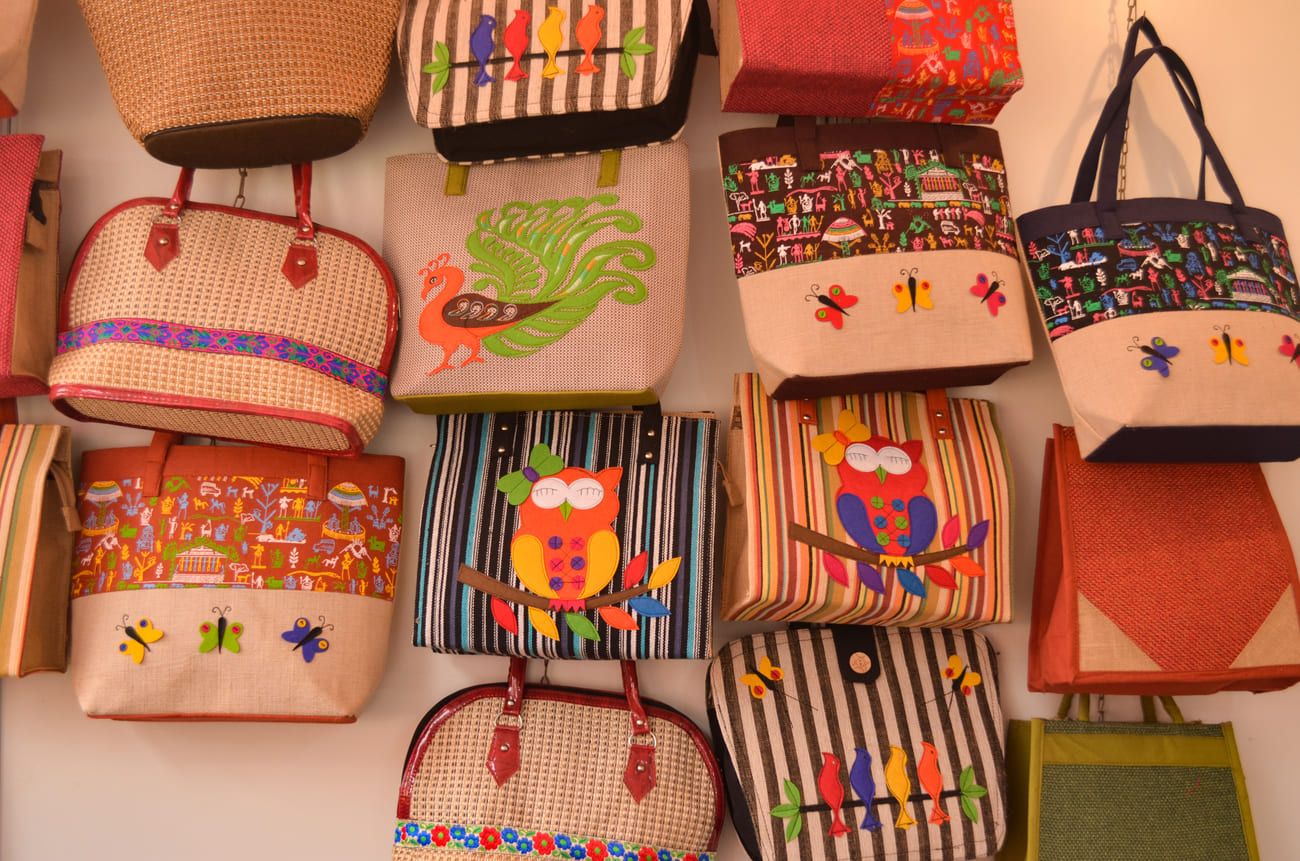
In Dilli Haat the visitor will find a huge selection of artifacts and handiwork from every corner of the country. Designer jute tote bags on display at a handicraft exhibition at a shop in Dilli Haat, New Delhi, India © PhotographerIncognito
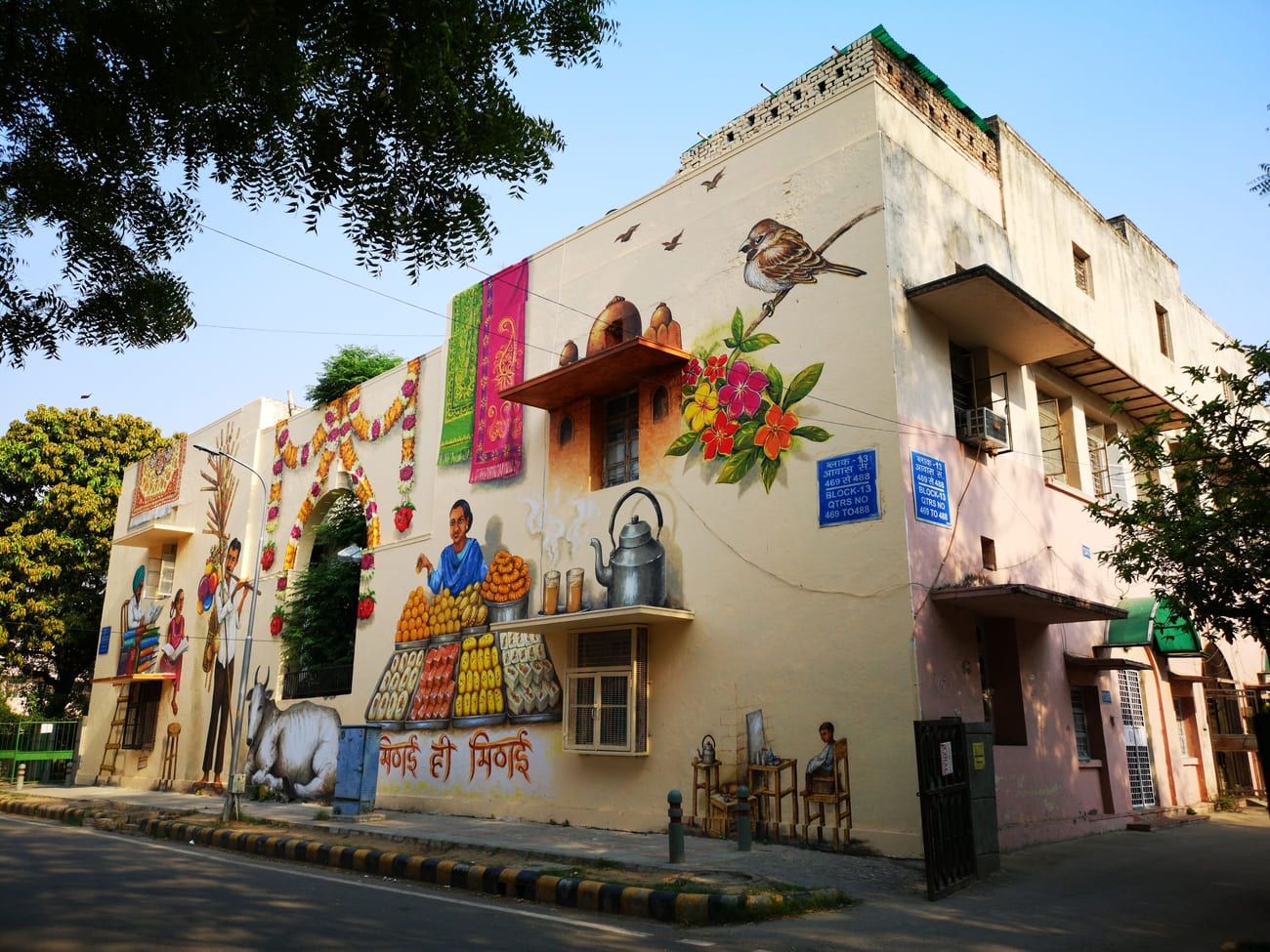
Street art in the Lodhi colony of Delhi © Jean Claude Toung Cheong

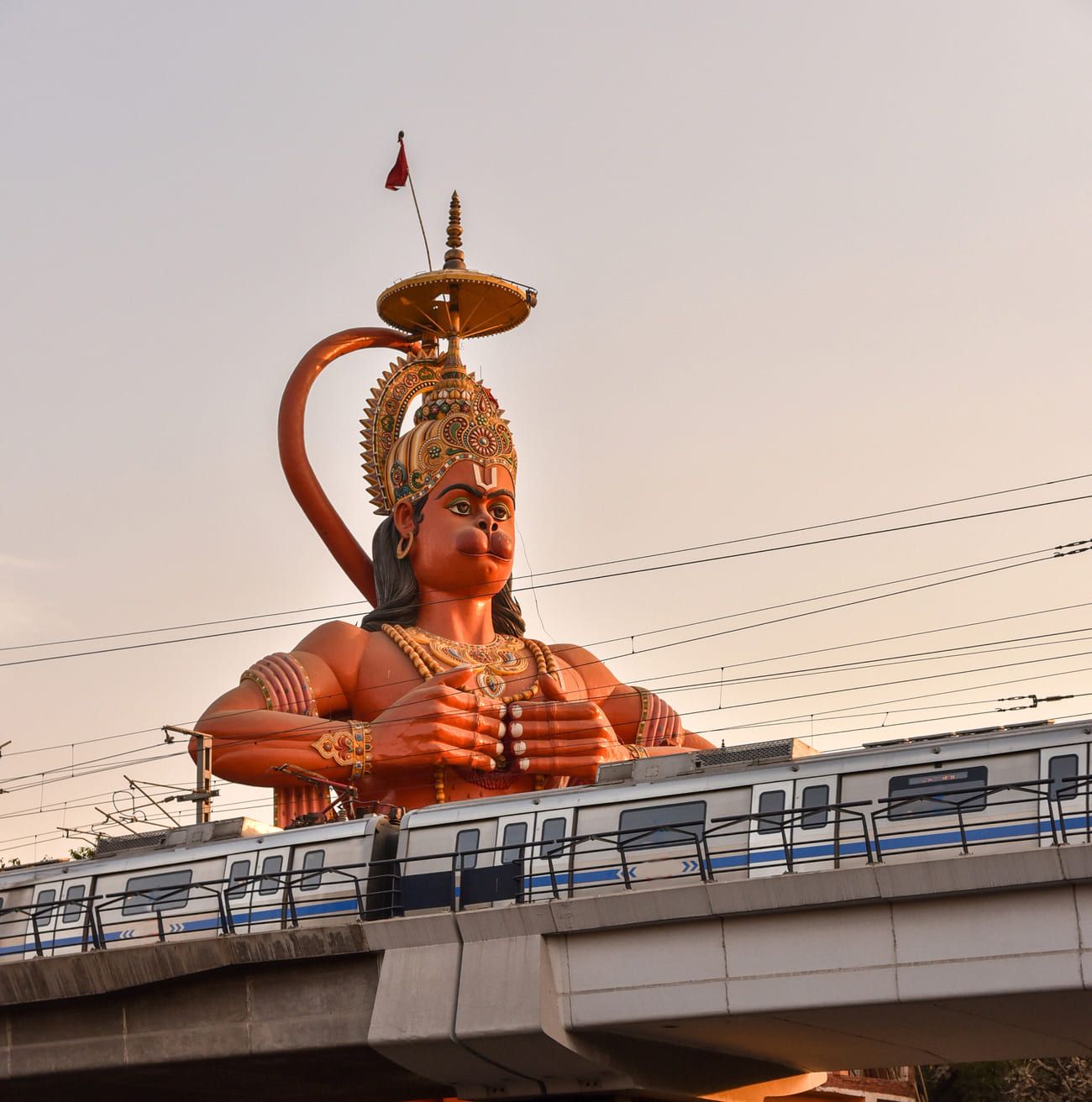

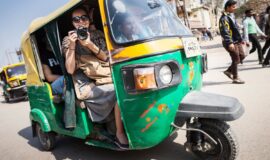



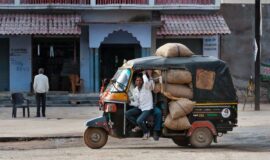
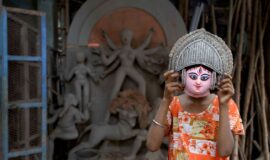

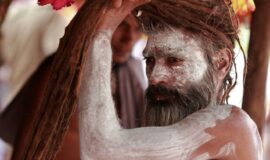
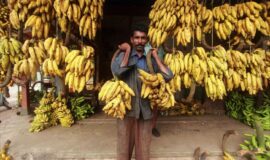

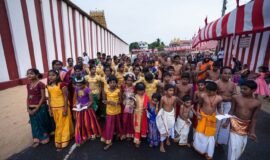


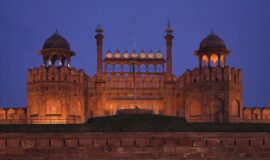
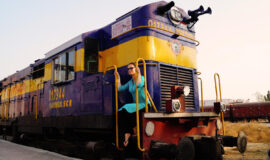
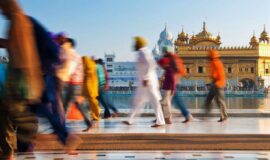
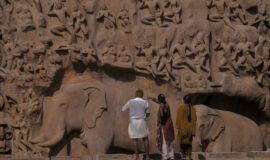
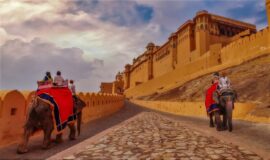
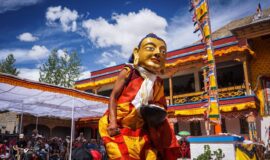

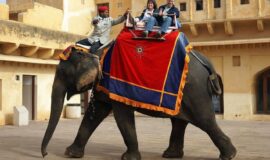

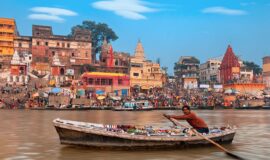

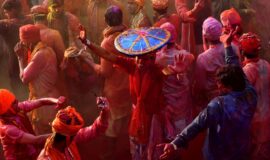
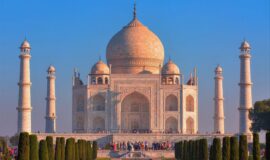
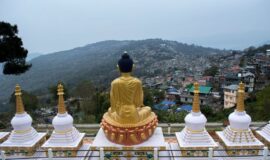
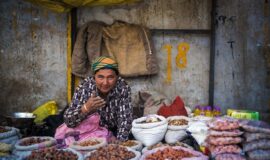
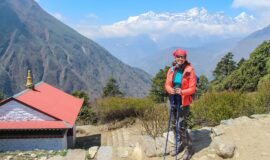
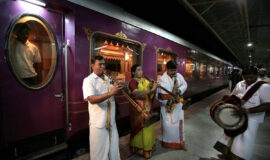
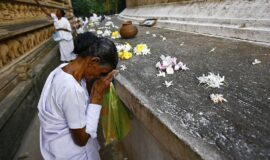
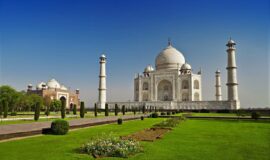
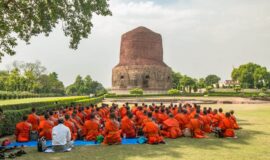
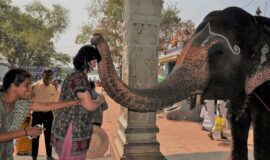



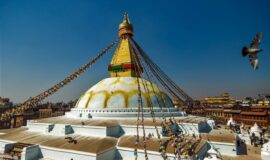

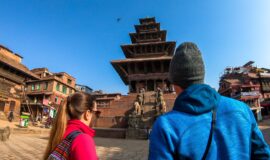
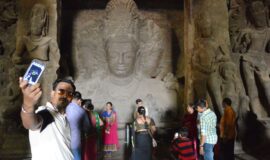
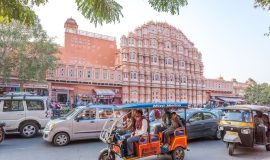



![Golden Triangle Tour with Goa [Culture + Beach Vacation] (12 days) Golden Triangle Tour with Goa [Culture + Beach Vacation] (12 days)](https://www.vacationindia.com/wp-content/uploads/2022/06/golden-triangle-tour-with-beach-vacation-270x160.jpg)
